
- Destinations

15 Best Kayak Camping Trips & Places To Go 2024
Are you considering giving kayak camping a try but have no idea where to explore? Or maybe you’re an experienced paddler and camper looking for the perfect location for future multi-day adventures.
Either way, I’ve put together the best kayak camping places and trips to go on that cater to different tastes and paddling abilities.
These destinations are perfect for creating those wonderful outdoor memories with friends and families.
Let’s find out.
1. San Juan Islands, Washington
2. koreshan state park, florida, 3. mockhorn island, virginia, 4. eleven point national scenic river, missouri, 5. tomoka state park, florida, 6. klamath river, california, 7. indian river canoe trail, michigan, 8. brunet island state park, wisconsin, 9. green river, utah, 10. lake chelan national recreation area, washington, 11. lake tahoe, california and nevada, 12. french broad river, north carolina, 13. missouri river, montana, 14. main salmon river, idaho, 15. boundary water canoe area wilderness, minnesota, share on pinterest, best kayak camping trips & places to go.
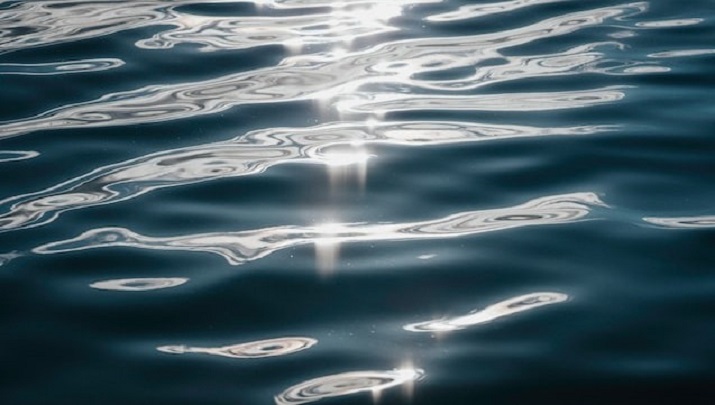
Photo by Toan Chu
Dreamy loops of islands, snow-capped mountains, rocky coastline, sweeping ocean views, spreading greenery, and an abundance of marine wildlife are just some of the reasons why the San Juan Islands are considered a bucket list kayaking destination .
This stunning archipelago was formed by glaciers and volcanoes millions of years ago and currently occupies the cold sea between Canada and Seattle. Whether you’re a beginner or an experienced kayaker, the San Juan Islands are teaming with paddling opportunities to satisfy everyone’s preferences.
You can begin your journey at Friday Harbor and camp at the north or west beach before exploring the wildlife haven that is Lopez Island. On the other end of San Juan Island, you’ll find the historic Roche Harbour, which was once a lime manufacturing town.
This spot is the perfect place to camp if you want to catch whale sightings or add activities like hiking to your itinerary.
Other excellent kayaking camping spots you can check out in the San Juan Islands include Orcas Island, Clark Island, Blind Island, Shaw Island, James Island, Sucia Island, Jones Island, Matia Island, Doe Island, and Patos Island.
As you float down the waterways that make up the San Juan Islands, be on the lookout for seals, orcas, sea lions, bald eagles, and other magnificent animals that have made a home in the area. You can also expect to run into blissfully quiet beaches and campgrounds where you can recoup by the waterside.
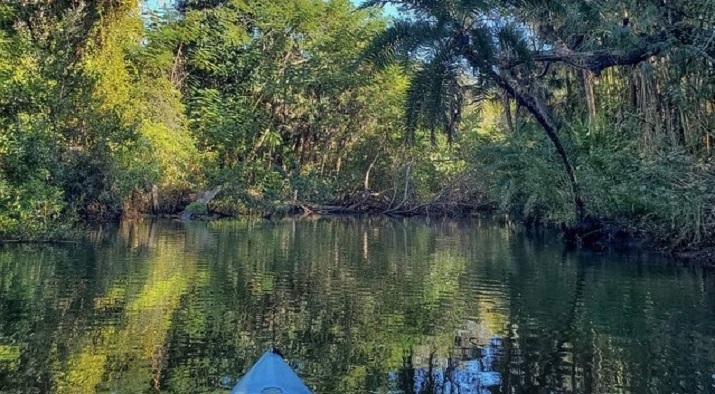
Photo by Michelle Raponi
Looking for a leisurely paddle to soothe your senses and wash away the stress of daily life? Koreshan State Park is one of the best kayak camping spots in the United States.
It is situated close to the Estero River, which was once a pioneer community so you get to travel back in time and peek into the lives of the people who lived by the river banks.
The salty river is not influenced by the tides, so its gentle waters provide a great opportunity for relaxing kayaking explorations.
Koreshan State Park has 60 campsites with running water, fire rings, and picnic tables standing by for visitors who have planned an extended trip. The park has a boat launch where you can kick off your trip by placing your kayak in the water.
You can bring along your own kayak or rent one from the ranger station if transporting your vessel is inconvenient or impractical for you.
To add some more excitement to your trip, you can take hikes, watch the local wildlife, and kayak fish for muskellunge, brown trout, smallmouth bass, striped bass, and largemouth bass.
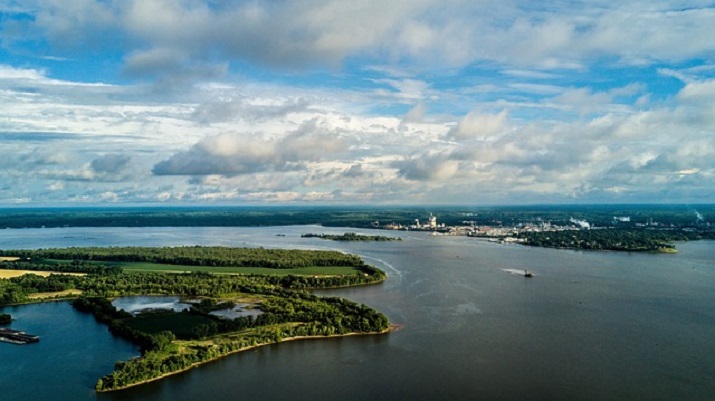
Image by Tim Morrisette from Pixabay
Virginia’s Eastern coast is home to one of the longest expanses of protected and undeveloped shorelines on the Atlantic coast. Mockhorn is one of the barrier islands that dot the Atlantic Coast and it is situated on the southern end of the Delmarva Peninsula.
Unlike some of the other islands that are closed off to the public or only accessible for day use, Mockhorn allows you to camp on the grounds while exploring the waters with your kayak. Primitive camping is free but you have to get a permit beforehand from the Virginia Department of Wildlife Resources.
Mockhorn Island makes for the perfect kayaking camping trip for people who love wildlife sightings and bird watching. You can find egrets and herons nesting in trees and low shrubs, ospreys occupying bays, and an assortment of other shore and seabirds.
Your exploration of this tidal marshland will also reward history lovers with a journey into the past. You can catch glimpses of the water and fire control towers that were used during World War II, as well as the abandoned and dilapidated concrete homesteads erected in the 1920s by the Cushman family.
The splendor of Mockhorn Island is best enjoyed when the tides are low and the island is fully visible, rather than when most of the area is submerged in water from high tides.
The island is also an excellent spot for kayak fishing . So be sure to pack your rod and reel and try your hand at catching some bluefish, flounder, croaker, tarpon, grey trout, black drum, and many other saltwater fishes.
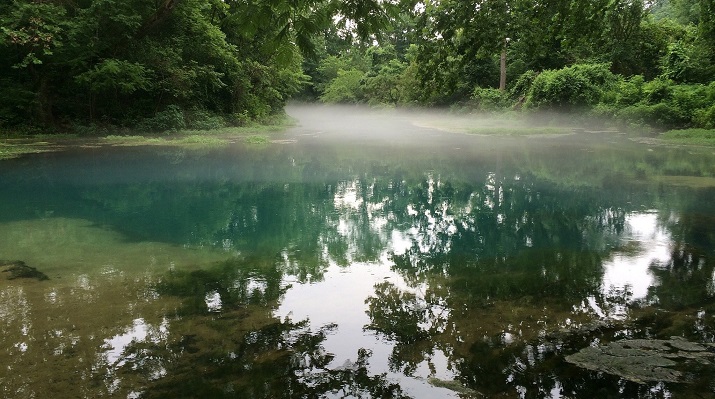
Photo by Jamie E
If you want a less-traveled destination that doesn’t skimp on beauty and excitement, visiting the Eleven Point River is one of the best kayak camping trips you can make.
The Eleven Point River was one of the original eight waterways to be added to the National Wild and Scenic River system in 1968 and it hasn’t lost any of its allure.
The river snakes through the majestic Ozark hills, cutting across forested valleys, steep bluffs, moss-covered boulders, and low-lying riverine ecosystems.
Located in the small country town of Alton, Missouri, the 138-mile River is fed by gorgeous springs and an immense network of underground systems that provide an adequate flow for float trips all year round.
As long as you have the right kayaking clothing and gear, you can go paddling in the Eleven Point River in all seasons. The river is classified as a Class II whitewater river with thrilling, but not too intense, rapids that can be tackled by anyone with minimum water reading skills.
Less experienced paddlers can take advantage of the flatwater pool sections of the Eleven Point River, while those with advanced paddling skills and rescue training can run the river at high water levels for a bigger adrenaline rush.
The Eleven Point River also abounds with trout, pan fish, and smallmouth bass for those who like to go kayak fishing. All you have to do is follow the regulations laid out by the Missouri Department of Conservation .

Photo by Alyssa M
Tomoka State Park is a paddler’s, historian’s, and birdwatcher’s paradise that sits on 900 acres of land. The site was once inhabited by the Timacua Indians of Nocoroco village and later served as a rice and indigo plantation in the late 1700s.
The park draws its name from the Tomoka River and it offers plenty of scenic paddling opportunities for those who like to combine sightseeing with their water expeditions.
You can have a great time exploring the ample paddling trails within the park or seek out more tidal-influenced paddles beyond the park.
The park is home to diverse wildlife, marine mammals, and endangered species such as the West Indian manatee, as well as over 160 bird species. So don’t be surprised if your trip takes longer than expected because you keep stopping to take pictures.
Tomoka River is also rife with fishing opportunities. Florida’s Marine Research Institute has identified over 90 different species of fish in the waters including tarpon, sheepshead, black drum, common snook, red drum, and spotted sea trout.
The park has over 100 full-facility campsites with water, grills, picnic tables, and electric hook-ups for paddlers who want to stay overnight.
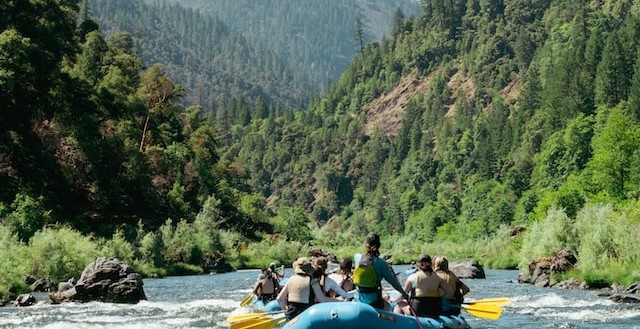
Photo by Megan Nixon
The Klamath River provides a respite from the regular hustle and bustle of California. It’s one of the premier kayaking destinations in the state teeming with opportunities for you to explore warm waters, breathtaking scenery, and memorable waterfront camping.
If you’re interested in navigating challenging rapids and riding big waves, this is the place to go. The Klamath River is also a great entry-level kayak camping trip and it’s kid-friendly too so you can bring the whole family to have some fun on the water and cozy up next to a fire in your camp at the end of the day.
The lower section of the Klamath offers novice kayakers a laid-back pace, while the river’s upper section promises to deliver roiling rapids with Class IV power for those who need an adrenaline boost.
With otters swimming in the water, raptors trailing the sky, and black bears strolling along the riverbanks, the Klamath River is a sight to behold. To get the most out of your trip, plan to visit during the summer season which runs from April to August.
And don’t worry, you don’t need a permit to explore this slice of nature. Just come ready to be amazed and don’t forget your kayak camping gear .
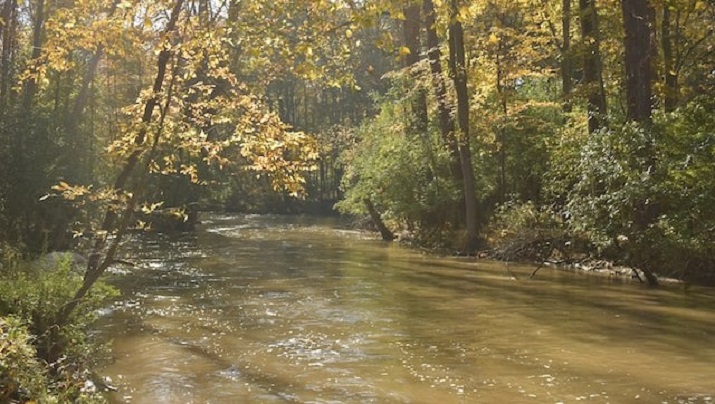
Photo by Laura Baker
Designated a National Wild and Scenic River in 1992, the Indian River boasts a diverse ecosystem, rugged landscape, and breathtaking waterways with pristine water quality that makes it an excellent choice for day paddles and multi-day kayak camping trips.
From vast marshlands to sharp turns, steep and narrow banks, and forested wetlands, the Indian River is full of sights that will engage and impress even the most stoic paddler. The Indian River sits on the Hiawatha National Forest and makes its way through different beautiful settings.
Depending on how long your float trip is, you can expect to encounter a network of connected lakes in the upper sections of the river. The middle section holds a winding channel in a carved valley, leading to a braided channel that feeds Indian Lake.
Plan to arrive after mid-June when the water is calm and smooth-flowing if you’re looking to do some recreational paddling. But if you’re experienced enough to handle high and fast waters, you can visit earlier in the year.
If you pack binoculars and stay on the lookout while paddling about, you might catch sightings of various rare, sensitive, or threatened species that inhabit the area including wolves, ospreys, bald eagles, wood turtles, common loons, and American Martens.
You’ll find the Widewater Campground and many campsites distributed along the river where you can take shelter during your trip.
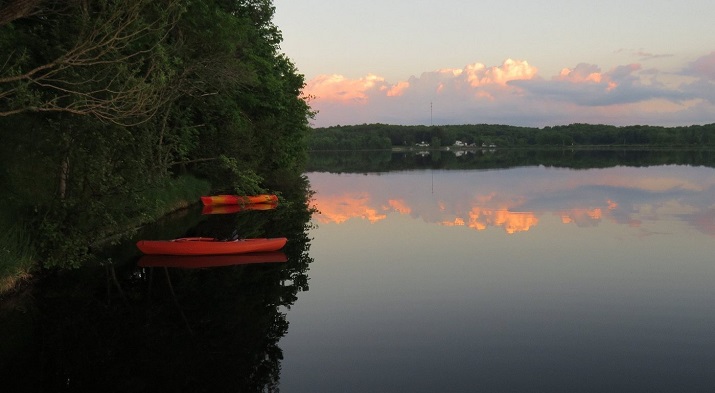
Photo by ElderEagleWatcher
If you want a relaxed paddle in an area with gorgeous scenery and plenty to do other than paddling, a trip to the Brunet Island State Park will check all your boxes.
The park consists of more than 1300 acres of charmingly dramatic landscape brimming with freshwater lagoons and waterways that are perfect for paddling, kayak fishing, and catching glimpses of wildlife. The Chippewa and Fisher Rivers converge at the park.
Spend your days kayaking the quiet waters and getting to know the rugged shoreline either independently or as part of a guided tour group.
You can catch a variety of fishes in the waters around Brunet Island State Park including crappie, walleye, catfish, yellow perch, northern pike, and smallmouth bass.
Brunet Island State Park offers two campgrounds – North and South – for paddlers who want to stay the night.
The majority of campsites in the North campgrounds are a bit primitive and are situated on or near the Chippewa River coastline, so you can paddle in and set up camp at different points in your journey.
However, the South campgrounds offer electricity, shower buildings with flush toilets, and better access for people with disabilities.
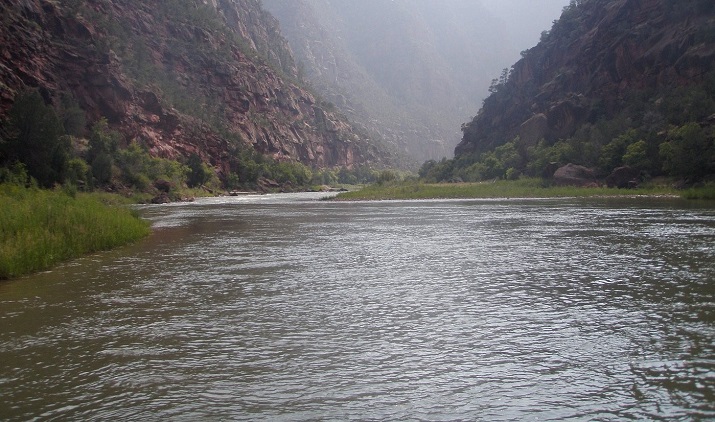
Photo by Scott
Exploring the 120-mile Green River in a kayak is one of those activities that will fill you with renewed wonder and respect for nature.
The river travels through two deep canyons to reveal majestic views of rock formations and calm waters along with some Class III rapids that will get your heart racing.
Whether you opt for a sea kayak , fishing kayak , or recreational kayak , you can make beautiful memories navigating the Green River area.
Paddlers who want a less-beaten path can choose to explore the Stillwater Canyon, launching from Mineral Bottom and traveling past vistas of red mesas to get to the landing site at Spanish Bottom.
Alternatively, you can launch from the Green River State Park and head for Labyrinth Canyon if you want an amped-up experience.
For camping, Green River offers 32 campsites scattered along the shore, but you’ll need to make reservations weeks before your trip to secure a spot.
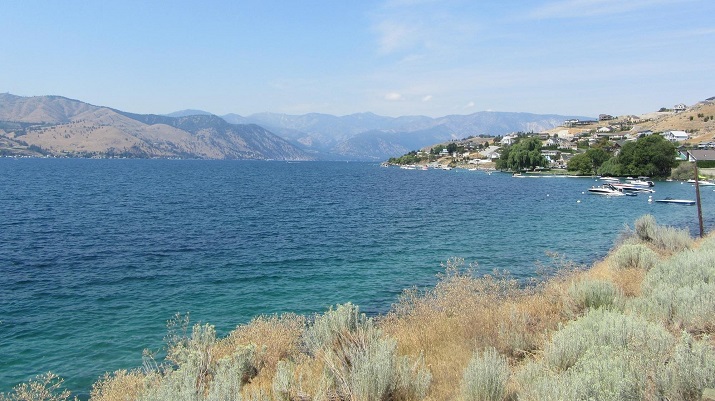
Photo by Relayer
With over fifty miles of coastline stretching through the North Cascades, the idyllic Lake Chelan is a lovely spot for your next kayak camping trip.
Lake Chelan is a narrow waterway fashioned by a glacier during the last Ice Age and the second largest body of freshwater on the west coast.
Lake Chelan’s clear, blue waters have lots of spirit and excitement to offer both the recreational paddler and the water sports expert. Bring your own kayak or rent one that suits your needs at any of the local vendors near the boat launches.
To get to the original point of Lake Chelan in Stehekin village, you’ll need to take a ferry or make your way by foot. You can paddle different sections of the lake on a day trip or explore the full length of the lake in a multi-day trip lasting six to seven days.
Additionally, there are many smaller lakes and channels near Lake Chelan that you can explore. Don’t forget to pack your swimwear because you might not be able to resist taking a dip in the lake, especially if you visit during the summer.
After an exciting day of paddling, you can rest your bones, cook a delicious meal, or feast on the float trip food you brought with you at one of the 25 campsites situated around Lake Chelan’s shore.
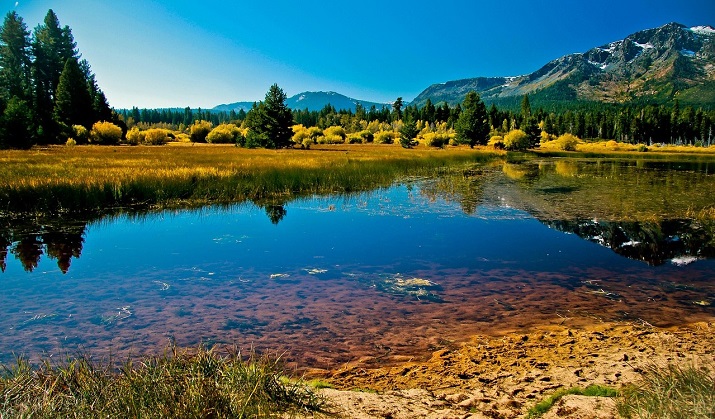
Photo by Jody Summers
Lake Tahoe is the largest freshwater lake in the Sierra Nevada, as well as one of the bluest and most transparent waters in the world.
The sheer beauty of the scenery, gorgeous sandy beaches, and swarms of colorful fishes alone are worth a trip to this magnificent pocket of nature.
There are few places to go kayak camping that are as perfect as the 72-mile water trail of Lake Tahoe. However, because it’s a high alpine lake, you need to be conscious of winds, weather, and mountain conditions when paddling because they can turn on a dime.
There are many launch sites that you can use to access Lake Tahoe including Kiva Beach, Timber Cove, Lakeview Commons, Regan Beach, Zephyr Cove, and Camp Richardson. The route also features wayfinding signage, navigation tools, landing sites, water safety tips, and paddle paths to suit your interests and skill level.
Although you can experience water activities on Lake Tahoe all year long, the best time to visit is during the summer months when the water is at its warmest. But if you want to avoid the rush of tourists, time your visit for the spring or fall season.
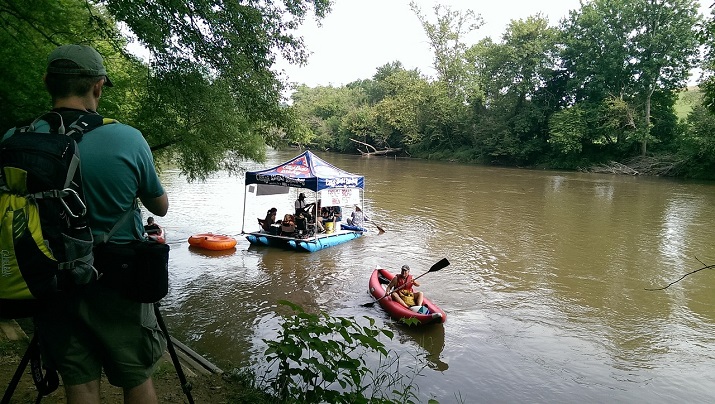
Photo by Tommy Green
Are you planning your next Kayak Camping adventure? Take a trip to the 218-mile-long French Broad River nestled in North Carolina’s Blue Ridge Mountains and flowing all the way to Douglas Lake, Tennessee.
The French Broad River is part of the Tennessee River Valley System and it is considered the third oldest river in the world. Whether you’re looking to do some recreational paddling, go chasing after hard-core whitewater rapids , or put your intermediate skills to the test, the French Broad River is accessible to all kayakers.
Taking off from Rosman, North Carolina you can wade through flat and whitewater all the way up to Douglas, Tennessee, stopping at campsites to rest along the way.
If you’re new to kayaking, the Brevard, Bent Creek, and Hominy Creek sections of the French Broad offer calm sections of the river that you can paddle with ease.
More experienced paddlers can head for the sections north of Woodfin, while advanced kayakers can tackle Class V rapids in the Courthouse Falls, North Fork, and West Fork areas. You can paddle the entire scenic stretch of the river in a 10-day trip.
The French Broad River has a network of private low-cost campgrounds that you can reserve ahead of time spread out every eight to ten miles along the trail. But if you can’t get a reservation, you can always rely on the public unreserved campsites in the area.
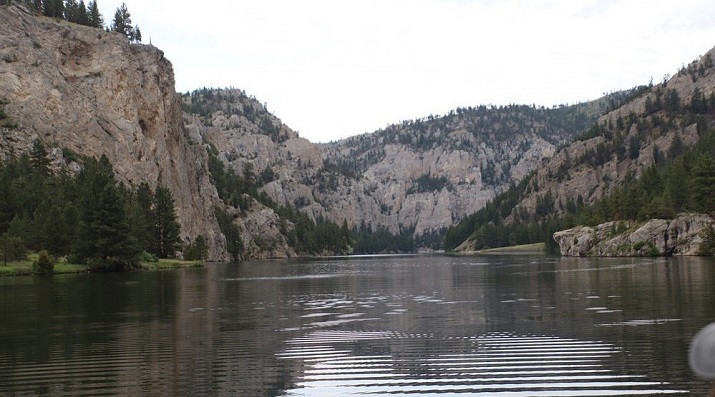
Photo by Robby G.C
Paddling the “Mighty Mo” as the Missouri River is fondly called by natives, should be on the bucket list of any serious kayaker looking for a thrilling and challenging adventure. Missouri
Although there are no rapids to tackle, shifting sandbars, changing wind conditions, and strong currents add interesting hurdles and intensity to the prospect of paddling the Missouri River.
The dynamic landscape makes each trip unique so that you’re never quite taking the same trip twice even when paddling the same route.
Beginners and intermediate paddlers who wish to explore the Missouri River will want to use a guide service or join a group tour led by a paddler who is familiar with the waters.
It takes about 10 days to paddle the entire length of the river, but if you have fewer days to spare for the trip you can spend three days tackling the 47-mile route stretching from Coal Banks to Judith Landing.
Although there are a few public campgrounds along the Missouri River banks, primitive camping is usually permitted on sandbars and islands.
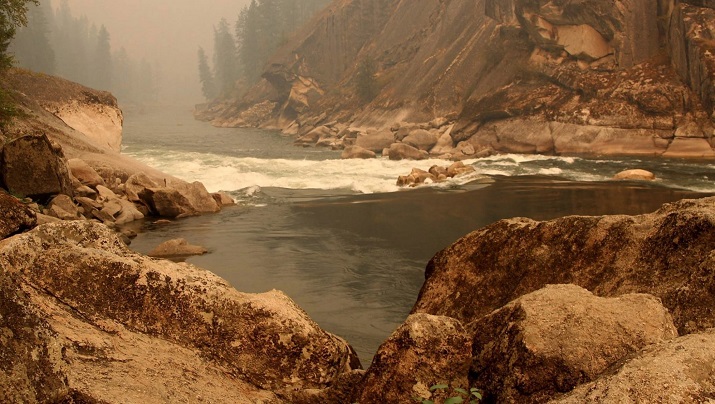
Photo by Phormio18
The Main Salmon River is another great destination for kayak camping trips for those who are looking for a challenge. This spot offers Class III rapids, deep canyons, and fierce water flows that will leave you tingling and gasping for air at the end of the day.
Also known as the ”˜river of no return’ due to its fast-flowing nature and rapids which make it challenging to paddle back up, the Salmon River is not for the less experienced paddlers. However, if you belong to this category, you can still make the trip as long as you bring along a seasoned paddler to guide you.
Whatever route you take will bring you across seemingly endless fir trees, otters, moose, black bears, and bighorn sheep. You can also camp on one of the many riverbank beaches.
The Main Salmon River runs through the Sawtooth Mountains and the over 2,000,000-square-mile Sawtooth National Forest. It will take several multi-day trips to cover the length of it, so there are plenty of reasons to keep coming back.
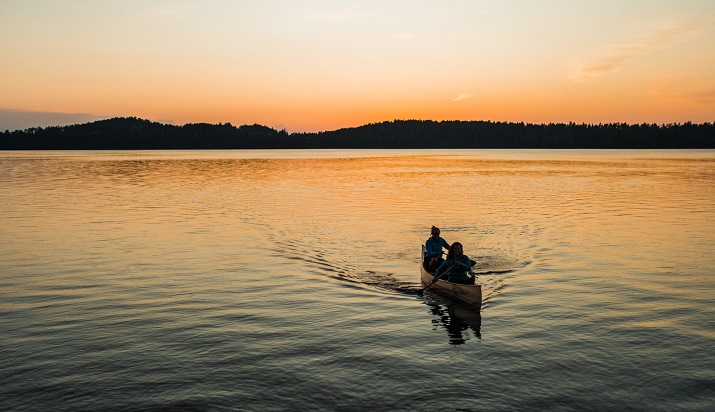
Photo by Lee Vue
Consisting of over 1,000,000 acres of remote and rugged coniferous forests, the Boundary Water Canoe Area Wilderness is one of the most visited areas/paddling destinations in the country. It’s ideal for paddlers who are seeking risk, thrill, adventure, and solitude in one package.
The Boundary Water Canoe Area Wilderness features more than 1,200 miles of canoe and kayaking routes, over 2,000 designated campsites, and a dozen hiking trails in case you want to go exploring on foot.
The wilderness forms the aquatic border with Canada in Northern Minnesota and lies adjacent to LA Verendrye and Quetico Provincial Parks. It is made up of rocky landforms, islands, lakes, streams, and other water bodies that give you a chance to experience long-distance watercraft trips.
You can explore the area for several weeks without using the same campsite twice. That’s how massive the Boundary Water Wilderness is.
However, regardless of your reason for visiting the area or how long you intend to spend there, you’re going to need a permit so make sure you reserve or pick one up before the start of your trip.
Kayak camping is a great way to explore the great outdoors and extend your paddling adventure.
I hope this list of memorable spots will inspire you to plan your kayaking and camping trip.
Enjoyed Best Kayak Camping Trips & Places To Go? Â Share it with your friends so they too can follow the Kayakhelp journey.
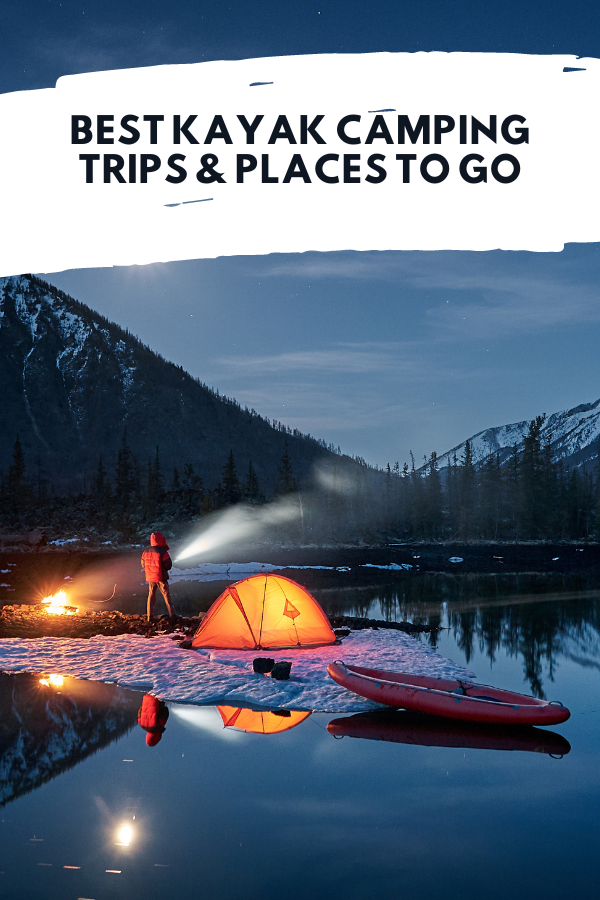
Peter Salisbury
Pete is the Owner of KayakHelp.com. Born and raised in Cleveland, Ohio, he grew up kayaking, fishing, sailing, and partaking in outdoor adventures around the Great Lakes. When he’s not out on the water, you can find him skiing in the mountains, reading his favorite books, and spending time with his family.
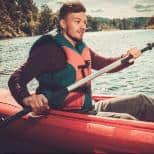
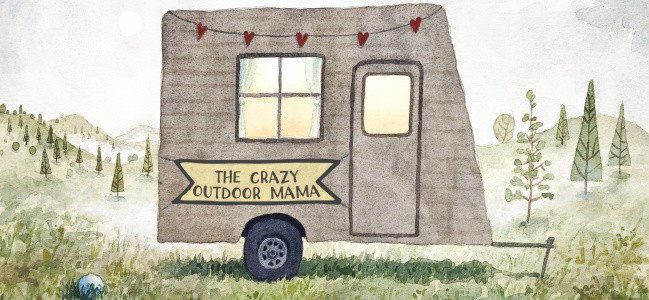
The Ultimate Guide to Your First Kayak Camping Trip (+Packing List)
Rv camping… check. Tent camping…check. Backpacking…check. Kayak camping… hmmmm, not yet. If you’ve never gone kayak camping, it’s time for a new adventure. The cool waters and remote river islands are beckoning, so grab your paddles and let’s go!
Not so fast…
First, you need to read through this ultimate guide for camping with kayaks (if you’re a canoe family, don’t worry, almost everything in this kayak camping guide also applies for canoe camping).
In this guide, you’ll learn everything you need to know to plan your first kayak camping trip. Here’s what I’ll cover:
- Essential kayak camping gear
- Pro tips for planning your trip
- How and what to pack on your kayak
- List of kayak camping essentials you don’t want to forget
Let’s get started!
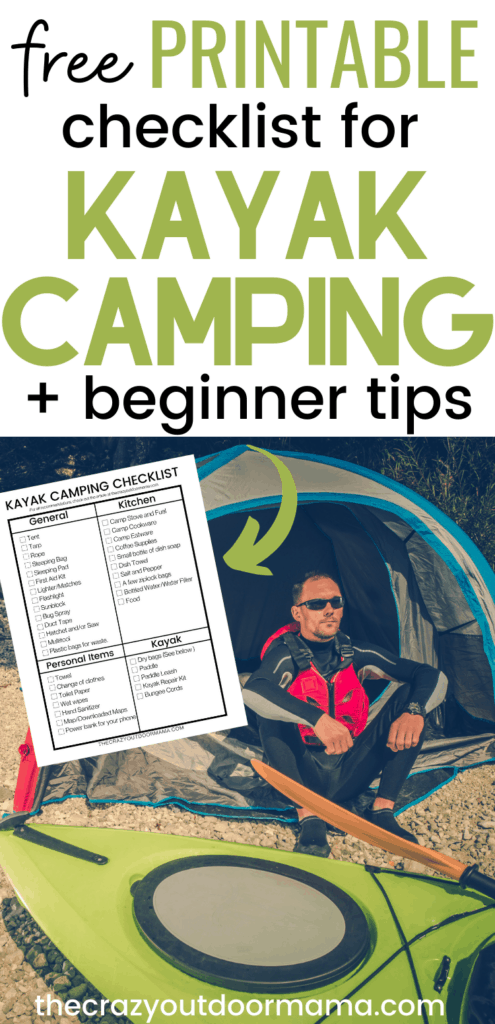
Table of Contents
Why would anyone want to go camping with kayaks?
Camping by kayak – sounds kind of intimidating, right? Where am I gonna carry all my stuff? What if I don’t find a campsite? What if I flip my kayak? (Cause y’all know that’s gonna happen at least once.)
But if you think about it, using kayaks to camp isn’t much different from normal backpacking. You use a lot of the same gear and kayak camping even has some advantages over backpacking.
With backpacking, you have to carry everything yourself which can get really tiring, really fast. But guess what? On a kayak camping trip, your trusty kayak does most of the work! You can even pack more gear when you’re kayak camping since weight isn’t as much of an issue.
(No don’t go grabbing your mini generators and espresso machines just yet, you still need to pack carefully. We’ll see more about that later.)
And when you’re backpacking, you know you’ll complain about sore feet at least once during the trip. But with kayak camping, you can sit back, relax, and enjoy the view – no blisters necessary.
So there’s no need to feel overly intimidated. A lot of this you can plan just like a normal camping trip.
But what about the kayak-specific parts? Keep reading and I’ll give you some useful tips so you can launch your kayaks with confidence!
Basic Tips For Planning your First Kayak Camping Trip
- Planning Your Route
Before you start plotting destinations, make a rough calculation of how far you can paddle in a day. While experienced paddlers may be able to cover 15-20 miles in one day, most of us should plan for a lot less.
If you’re on a lake or slow-moving river and have basic experience handling a kayak, you could probably average two miles per hour. So a 10-mile day will give you plenty of time to break for lunch, rest, and explore a little.
If it’s your first overnight trip, you’ll probably want to ease into it. Just go for a night or two and don’t try to cover too many miles.
Be sure to plan your first kayak trip on calm waters and of course check the weather before you go. Rivers can get dangerous with heavy rainfall and paddling in the rain is just miserable.
*Route Planning Tip – Search online for water trail maps of the area you want to visit. A lot of parks offer maps for paddlers with premarked campsites/campgrounds and other cool landmarks. For example, here’s a cool site with awesome info for kayak, canoe, and SUP trips on Lake Tahoe and a guide to some of the Best Kayak Camping Trips for First Time Kayak Campers .
And last but not least, don’t forget to plan your exit route .
- What To Pack
It’s not as hard as you think. Most of the gear you use for backpacking trips can also be used for kayak camping – except your big stinky hiking boots. Leave ‘em at home ‘cause all you need are some good water shoes. (A little later I’ll give you two great options for good water shoes for kayak camping.)
Although you can pack a bit more than when you go backpacking, it’s still nice to have things like a tent, cook set, sleeping bag, camp stove, and other gear that’s lightweight and doesn’t take up a lot of space.
But because you’re out on the water, there are a few extra things you’ll need to get to make your trip a success. Don’t worry, later on in this guide, I’ll give you a list of all the essential kayak camping gear you need to pack so you don’t forget anything.
A safe trip is a fun trip. So as you’re planning, keep these basic kayaking safety tips in mind.
- Make sure you include a first aid kit in your camping gear.
- Get comfortable life vests that are easy to wear all day (especially if you’re going with the kiddos).
- Plan your route carefully to avoid whitewater rapids or rough sections of the river.
- Always have a way to contact someone if you need help.
- Bring plenty of sun protection.
- Tell a friend or family member that you’re going kayak camping and give them a map of your planned route. (Make sure it’s someone who doesn’t like camping so they’re not bummed you didn’t invite them.)
Ok, so you’ve got some of the basics down. Now let’s move on to the nitty-gritty.
Essential Kayak Camping Gear
Almost any kayak can work for kayak camping. However, some types are better suited to certain people or types of camping excursions. Let’s look at the two basic types of kayaks: sit-on-top and sit-inside. Although both work well for camping trips, they each have advantages and disadvantages.
S it-on-Top Kayak Pros:
A sit-on-top kayak for camping is best for new kayakers and fun-focused camping trips with your family.
They’re stable and easy to use. Plus, they’re great if you want to get off your kayak in the middle of the river to cool off. And even if you fall off or flip the kayak in deep water, just flip it back over and wriggle yourself back on – it won’t be a pretty sight but you can do it.
Sit-on-Top Kayak Cons:
If you’re kayaking in cooler weather, sit-on-top kayaks aren’t the best choice. Since you’re sitting on top (duh!), it’s much easier to get wet. That’s fine when it’s 90 degrees out and sunny, but when it’s a brisk 50 degrees and you’re paddling in cold river water, it’s not as pleasant.
Some sit-on-tops don’t have waterproof hatches where you can store your gear. This isn’t’ necessarily a deal-breaker though. Most do have places where you can easily strap on your kayaking gear and with the right dry bags , you don’t have to worry as much about having a waterproof hatch.
*Get more specifics about using a sit-on-top kayak for camping here .
Sit-In Kayak Pros:
Sit-in kayaks are much better for cooler weather . Your lower body is protected from the cold wind and it’s harder for your lower body to get wet.
If you want to take longer trips and cover more ground (I mean… water), you can find sit-in touring kayaks that are better suited to longer kayak camping adventures. They have a more streamlined shape and additional places to safely stow your gear.
Sit-In Kayak Cons:
With sit-in kayaks, you don’t have as much freedom to get in and out of the water. And if you do happen to flip the kayak and fall out in deep water (pfff..like that’s ever gonna happen), it can be really difficult to flip it back over, get all the water out, and get back in.
**If you want more help choosing your kayak check out my list of the 8 Best Kayaks for Your First Kayak Camping Trip .
We’ve covered the most important piece of equipment, your kayak. Keep going to see some more essential gear you shouldn’t forget.
What to Bring Kayak Camping (and your free printable kayak camping checklist!)
Without further ado, here’s the checklist of essential gear for kayak camping . Depending on your needs, there may be some more stuff you’ll want to add to the list, but these are the things you especially don’t want to forget.
Click on this link to be brought to the PDF of this kayak camping checklist!
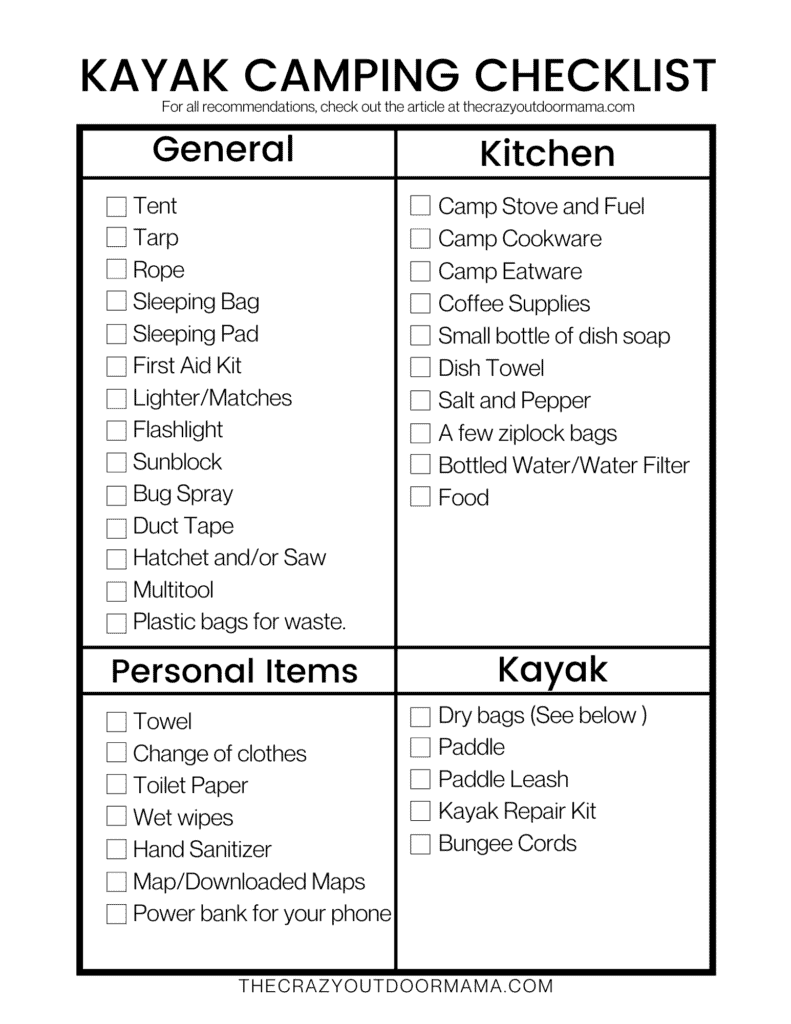
General Camping Gear
- Sleeping Bag
- Sleeping Pad
- First Aid Kit
- Lighter/Matches (Or your favorite two sticks to rub together)
- Duct Tape (You should really have duct tape with you like 24/7, all the time, everywhere you go. That’s just good life advice.)
- Hatchet and/or Saw
- A few plastic bags for dirty clothes, garbage, etc.
Camp Kitchen
- Camp Stove and Fuel (The Solo Stove Lite is a great option!)
- Camp Cookware
- Camp Eatware
- Stuff for Coffee
- Small bottle of dish soap
- Salt and Pepper
- A few ziplock bags
- Bottled Water or a Water Filter
Check out my article Camp Cooking for Kayakers – Your Kayak Camping Kitchen Guide to get some ideas for what food to pack and a few simple recipes!
Personal Items
- Change of clothes
- Toilet Paper (For those of us who aren’t outdoorsy enough to use just leaves)
- Wet wipes (If you really want to feel like you’re glamping!)
- Hand Sanitizer
- Map (If you’re going old-school) or a smartphone with downloaded maps
- Power bank for your phone
Kayak Specific Gear
- Dry bags (See more about these below)
- Paddle Leash
Kayak Repair Kit
- Bungee Cords
A Few Simple Things That Will Make Your Kayaking Trip Easier
Here are a few simple gear items that you might not think about when packing, but will make your life a whole lot easier while you’re on your kayaking trip.
Dry bags are a no-brainer. They’re made from waterproof materials and have special closures that keep water from getting in. And ff you’ll be using your phone for navigating, be sure to get a small waterproof pouch with a strap that lets you see your phone while keeping it protected.
Here are some great options if you need to get some dry bags.
- Earth Pak Waterproof Dry Bag

-This one is a basic dry bag that comes in several sizes plus a bonus phone pouch.
2. Eark Pak Waterproof Duffel Bag

Perfect for when you have a lot of stuff to pack.
3. Yeti Waterproof and Submersible Bags

These are the last waterproof bags you’ll ever need to buy. Loops on the outside make it easy to strap on your kayak. Drag ‘em over rocks, rapids, sticks, and more – they like it rough.
Check out my DRY BAG GUIDE .
Sunglass Tether
River beds are filled with sunglasses that have been lost on kayaking and canoeing trips. You’ll be in for a day or two of intense squinting if you lose your glasses in the water.
A strap like this Ukes Premium Sunglass Strap is comfortable and even floats so if your sunglasses do end up in the water, you might actually have a chance of retrieving them.
A small crack or puncture can quickly ruin your kayak camping trip, especially if you’re far from civilization. So make sure to have a basic repair kit on hand. They’re lightweight, inexpensive, and can help get you out of some sticky situations.
Here are two useful kits to bring along.
- Epoxy Putty Stick
- West System Plastic Repair Kit
Good Water Shoes
These are worth their weight in gold. Sure you could go with just flip flops, but have you ever tried pulling a kayak up a muddy riverbank in flip flops? It’s not pretty, believe me.
For a kayaking camping trip, look for something that’s halfway between a traditional water shoe and a hiking sneaker. Here are two great options.
Mishansha Quick Dry Water Shoes
Merrell All Out Blaze Sieve
Comfy Kayak Seat
Some kayaks already come with a seat, but upgrading to get a little extra cushion under your bum and a touch of back support makes your days in the kayak a lot more enjoyable.
Here are two good options that’ll work on most kayaks.
Skwoosh Expedition Kayak Seat

WOOWAVE Padded Kayak Seat

Time to Pack Your Kayak
So now you’ve got everything on your list. You double-checked it twice. It’s time for your dry-run.
Skipping this step is likely to end up in a very embarrassing moment at the boat launch where you realize you can’t actually fit all your stuff in your kayaks.
So before your trip, take your kayaks and all your kayak camping supplies out in the backyard and figure out how you’re going to pack it all.
Check out this video and my article on How to Pack Kayaks for some more detailed tips for prepping your kayak for your camping trip.
A couple of things to remember:
- Keep things like bottled water, snacks, first aid kits, and navigation equipment in an easily accessible place that you can reach while paddling.
- Make sure everything that needs to stay dry is either in dry bags or a waterproof compartment.
- Try to distribute the weight evenly from front to back and side to side.
- Make sure that dry bags and everything that’s not in a compartment is strapped down so if you happen to flip you won’t use your gear.
Ready to Go?
There you go, you’ve got everything you need to plan your first canoe or kayak camping trip! Once you plan your route, get everything on your list, fit it all on your kayaks, and finally make it out on the water, don’t forget to HAVE FUN!
Splash each other with your paddles, belt out some campfire songs , and enjoy a peaceful cup of early morning coffee by the river.
Looking for some more kayak camping inspiration?
And check out my other kayak camping articles:
12 Best Kayak Trailers for Easy Kayak Transportation
KAYAK CAMPING DESTINATIONS – 5 OF THE BEST PLACES FOR YOUR FIRST OVERNIGHT KAYAK TRIP
CAMP COOKING FOR KAYAKERS | YOUR KAYAK CAMPING KITCHEN GUIDE
HOW TO PACK YOUR KAYAK FOR A CAMPING TRIP – COMPLETE GUIDE + BONUS PACKING LIST
8 BEST KAYAKS FOR YOUR FIRST KAYAK CAMPING TRIP – COMPLETE GUIDE
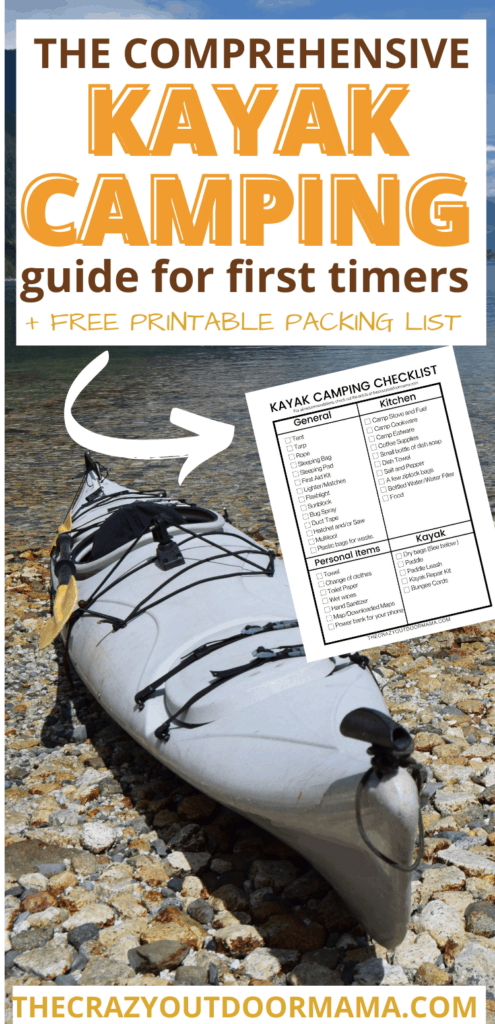
- Latest Posts
- Solar Eclipse 2024 Kids Printable Activity Pack! - April 8, 2024
- 11 RV Bathroom Makeovers to Inspire You! - April 7, 2024
- 13 Dreamy Hammock Camping Set Up Ideas + Pics - February 22, 2024
1 thought on “The Ultimate Guide to Your First Kayak Camping Trip (+Packing List)”
Thanks chancing from a canoe to a kayak is a littel scarrey. YOUR help will gide me to a better transition. One item you forgot in your repair kit is TWO ROLS OF DNever leave shour with out it.
Leave a Comment Cancel reply
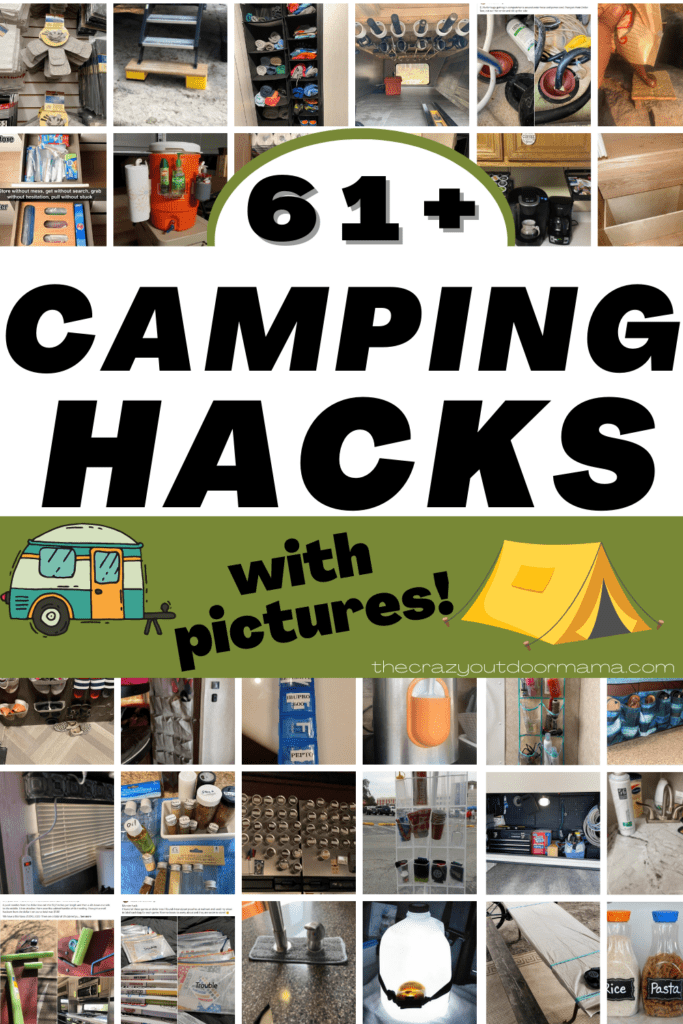
HI! I'm Stacy, AKA “The Crazy Outdoor Mama”
I'm the voice behind the website, and I hope you've found what you needed! I'm an outdoorsy married mother of three from Wyoming, and I LOVE creating resources that make camping and other outdoor activities easier!
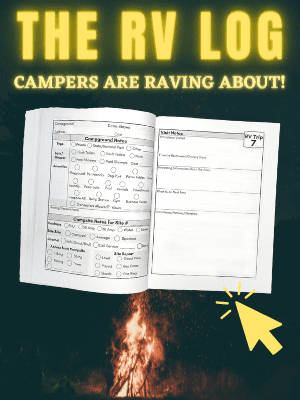

- Gear Directory
- Multihull Sailor
- Boats for Sale
- Real Estate
- Maintenance & Hardware
- Water Sports
Kayak Camping: A Beginner’s Guide and Packing List
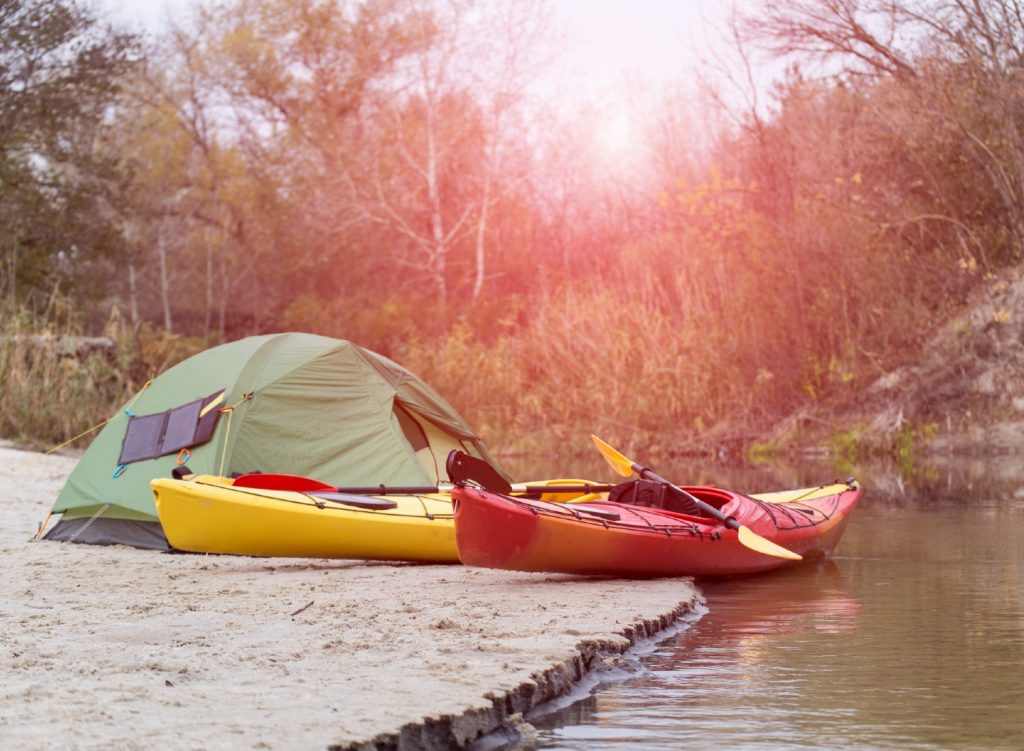
- 1 What is Kayak Camping?
- 2 Planning Your Kayak Camping Trip
- 3 Choose a suitable location
- 4 Check the weather forecast
- 5 Research campsites
- 6 Plan your route
- 7 Get the necessary permits
- 8 Essential Gear for Kayak Camping
- 9 Kayaking Gear
- 10 Camping Gear
- 11 Additional Tips and Tricks
- 12 Conclusion
Related Posts
If you love the great outdoors but are tired of traditional camping, why not try kayak camping? This exciting activity combines the best of both worlds—exploring picturesque waterways while also spending a night in the wilderness.
But if you’ve never been kayak camping before, it can seem like an overwhelming task. Where do you start? What gear do you need? Don’t worry, we’ve got you covered. In this guide, we’ll walk you through everything you need to know to plan and pack for your first kayak camping adventure.
What is Kayak Camping?
Kayak camping, also known as kayak touring or sea kayaking, involves traveling and camping by kayak. In simple terms, it’s like backpacking on water. Instead of hiking with a heavy pack on your back, you’ll be paddling with all your gear stowed in your kayak.
Kayak camping allows you to access secluded campsites that are only reachable by water. It also gives you a unique perspective of the surrounding nature, as you’ll be gliding quietly along the water, away from busy roads and hiking trails.
Planning Your Kayak Camping Trip
Before you start packing your gear, it’s important to plan your kayak camping trip properly. Here are some things to consider:
Choose a suitable location
When picking a destination for your first kayak camping trip, choose an area with calm waters and beginner-friendly conditions. Rivers, lakes, and coastal areas are great options.
Check the weather forecast
Weather plays a crucial role in any outdoor activity. Check the forecast before you head out and be prepared to change your plans if necessary.
Research campsites
Look for designated kayak camping sites in your chosen location. These will usually have amenities such as toilets and fire pits, making your trip more comfortable.
Plan your route
How long do you want to paddle each day? Are there any potential hazards or portages along the way? Plan out your route before you leave so that you know what to expect.
Get the necessary permits
Some kayak camping locations may require permits. Make sure you have all the necessary paperwork before you set off.
Essential Gear for Kayak Camping
Packing for a kayak camping trip can be challenging, as space is limited and weight is a concern. Here are some essential items that every beginner should bring on their first trip:
Kayaking Gear
- Kayak : The most important piece of gear. You can either buy or rent a kayak, but make sure it’s suitable for your skill level and the type of water you’ll be paddling on.
- Paddle : Your kayak paddle should be lightweight and easy to grip. Make sure it’s the right size for you, as using a paddle that’s too long or short can make paddling more difficult.
- Lifejacket : You should never go kayaking without a lifejacket. Look for one with a comfortable fit and enough buoyancy to keep you afloat in case of an emergency.
- Spray skirt (optional) : If you’re kayaking on rougher waters, a kayak spray skirt can protect you from getting wet. However, it’s not necessary for calmer conditions.
Camping Gear
- Tent : You’ll need a tent that is compact and easy to set up since space is limited on your kayak. A backpacking or lightweight tent works well for kayak camping.
- Sleeping gear : A sleeping bag and sleeping pad will keep you warm and comfortable while sleeping on the ground.
- Cooking equipment : Don’t forget to bring a small stove, fuel, and cooking utensils. You can also pack dehydrated meals or easy-to-cook foods like pasta for quick and convenient meals.
- Clothing : Pack clothes that are suitable for the weather conditions of your chosen location. It’s best to bring layers, as temperatures can change quickly when you’re out on the water.
- Waterproof bags : To keep your gear dry, pack it in waterproof bags or dry bags. These are essential for any kayak camping trip.
Additional Tips and Tricks
Here are some additional tips to help ensure a successful and enjoyable kayak camping trip:
- Keep safety in mind at all times. Wear your lifejacket , stay hydrated, stay close to shore, and avoid paddling in risky conditions.
- Check the weight capacity of your kayak before packing. Overloading your kayak can make it unstable and difficult to paddle.
- Opt for a fishing kayak if you enjoy fishing. It’s a great way to relax while camping on the water.
- Don’t forget to pack a first-aid kit and know how to use it.
- Leave no trace. Make sure you bring all your garbage with you and leave the campsite as clean as you found it.
Kayak camping is an exciting way to experience the great outdoors. With proper planning and essential gear, even beginners can enjoy this unique adventure. So why not give it a try on your next camping trip? You might just fall in love with the tranquility and beauty of kayak camping.
Article Contributors
Sail magazine review team.
SAIL Magazine Review Team reports on best-selling products in sailing and boating. The SAIL Magazine editorial staff is not involved in the creation of this content. SAIL Magazine is reader-supported: When you buy through links on our site, we may earn an affiliate commission. The SAIL Review Team is composed of authors, editors, and sailors. Artificial Intelligence (large language models) may have been used in the research and creation of the content.
To ensure questions about product testing or a specific article are addressed, please contact [email protected]
How To Plan A Kayak Camping Trip – Planning, Packing And Gear Tips!
March 14, 2024
Founder, Kayaking & Paddle Boarding Expert
Sam is the founder and editor of WaterSportsWhiz. With over 20 years of experience across various water sports, he provides trusted reviews and expert advice to help others pursue their passion for getting out on the water. When not working, you can find him kayaking, paddle boarding, or planning his next water-based adventure with family and friends.
Reviewed by: Nessa Hopkins
Nessa Hopkins
ACA-Certified Kayaking Instructor
Vanessa is a certified kayaking instructor, has taught over 500 people how to kayak, and is a senior member of the American Canoe Association. By combining her deep understanding of the sport and a background in journalism, she offers a wealth of experience and expertise to our growing water sports community, promising to educate and inspire paddlers of all levels.
Read Our Editorial Guidelines

For first-time kayak campers, the appeal is obvious. Paddling through breathtaking scenery by day and sleeping under the stars at night. Yet the key to making this outdoor vision a reality is thoughtful preparation. Without proper planning, your trip could quickly sink from paradise to disappointment.
The good news? With smart planning, your kayaking camping adventure can be fun, safe, and hassle-free.
This guide includes pro tips on critical factors like
- Choosing a beginner-friendly location.
- Planning your route and daily mileage.
- What to look for when selecting a campsite.
- A packing list of the essential gear you should bring.
- Tips for loading gear securely and balancing weight in your kayak.
Follow our step-by-step advice for planning every aspect of your journey. We’ll have you outfitted and kayak camping in no time! Let’s start by discussing how to pick the ideal location.
Key Takeaways
- When choosing a location, pick somewhere close to home with calm waters. Consider paddle-in campgrounds or established kayaking routes.
- Plan your route by estimating realistic daily mileage limits, allowing time for breaks, noting portage sections, and arranging transportation back. Share your float plan.
- Pick campsites with natural shelter, clear tent grounds, legal fire pits, and good boat access. Arrive with enough daylight to get settled before dark.
- Pack essential shelter, safety, hygiene, food, and cooking items only. Use dry bags to keep gear dry. Pack light, balanced and secure the load. Keep frequently used items accessible at times.
- Load gear evenly in your kayak and conduct test runs to improve weight distribution before hitting the water.
- Secure your kayak near shore/high tide lines when camping. Use locks, sand anchors, ropes to prevent drifting.
Planning Your First Trip

Thorough preparation is key to ensuring your kayak camping trip goes smoothly. This section will cover the basics – choosing a suitable location, picking beginner-friendly routes, researching camping spots and weather conditions, mapping your daily mileage, being aware of potential hazards, arranging transportation, and more.
Follow these kayak camping trip planning steps and tips to set yourself up for the best first-time experience.
Choosing A Beginner-Friendly Location
The choice of location can practically make or break the entire trip. When selecting a spot for your first kayak camping trip, keep things simple and familiar. Stay close to home within a 100-mile radius or 2 hour drive . This allows more time for the fun parts – paddling and camping – rather than excessive driving.
For new paddlers, I recommend limiting your kayak trip to just one or two days , which means you won’t need to carry loads of gear, helping to reduce weight – making paddling easier.
Keep your daily mileage to 8-10 miles on calm, slow-moving waters without strong currents or steep slopes. Don’t take on too many challenges early on that could cut the trip short. You’ll still find plenty of adventure at this relaxed pace.
Don’t burn yourself out on your first try.
Pick popular, well-traveled kayaking routes across the country, such as boundary waters or river trails through state/national parks, you will find many have paddle-in campgrounds. Plus, on these established waterways, you’re likely to encounter more seasoned paddlers happy to lend navigation advice for newcomers.
If you’re still a bit hesitant about your skills, opt for guided tour groups your first time out. Knowledgeable guides choose routes with kayaker checkpoints, designated campsites, and provide everything you need for a smooth intro to camping and kayaking.
While we’re at it, I’d recommend the following destinations:
- Boundary Waters Canoe Area Wilderness
- French Broad River Trail, North Carolina
- San Juan Islands, Washington
- The Youghiogheny River Lake
- Everglades National Park
- The Colorado River
- The Mississippi River
- Kenai fjords national park
Picking The Perfect Camping Spot

Now, camping is the second – but equally important – part of this equation.
Selecting a top-notch overnight camping spot is nearly as important as mapping your paddling route. After all, you’ll want to spend evenings and mornings resting in comfort before hitting the water again.
Here are some of the key things to look for when evaluating potential campsites;
- Natural Shelter – Seek sites tucked within tree cover or rock formations blocking prevalent winds and weather. Shade also provides relief on hot sunny days.
- Legal fire pits – Designated safe spots for campfires if cooking meals. Check rules allow gathering firewood.
- Cleared tent grounds – Flat, dry areas to pitch your tent, free from rocks/roots/debris
- Proximity to water – Quick access to easily launch/land kayaks
- Secure boat access – Docks, posts or storage to safely secure kayaks overnight
- Parking nearby – Convenient vehicle access for drop offs/pickups.
- Animal Precautions – Bear boxes on premises let you stow food away from tent sites.
- Facilities -Bathrooms/restroom facilities as available
- Natural wind barriers – Landscape blocking heavy winds makes tents less vulnerable
Make sure to allow yourself enough time to find perfect the campsite and get the tent set up before the dark. And try to be as generous as you can – even experienced paddlers encounter some unplanned delays.
Useful resources for finding established campsites along kayak routes include:
- Recreation.gov campground locator
- Individual state park websites
- Paddle-specific apps like Pactola or GoPaddling
Check the Weather Forecast

The other thing you need to take into consideration is the weather .
Kayaking conditions can change dramatically with the weather. Storms, high winds, intense sun, or sudden temperature drops can quickly transform a pleasant trip into an endurance test. After all, I am sure you would prefer not to be paddling headfirst into storms or enduring hypothermic nights shivering in your tent?!
I suggest regularly checking both short and long range forecasts across multiple sources leading up to your trip. If heavy storms, high winds or severe temperature swings threaten any part of your planned timeline, strongly consider postponing. Safety first!
Factor likely conditions into your gear packing strategy too. Sunny skies? Don’t forget sunscreen and a hat. Chilly or wet? Make room for extra layers and a waterproof jacket/pants.
And of course, hope for the best but pack for the worst !
Map Out Your Daily Route & Mileage In Advance

When deciding on your daily mileage, keep in mind that the average paddling pace is approximately 2 miles per hour, although currents can affect your speed. It is advisable for beginners to limit their distances to 8-10 miles per day.
While this may not sound like a great distance on paper, trust me when I say that 4 to 5 hours of paddling is sufficient, even for the most physically fit individuals.
I always recommend mapping the entire end-to-end journey before departure using tools like Google Earth. This allows you to identify potential rest stops, take notes on any sections that require portage, and ensure you arrive at your campsite before dark. It is also important to have an alternative route (Plan B ) in case of any unexpected circumstances.
Researching parts of the water that present challenges, such as swift currents and known underwater obstacles like low-head dams or strainers , is crucial for being prepared. By doing so, you can avoid being caught off guard and ensure that you are paddling within the abilities of yourself and your group.
Be generous with breaks too— multiple short stops prevent exhaustion better than a few long ones. Leave wiggle room for the unexpected too. Building in flexibility for extended lunches, sore muscles, or unplanned detours will prevent rushed travel days. Here’s to meandering when the mood strikes!
Also, be a responsible paddler and file your float plan with someone you trust – you never know what problems can jump at you when you finally hit the water.
Don’t Get Stranded: Arrange Logistics
When planning your kayak overnight trip, it’s important to consider transportation arrangements. Unless doing an epic point-to-point or loop paddle, you’ll need to figure out how to get back to your starting point.
The easiest option is to choose an out-and-back route where you launch from a single spot and return to the same place . This way, you can leave your vehicle safely parked while you’re out on the water.
For paddling downstream with a pickup at the take-out, many popular paddle routes offer a convenient shuttle service during the peak season. Just make sure to accurately plan your journey timeline so as not to miss your pick up.
If shuttles aren’t available, consider coordinating return trips with new paddling friends who are also heading off the water. Caravanning not only fosters a sense of community, but also ensures that everyone departs safely. Most fellow river rats, myself included, are more than willing to offer a ride in exchange for gas money and the opportunity to share stories of future trips!
Lastly, if you need to hire transportation to haul your kayak and equipment, reserve rental trucks or trailers well in advance. And don’t forget straps, padding and tie-downs to protect your precious kayak during transit.
Essential Kayak Camping Gear: What To Bring On A Kayak Camping Trip?

When it comes to selecting what to bring on a kayak camping trip, your instincts might tell you the more equipment you bring, the better off you are; I get that. But people tend to go way overboard with this idea.
Packing for a kayak camping trip is an exercise in ruthless efficiency . You’ll need to evaluate each piece of gear not just for utility but for multi-use functionality given tight storage constraints.
Resist the urge to over-pack for unlikely scenarios. Extra “just in case” items often go unused while weighing you down with additional pounds on portages. You only need the bare essentials necessary for survival – meaning food, clothing, essential gadgets and tools, and shelter.
Everything else is a luxury.
Let the guiding minimalist principles be quality over quantity and versatility over specialty when provisioning your adventure. Doing so affords room for transporting memories rather than unused clutter back home.
We’ve compiled a packing list of essential items below;
Shelter, Kayak & Basic Survival Tools
- A kayak with plenty of space – you will need a higher-than-average weight capacity (300lb plus), multiple storage options such as dry hatches, suitable for long-distance paddling – in short, a sit-in or sit-on-top touring kayak .
- A waterproof, lightweight tent. Pick a tent designed for a backpacking trip, as these will be compact and be easy to stow. Look for models with a waterproof floor and rain fly to withstand wet conditions. Also, an insect proof mesh for ventilation and bug prevention. If you’re going for a one-day trip or expect extremely gentle weather, you could get away with a hammock and a tarp.
- Sleeping gear – Consisting of a warm, waterproof sleeping bag that packs down small, an insulated inflatable sleeping pad, and a compact pillow. Look for models specifically designed for backpacking as they are the best choice for this purpose.
- Dry clothing and rain gear . Aside from your trusty drysuit , you should pack dry base layer tops and bottoms, waterproof rain jacket with storm flaps, rain pants or drysuit bottom, lightweight fleece or puffer mid layer, quick-dry socks, waterproof gloves, water shoes with drainage vents and grips . Don’t forget sun protection like UPF shirts, wide brim hats, sunglasses with polarization.
- Power bank, flashlight, and head torch – High-capacity waterproof power bank to recharge devices throughout trip, water-resistant flashlight with extra batteries, hands-free headlamp for setting up camp after dark, also pack a few glow sticks as floating emergency backup lighting.
- Safety Gear – High-decibel whistle, signal mirror, backup map/compass in dry bag. Throw rope, spare paddle. Multi-tool with knife and pliers. Personal locator beacon for SOS signaling. Emergency foil blanket. Duct tape and cord for impromptu repairs.
- Personal hygiene items – eco-friendly body wash, wet wipes, and plenty of toilet paper (preferably safely stored in a dry zip lock bag), along with a first aid kit.
Food & Cooking Equipment
- Camping stove – the lighter you go, the better. Simple outdoor meals don’t require any excessive equipment. Opt for a small, portable propane or isobutane burner, with a windshield to conserve fuel.
- Additional cooking equipment , such as a travel BBQ, essential cooking utensils, washing set, lighter, waterproof match or some other type of fire starter .
- A survival knife and an ax – because the firewood won’t chop itself, would it?
- A compact kayak coole r – Insulated, soft-sided cooler bag, with antimicrobial liner and waterproof zipper seal to keep contents cold, dry, and protected for multi-day trips — able to maintain ice retention for 48-72+ hours.
- Camping-friendly food and drink – Pack high-protein, non-perishable meal options along with snacks and hydration items like: Non-perishable, high-protein options such as tuna/chicken pouches, beef jerky/sticks, powdered protein shakes. Complex carbohydrates like oats, granola, dehydrated pasta. Snacks including dried fruits, nuts, nut butters, meal replacement/protein bars. Precooked dehydrated camping meals just needing boiled water. Electrolyte powder/drink mixes to replenish salts and minerals lost while paddling.
- Water Bottle – To save small use collapsible water containers. Make sure they are durable, leak-proof, BPA-free with an attachable carabiner clip.
- Tea and coffee . These are the best when it comes to getting you warm and kick-starting your day early in the morning. Honestly, I’m absolutely feral without my morning dose of caffeine. I would never dare to leave home without my French press.
- Litter bags – because, well, you don’t want to be that person that leaves a mess behind when they leave the camp. Plus, they can come in useful in other situations, too.
Miscellaneous
- Dry Bags : Like socks, you can never have enough dry bags. dry bags in varying sizes lets you safely stow phone, snacks, clothes with no leaks after splashes or spills. Roll-top closures seal tight. Secure to kayak interior with straps for grab-n-go access.
- Sunscreen: Don’t let cloudy skies deceive you – the sun’s rays reflect intensely off the water. Generously apply water-resistant SPF 30+ sunscreen pre-launch to lock in UV protection through the day. Broad spectrum formulas that block UVA/UVB rays along with zinc oxide provide superior protection for outdoor activities. Zinc oxide physically blocks the sun’s rays rather than absorbing it like other chemicals, which minimizes skin irritation and allergic reactions. It also defends against longer UVA rays that penetrate deeper, making it uniquely suited to extended sunlight exposure kayaking.
- Bug Spray: Mosquitos and insects can sabotage an otherwise peaceful shoreside lunch. Come equipped with a trusty DEET or picaridin spray , especially in hot summer months when bug populations spike. These effective repellents ward off mosquitos, ticks, flies, and other pesky biters. Apply a protective mist generously before heading out and don’t be shy about reapplying after swimming or a few hours of paddling.
You may also be interested in
- Top-Rated Long-Distance Kayaks For Overnight Trips
Tips On How To Pack A Kayak For Camping

Packing a kayak for camping and fitting all of your gear in a way that’s suitable for a long kayak ride is an art form in itself – and definitely a topic worth discussing.
And much like all other success stories in the world, this one starts with a good plan.
Create An Inventory List & Check It Twice
Packing can be a hasty process, and considering all the things I’ve listed above, there is more than a slight chance you’ll forget something. If you don’t have a reminder, that is.
So, here’s my advice:
Create a list of things you’re going to need, record where those items are stored, and highlight the items that still need to be purchased. Then, go over it before hitting the road – or should I say, waters.
Use Dry Bags For Storage

If I can give you one piece of advice, it would be to use dry bags to help protect everything you bring from getting wet – especially in the case of sensitive electric items. You can think of me as the voice from the future, telling you that relying on dry hatches to keep your items dry is not a very good idea – unfortunately I had to learn this the hard, and expensive, way.
I recommend sticking to a mixture of small to medium-sized bags, ranging from 10-40L. Anything bigger will be difficult to stow or could risk putting too much gear and weight in any one place in the kayak.
I personally keep small essentials like my phone, wallet, and keys in a dedicated fanny pack or bum bag . Not only does this type of pack protect them from moisture, it keeps them close and accessible at all times.

Consider color coding bags by gear category, such as toiletries, kitchen items, medical supplies, and more. Additionally, using transparent bags allows for easy identification of what’s side without the need to unroll or open the bags. This simple system greatly simplifies the process of locating the items you need quickly and efficiently.
I once made a rookie mistake of using five plain black dry bags. Finding my headlamp meant a night diving into each one under fading daylight. Lesson learned!
– Sam O’Brien
Pack Light And Don’t Overload Your Kayak
When packing your kayak for a camping trip, try to be brutally honest, and ask yourself:
Do I genuinely need (insert any item) while I’m paddling?
Prioritize necessity over luxury items as you determine your must-haves and nice-to-haves.
I’m not saying you shouldn’t bring anything – I’m guessing you’re not Bear Grylls. But just keep in mind that your ‘yak has a limited weight capacity , exceeding it will affect your kayak’s performance. You’ll need three or four rounds of reduction to finally trim your baggage to a level we could call “optimal.”
To avoid overloading your kayak:
- Weigh yourself plus any other passengers.
- Weigh all camping gear, food, water – everything that will go onboard.
- Combine passenger and cargo weights. Aim to keep this total at least 30% under your kayak’s specified max load rating.
Balance Your Load Evenly

Weight distribution affects the kayak’s stability, handling, and overall performance – in short, it can turn something that should be a casual paddle into a torturous uphill struggle.
So, keep the heavy items, such as food and water, close to the boat’s center of gravity . And evenly distribute lighter cargo, such clothing or sleeping bags, towards the ends – making sure to balance the weight side-to-side.
We recommend doing a test run at home. Place your kayak on a flat surface and load up all your gear as if preparing for the actual trip. This allows you to assess the weight distribution and balance visually ahead of time. If items need rearranging, better to determine that now rather than when already at the water’s edge.
Keep Essentials Within Easy Reach
When organizing the order in which you pack your gear, ask yourself: Which items will I need regularly during the day while out on the water?
The point is, these items will be of no use to you if they are buried beneath the rest of the cargo and you have to stop and dig them out.
Pack items you’ll need to frequently access towards the top layers or in external pouches . This will save you from constantly unpacking gear or digging around searching for essentials like snacks, sunscreen, or navigation tools.
Small personal items like phones, wallets, and keys also deserve dedicated protected storage. Keep them secure yet handy in your life jacket pockets or clip-on chest packs. These portable packs protect valuables from moisture while allowing easy access without impeding movement
Secure The Load

Making sure your load is secure is super important. I mean, you probably don’t want to chase your cargo down the river if you end up capsized.
I learned this the hard way. Losing my sleeping back in the process – don’t be like me
If possible, cargo should be stored inside the vessel. If not, ensure that everything is secured with bungee cords and leases – and safely stored inside lockable hatches and dry bags.
You might want to do a “practice run” on dry land to get the hang of these things.
Frequently Asked Questions
What are the best ways to secure a kayak when camping.
When planning a kayak camping trip, securing your kayak is crucial to ensure its safety and prevent it from drifting away. The best ways to secure a kayak when camping include using a sturdy cable lock to attach your kayak to a tree or another immovable object near the shoreline.
Additionally, you can use sand anchors or heavy rocks to weigh down the kayak if you’re camping on a beach or soft ground. It’s also advisable to pull the kayak well above the high tide line or water’s edge to prevent it from being taken by the water during changes in tide or unexpected rises in water levels.
What Type of Kayak Is Best for Camping?
The type of kayak best for camping often depends on the nature of your trip, including the water conditions and the amount of gear you plan to carry.
T ouring kayaks, with their long, narrow design, are ideal for camping because they offer enhanced stability, ample storage space, and are designed for longer distances in a variety of water conditions.
Sit-on-top kayaks can also be a good choice for warmer climates and calm waters, offering easy access to gear and the ability to get on and off the kayak more easily.
Ultimately, choosing a kayak with enough storage for your camping gear and one that matches your skill level and the water conditions you’ll encounter is key.
Where to Go Kayak Camping?
Deciding where to go kayak camping depends on your experience level, interests, and the landscapes you wish to explore. Popular destinations include national parks with lakes or rivers, coastal areas for sea kayaking, and river systems that offer a mix of calm waters and mild rapids.
Places like the Everglades National Park in Florida, the Boundary Waters Canoe Area Wilderness in Minnesota, and the Apostle Islands National Lakeshore in Wisconsin are renowned for their stunning natural beauty and are well-suited for kayak camping trips.
Researching specific water trails, local regulations, and seasonal conditions is essential in choosing the best destination for your kayak camping adventure.
Meet the Team
Affiliate disclosure.
Privacy Policy
Cookie Policy
Editorial Process
WaterSportsWhiz
2892 N Bellflower Blvd #1026 Long Beach, CA 90815 United States
+1 (562)-283-4796
We use cookies on this site to optimize site functionality and give you the best possible experience. By using this site, you accept our use of cookies. Read Our Policy
© Copyright 2019 - 2024 - WaterSportWhiz.Com

Ultimate Guide To Kayak Camping: Planning, Packing, & Gear
As the saying goes, “Adventure is the spice of life,” and kayak camping takes the cake when adding that extra dash of excitement. We’ve traversed countless waterways, witnessed breathtaking starlit nights, and now, we’re thrilled to pass on our wisdom to you. This comprehensive guide is your ticket to a seamless kayak camping experience, covering everything from meticulous planning and savvy packing to selecting the ideal gear for your expedition. We’ve explored tranquil waters and scouted the finest campsites, ensuring you have all the information you need to embark on your own unforgettable kayak camping adventure . We’re here to assist you in every step of the way as you prepare for the Ultimate Guide To Kayak Camping, starting with choosing the perfect kayak that offers both comfort and ample storage for your gear. And speaking of gear, we’ve got you covered with our top-notch packing tips to keep your belongings dry, secure, and easily accessible throughout your journey. Safety is paramount, and we’ll provide you with a comprehensive list of essential equipment to ensure a secure and enjoyable trip. As members of this vibrant outdoor community, we embrace the ethos of leaving no trace and enjoying nature responsibly. We’ll share valuable insights on minimizing your environmental impact, preserving the pristine beauty of the wilderness, and fostering a deep connection with the natural world. So, grab your paddle, gather your camping essentials, and get ready to embark on an unforgettable odyssey into the heart of the great outdoors with kayak camping. Let’s forge memories that will last a lifetime as we embrace the serenity of nature and savor the thrill of adventure . The wonders of kayak camping await!
Key Takeaways for the Ultimate Guide To Kayak Camping
- Kayak camping offers the adventure of kayaking and the serenity of being on the water, without the heavy load on your back.
- When choosing a location for kayak camping, start with a calm water destination such as a lake or river, and consider staying at established campsites.
- Essential gear for kayak camping includes dry bags for packing and keeping gear dry, a personal flotation device (PFD), and a lightweight backpacking tent or hammock for sleeping.
- When packing a kayak, use strategic packing techniques such as using dry bags to keep things organized, distributing weight evenly, and keeping essentials easily accessible in a waterproof fanny pack or sealed compartment.
Choosing the Right Location
When it comes to selecting the ideal destination for our kayak camping excursions, we seek a harmonious blend of tranquility and adventure. Choosing a serene waterbody, such as a picturesque lake or meandering river, sets the stage for an extraordinary journey. As we immerse ourselves in kayak camping, it is highly advisable to opt for established campsites, particularly for those new to this exhilarating experience. These designated areas provide a comforting sense of security and convenience, allowing us to fully embrace the joys of kayak camping without the weighty burden of a cumbersome backpack. It is a refreshing and innovative way to embrace the great outdoors, offering us a unique perspective and a profound reconnection with the boundless wonders of nature. As we navigate uncharted waters, honing our navigation and location-tracking skills becomes paramount. Equipping ourselves with reliable tools such as maps and compasses is our unwavering guide, ensuring that we remain on the right course throughout our journey. In addition to traditional tools, we can leverage the technological advancements at our fingertips by downloading essential information onto our smartphones, enhancing our ability to navigate with unwavering confidence. Let us always remember that kayak camping is a shared adventure, and each voice contributes to the tapestry of memories we weave together. This is the essence and beauty of kayak camping—it fosters a profound sense of belonging, encourages exploration, and forges unbreakable bonds amidst the natural tapestry that surrounds us. So, let us embark on this extraordinary odyssey, where the gentle ripples of the water serenade us into tranquility, and the stars above illuminate our path. Together, we shall craft indelible memories, embrace the spirit of camaraderie, and unveil the wonders that await us in the enchanting realm of kayak camping . With hearts filled with anticipation, let the grand adventure commence!
Essential Kayaking Equipment
Embarking on a successful journey on the water requires careful consideration of the essential items that will ensure our safety and enhance our overall experience. When it comes to kayak camping, prioritizing safety precautions is paramount. So, let’s dive deeper into the indispensable gear that should accompany us on our aquatic adventure.
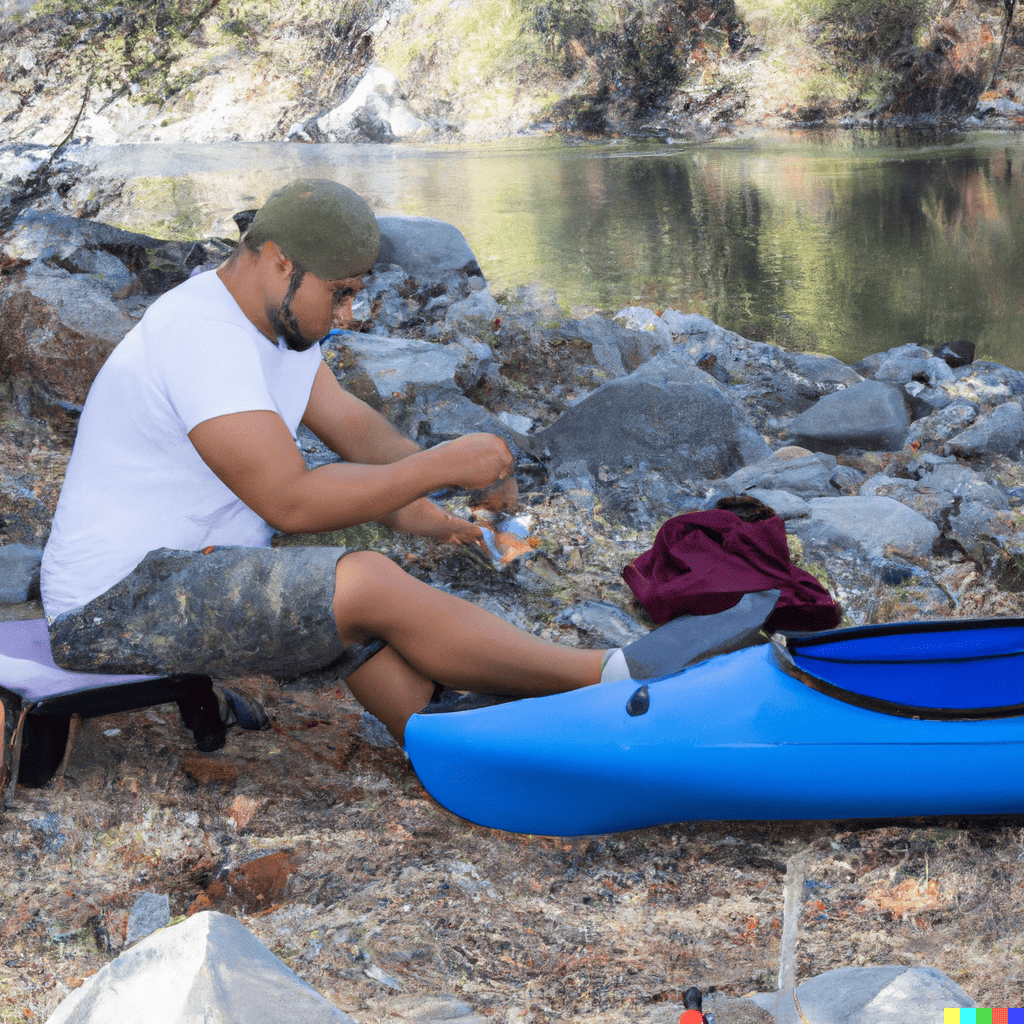
First and foremost, we cannot underestimate the significance of a personal flotation device (PFD) and a rope. These items serve as our lifelines in unexpected emergencies, giving us the peace of mind to enjoy our kayak camping experience. Additionally, carrying a reliable kayak repair kit is an absolute necessity. This invaluable resource equips us with the tools necessary to swiftly address any minor mishaps that may arise, allowing us to swiftly get back on track and prevent potential disruptions to our journey. In addition to safety gear, packing essential navigation tools is equally important. A compass, a trusted companion guiding us in the right direction, is a non-negotiable item in our kit. Pair it with a comprehensive map of the area we intend to explore, and we have the ultimate formula for confident navigation. In this digital age, leveraging technology can further enhance our preparedness. Downloading the map on our phones before the trip ensures that even if we lose our signal amidst the untamed wilderness, we can still rely on our preloaded digital map to find our way. Meticulous preparation is key to unlocking an extraordinary and safe kayak camping experience. By prioritizing including these essential items in our gear list, we can confidently navigate the waterways, fully immerse ourselves in nature’s embrace, and savor every moment of our remarkable adventure.
Effective Packing Strategies
Efficiently organizing and packing our gear for a kayak adventure is an art that can seem like a challenging game of Tetris. However, with a strategic approach and a few expert tips, we can master this essential skill and maximize the storage space in our kayak. Let’s delve into the world of smart packing and discover how to make the most of every inch.
Maximizing Storage Space in Your Kayak
Regarding intelligent packing for a kayak camping gear, several key considerations can help us optimize storage space and ensure a well-balanced load.
Streamlining Your Packing Process
When it comes to efficient packing for outdoor adventures, utilizing color-coded or see-through dry bags can revolutionize locating your items. This simple yet ingenious technique can be a game-changer, saving you time and minimizing the hassle of searching through multiple bags.
Assigning Colors for Easy Identification
You can create a visual system that simplifies your packing process by assigning specific colors to different gear categories, such as clothing, food, and camping essentials. Imagine the convenience of instantly recognizing which bag contains your rain gear, which one holds your snacks, and which one houses your sleeping essentials. No more rummaging through countless bags or mistakenly unpacking the wrong items. With color-coded dry bags, everything becomes easily identifiable and easily accessible.
Enhancing Organization and Efficiency
The benefits of color-coded or see-through dry bags extend beyond easy identification. They also promote organization and efficiency. By dedicating each bag to a specific category, you create a natural order within your gear. You can allocate one bag for cooking utensils and food supplies, another for clothing and personal items, and yet another for your camping equipment. This systematic approach ensures that everything has its designated place, allowing for a well-organized and clutter-free packing experience.
Simplifying Group Trips
Color-coded dry bags are precious during group trips or when sharing gear with others. Assigning a unique color to each participant or group member ensures that everyone’s belongings remain easily distinguishable. This eliminates confusion and makes distributing and retrieving individual gear effortless without mixing them up. Whether you’re on a family outing, a team adventure, or a group excursion, color coding can foster harmony and smooth coordination among all participants.
Some of the best kayaking camping trips can be found in kayak camping Michigan or even with kayak camping Tennessee will hold memories for a lifetime. Gather your group and head to the water.
Ensuring Quick Access and Peace of Mind
Another advantage of using color-coded or see-through dry bags is easy access to specific items. When you need to locate something quickly, you can zero in on the relevant color without wasting precious time. This proves particularly helpful when unexpected weather changes call for immediate access to rain gear or when hunger strikes and you must find your snacks promptly. By streamlining your search process, you can focus on enjoying your outdoor activities and have peace of mind knowing that your essentials are just a glance away.
Color-coded or see-through dry bags are a small investment that can yield significant benefits in terms of convenience, organization, and efficiency. They add a touch of simplicity to your packing routine and enhance your overall outdoor experience. So, next time you gear up for an adventure, consider implementing this game-changing packing strategy and enjoy its ease and satisfaction.
Balancing Weight for a Smooth Ride
Understanding the center of gravity.
The center of gravity is a crucial concept to grasp when maintaining stability in your kayak . It refers to the point where the kayak’s weight and contents are evenly distributed, allowing for a harmonious equilibrium on the water. In most kayaks, the center of gravity is near your feet, so it’s essential to focus on this area when organizing your gear.
Importance of Weight Distribution
Distributing weight evenly in the kayak serves multiple purposes. Firstly, it helps prevent the kayak from becoming imbalanced, reducing the risk of tipping or capsizing. Secondly, it enhances maneuverability by maintaining a neutral position for smooth turns and agile movements. Lastly, it contributes to your overall comfort during the paddling journey, as an unbalanced load can cause strain on your body and affect your posture.
Strategic Packing Tips
To achieve a well-balanced kayak, consider the following packing tips:
- Heavier Items at the Center: Place the heavier items closer to the kayak’s center of gravity, near your feet. This could include camping equipment, water containers, or any other dense gear. Doing so ensures that the weight is distributed evenly along the length of the kayak.
- Lighter Items Towards the Ends: Position lighter items towards the ends of the kayak, such as your dry bag with clothing or snacks. This helps maintain stability and prevents the kayak from feeling top-heavy.
- Balance Front to Back: Aim for an even weight distribution from the front to the back of the kayak. Avoid placing too many heavy items in one specific area, as this can create an imbalance and affect maneuverability.
- Side-to-Side Balance: Keep an eye on the side-to-side balance as well. If you have additional gear on one side, try to counterbalance it with similar weight on the opposite side.
By following these strategic packing tips and keeping the principles of weight distribution in mind, you can achieve optimal stability, control, and comfort while paddling your kayak. Remember, a well-balanced kayak leads to a more enjoyable and safer journey on the water.
So, take the time to pack thoughtfully and make adjustments as needed. As you embark on your kayaking adventures, the rewards of a properly balanced kayak will become evident in the smoothness of your ride and the freedom to explore with confidence.
Balancing Weight for Superior Stability
Achieving optimal stability and maneuverability in your kayak relies on careful weight distribution. By strategically placing your items and keeping the heavier ones near the kayak’s center of gravity, you can maintain a well-balanced vessel and enhance your overall paddling experience.
When it comes to loading your kayak, a well-balanced distribution of weight is essential for maintaining stability on the water. By following a few key principles, you can achieve optimal weight distribution and enjoy a smoother and more controlled ride.
Front-to-Back Balance
To maintain proper weight distribution, focus on balancing the load from the front to the back of your kayak. Placing heavier items towards the middle and back of the kayak helps keep the center of gravity aligned and prevents the kayak from becoming front-heavy. This balanced weight distribution promotes stability and improves your ability to maneuver the kayak effectively.
Side-to-Side Equilibrium
In addition to front-to-back balance, it’s important to consider the side-to-side weight distribution. Uneven weight distribution can lead to lopsidedness, affecting the stability and responsiveness of your kayak. To achieve an even distribution, carefully arrange your gear to position similar weights on both sides of the kayak. This equal weight distribution ensures better stability and makes navigating through different water conditions easier.
Considerations for Heavier Items
Heavier items should be placed in areas that contribute to balance and stability. Position them closer to the kayak’s center of gravity, typically near your feet. This placement prevents the kayak from tilting and helps maintain a level orientation. Securing heavier items is advisable to prevent them from shifting during paddling.
Organizing and Securing Gear
To optimize weight distribution and minimize the risk of items shifting or falling overboard, consider using storage compartments, dry bags, and bungee cords. These gear organization tools help keep your equipment secure and contribute to the overall balance of your kayak. It’s also a good practice to frequently check and readjust your gear during breaks to ensure stability throughout your journey.
By paying attention to both front-to-back balance and side-to-side equilibrium, you can achieve the optimal weight distribution in your kayak. This promotes stability, enhances maneuverability, and allows for a more enjoyable paddling experience.
Always double-check your gear placement and make necessary adjustments before setting off. With a properly balanced load, you’ll have the confidence to navigate various water conditions and fully immerse yourself in the beauty of kayaking.
So, take the time to organize and distribute your gear thoughtfully. Your efforts will be rewarded with enhanced stability, better control, and a more comfortable adventure on the water.
Embracing Versatility: Packing for Changing Weather
When setting out on a thrilling kayak camping expedition, being prepared for varying weather conditions is key to ensuring a comfortable and enjoyable journey. By packing versatile clothing and gear that can adapt to a wide range of temperatures and precipitation, you can confidently tackle whatever Mother Nature throws your way. Let’s delve deeper into some valuable tips for packing for different weather scenarios during your kayak camping adventure.
Mother Nature can be unpredictable, but with the right gear, you’ll be ready to face any weather conditions during your kayak camping trip. Here’s how you can effectively pack for varying temperatures and precipitation:
Layering for Ultimate Adaptability
Layering is a tried-and-true strategy for outdoor enthusiasts, and it holds true for kayak campers as well. By wearing multiple layers, you can easily adjust your attire to accommodate changing weather conditions throughout the day. Here’s a breakdown of essential layers to consider:
- Base Layer : Start with a moisture-wicking base layer that keeps you dry by drawing sweat away from your body. Look for materials like merino wool or synthetic fabrics designed for active wear.
- Insulating Layer : Add an insulating layer to trap warmth. Fleece jackets or lightweight down vests are excellent choices. They provide warmth without compromising mobility.
- Shell Layer : A waterproof and breathable outer shell is crucial for protecting yourself against rain, wind, and spray. Invest in a high-quality rain jacket and pants that can withstand the elements while allowing moisture to escape.
Adaptable Clothing and Gear
Versatile clothing and gear are essential when you can’t predict exactly what the weather will bring. Consider the following items to ensure you’re well-prepared:
- Convertible Pants : Opt for pants that can be converted into shorts using zip-off legs. They offer flexibility for changing weather conditions and varying levels of activity.
- Synthetic or Merino Wool Socks : Choose moisture-wicking socks that keep your feet dry and comfortable throughout the day. Synthetic or merino wool options are ideal for their breathability and quick-drying properties.
- Insulated Jacket : Pack a lightweight, packable insulated jacket to provide additional warmth during chilly evenings or unexpected temperature drops.
- Rain Gear : Along with a reliable rain jacket and pants, bring waterproof gloves and a waterproof hat to shield yourself from rain or spray.
Essential Accessories
Don’t forget to pack these essential accessories to enhance your comfort and protect yourself from the elements:
- Wide-Brimmed Hat : A wide-brimmed hat provides protection from the sun’s rays during hot, sunny days and offers some shielding from rain when needed.
- Buff or Neck Gaiter : A versatile and lightweight accessory that can be worn as a neck warmer, face mask, or headband, protecting against wind, sun, and bugs.
- Sunglasses : Wear polarized sunglasses to protect your eyes from harmful UV rays and glare. They improve visibility and reduce eye strain while paddling under bright sunlight.
Remember to check the weather forecast before your trip and make any necessary adjustments to your packing list. Flexibility and adaptability are key when it comes to preparing for changing weather conditions during your kayak camping adventure.
By incorporating versatile clothing layers, adaptable gear, and essential accessories, you’ll be ready to face any weather challenges that come your way. Embrace the elements and revel in the joy of kayaking, knowing you’re equipped to handle whatever nature has in store.
Easy Access to Essentials: Convenience at Your Fingertips
To ensure a seamless and organized kayak adventure, it’s essential to incorporate smart strategies that optimize gear accessibility and storage space. By implementing the following techniques, we can conquer the challenge of organizing our gear and embark on our kayak journey fully prepared and ready for anything nature has in store.
Having quick access to frequently needed items can make all the difference when out on the water. By storing essentials like a water bottle, map, and first aid kit in easily accessible compartments, you can avoid the hassle of rummaging through your packed gear. Consider the following options:
- Waterproof Compartments : Utilize dedicated waterproof compartments in your kayak to securely store essential items. These compartments keep your gear dry and easily reachable, providing convenience and peace of mind.
- Convenient Fanny Pack : Opt for a lightweight and water-resistant fanny pack that can be worn around your waist. This allows you to keep important items close at hand without the need to search through your larger bags. It’s a practical solution for frequently storing items you may need during your kayak adventure .
Elevating the Art of Smart Packing: Strategies for Success
By implementing the following strategies, you can optimize storage space, maintain balance, and ensure a well-organized kayak journey:
1. Color-Coded or See-Through Dry Bags
Using color-coded or see-through dry bags is a game-changer when it comes to locating items quickly and efficiently. Assign specific colors to different gear categories, such as clothing, food, and camping essentials. This organizational system streamlines the packing process and eliminates the frustration of rummaging through multiple bags.
2. Even Weight Distribution
Maintaining stability and maneuverability on the water requires even weight distribution in your kayak. Keep heavier items closer to the kayak’s center of gravity, typically near your feet. This prevents the kayak from becoming imbalanced and ensures a smoother paddling experience.
3. Proper Balance for Stability
Balancing the load from front to back and side to side is crucial for optimal stability. Pack heavier items in the middle and towards the back of the kayak while also distributing weight evenly on both sides. This prevents lopsidedness and improves maneuverability, allowing you to paddle with confidence.
4. Versatile Clothing and Gear
When packing for your kayak adventure, choose versatile clothing and gear that can adapt to weather conditions. Opt for clothing that can be layered, allowing you to adjust your attire as the weather changes throughout the day. This ensures comfort and flexibility during your journey.
Embracing the Journey: Ready for New Horizons
With these smart packing strategies and organizational techniques, we can elevate our kayak adventures to new heights. A well-organized and efficiently packed kayak sets the stage for memorable journeys filled with peace of mind and a sense of readiness. So, let’s seize the opportunity to explore the open water, paddle forth confidently, and embark on unforgettable kayak adventures that connect us with the beauty of nature. The water awaits – let’s embrace the journey and let our kayak adventures unfold!
Frequently Asked Questions
What are some safety precautions to take while kayak camping”.
“When we’re kayak camping, safety is our top priority. We always prepare for weather changes by checking forecasts and packing appropriate gear. In case of emergency, we carry devices like whistles and flares for signaling help. It’s also crucial to have a first aid kit, including items like a multitool and bear spray if we’re in bear country. Above all, we respect the ‘Leave No Trace’ principles to ensure we’re preserving the beauty and integrity of our environment.”
How can I effectively manage food and water supplies during a kayak camping trip?”
Ever thought about managing food and water on a kayak camping trip? Let’s dive in. For food, we use preservation methods like vacuum sealing, dehydrating, and using canned goods. It’s all about packing lightweight, non-perishable items. For water, we rely on filtration techniques. We carry a portable water filter, purifying tablets, or a UV light pen. Remember, it’s not just about surviving, it’s about enjoying the journey together.”
What potential challenges or difficulties might I encounter during my first kayak camping trip and how can I overcome them?”
Weather challenges can be a potential difficulty on your first kayak camping trip. Always check the forecast and prepare for sudden changes. Gear selection is also key – ensure you have the right equipment for your needs. We’ve found dry bags, a sturdy kayak, and a reliable tent are essentials. Remember, we’re in this together, learning from each experience. Don’t worry, with careful planning and preparation, you’ll overcome these challenges and have an unforgettable adventure.”
What are some tips for maintaining personal hygiene during a kayak camping trip?”
“Did you know 65% of campers agree that hygiene affects their camping experience? For kayak camping, we’ve got great tips. Consider using solar showers; they’re efficient and eco-friendly. Opt for portable toiletries, they save space and are easy to carry. Don’t forget biodegradable soap and wet wipes for quick clean-ups. Remember, we’re all in this together; maintaining hygiene ensures a pleasant trip for everyone!”
What kind of clothing is most suitable for a kayak camping trip?”
“We recommend clothing that offers weather adaptability for kayak camping. Layering techniques are key; start with swimwear, then add a SPF shirt, and a puffy jacket for cooler weather. Don’t forget water shoes, sandals for wading, and a hat and sunglasses for sun protection. Clothing should be versatile to handle changes in weather and activity. It’s all about being prepared while feeling comfortable and connected with the great outdoors.”
Similar Posts
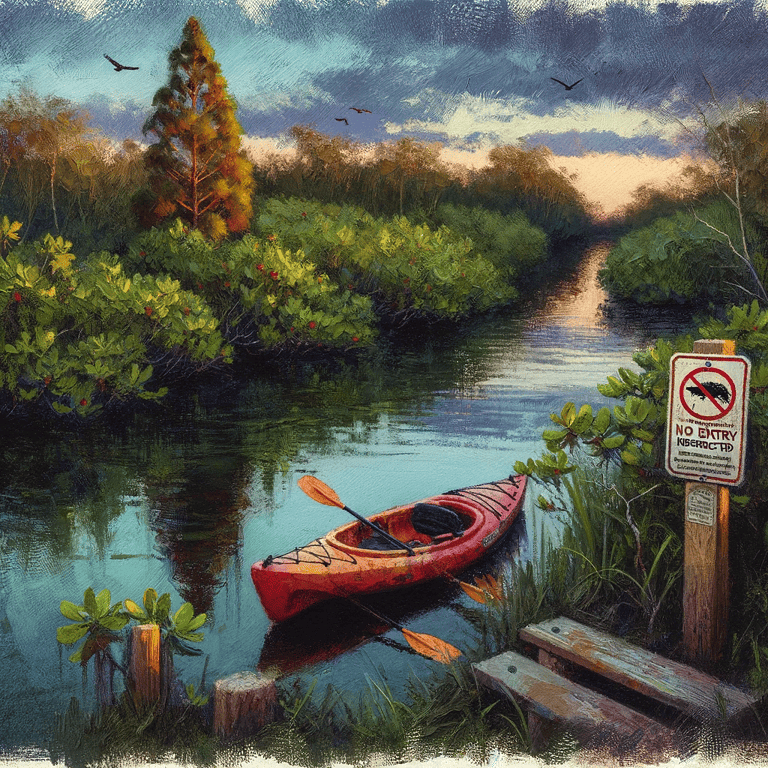
Unlocking Key West’s Wildlife Wonders via Kayak
Unlocking Key West’s Wildlife Wonders
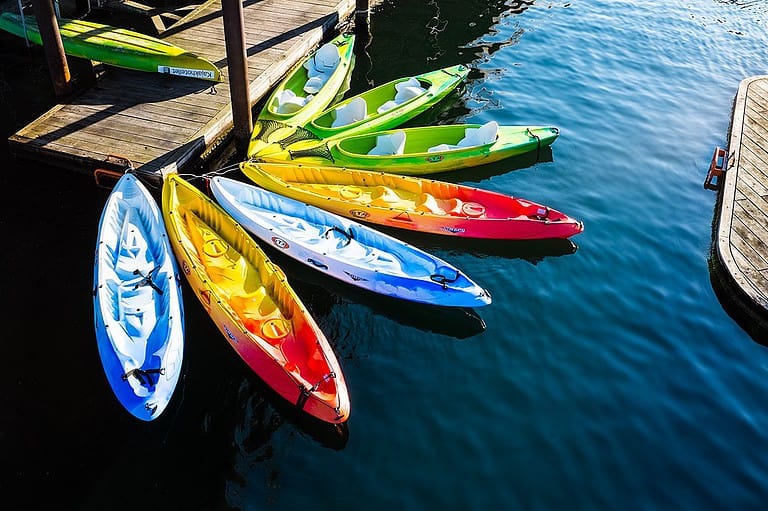
Understanding Kayak Classifications: Recreational, Touring, And Sea Kayaks
Discover the wonders of the open water with Understanding Kayak Classifications. From serene lakes to wild seas, find your perfect vessel for aquatic adventures. Join us on a voyage of knowledge as we dive into each classification’s features and help you choose the right kayak for your journey!
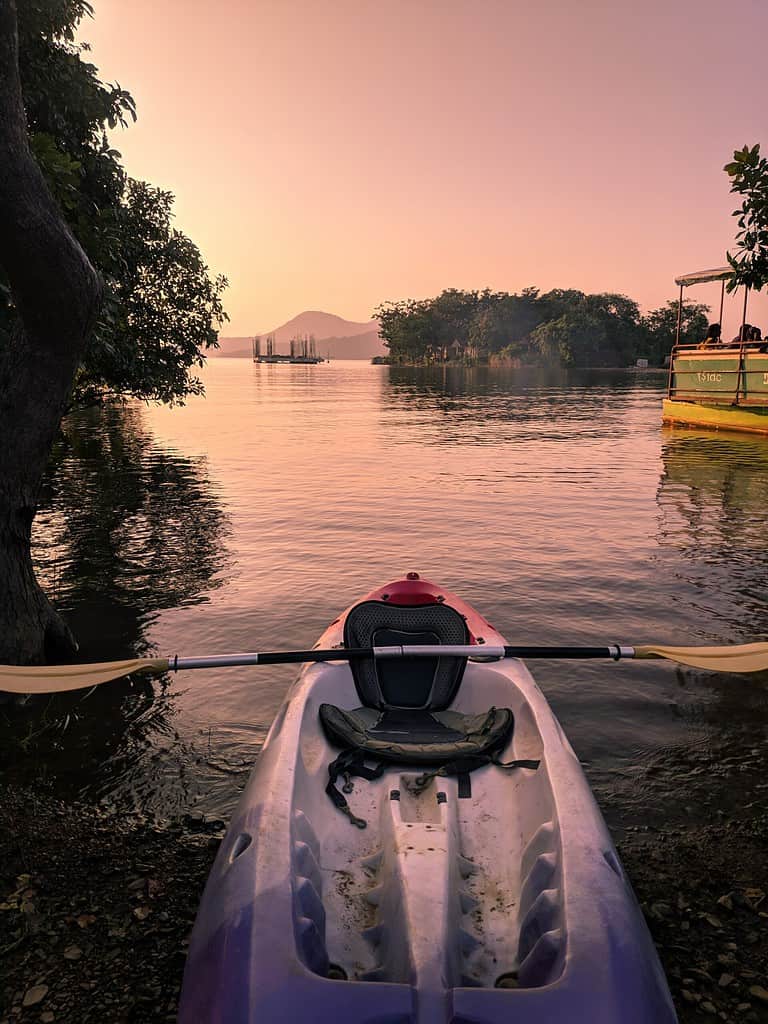
A Guide To Kayak Materials: Plastic Vs Composite
A Guide To Kayak Materials: Plastic Vs Composite – Compare pros, cons, performance, durability, and environmental impact of plastic and composite kayaks.
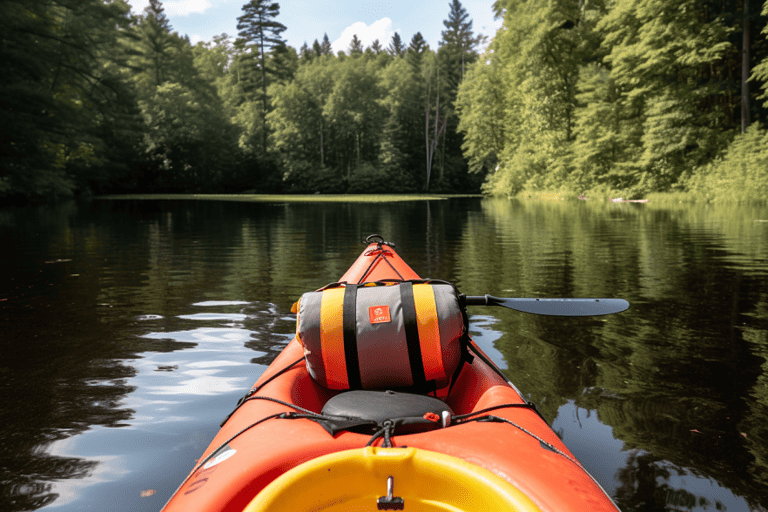
Boundry Waters Canoe Emergency And Safety Planning
Stay safe Canoe Emergency And Safety Planning! Learn tips for emergency and safety planning before your next outdoor adventure
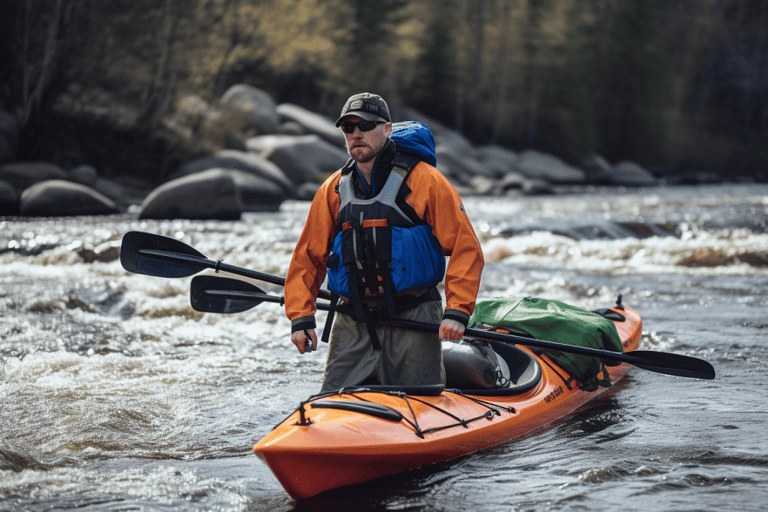
How To Prepare For Unexpected Situations In Kayaking
Prepare For Unexpected Situations In Kayaking! Learn how to prepare for emergency situations while kayaking with these essential tips.
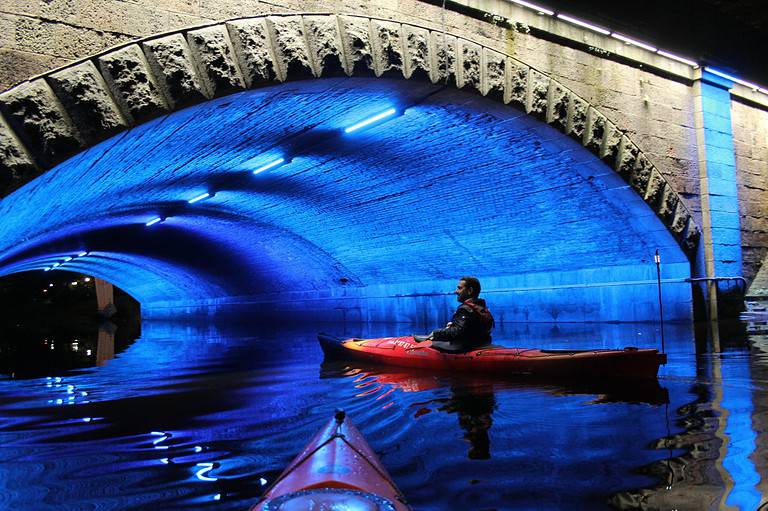
Selecting A Kayak For Flatwater Paddling: Things To Consider
A comprehensive guide to selecting a kayak for flatwater paddling. Explore factors like size, stability, type, material, features, price, and more.

Kayak Camping: Tips for Planning, Packing, & Gear
Learn the best kayak camping tips for beginners including essential kayak camping gear, how to pack a kayak, tips for buying a kayak, & more
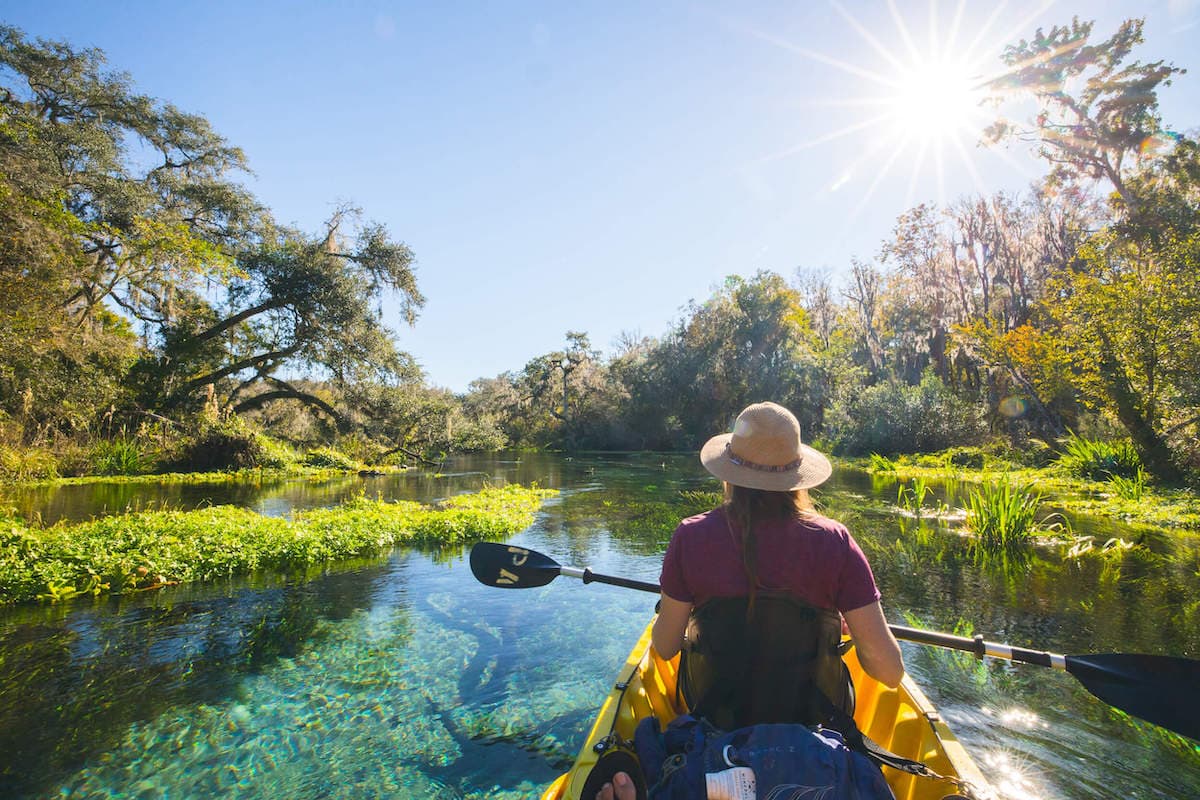
If you love kayaking and you also love backpacking, you should add kayak camping to your adventure list! You’ll not only get to experience backcountry wilderness but also the serenity of being on the open water. One of the best parts of kayak camping is that you don’t have to haul a heavy load on your back for miles on end. You’ll still get a workout as you paddle a boat full of gear, however, plus camping with a kayak gives you more flexibility to take breaks and offers a whole new view, even in areas you’ve already explored.
So whether you’re looking to try kayak camping for the first time or you’re planning your next adventure, this guide will give you tips and advice to help you get out on the water and make the most of your trip.
Here’s our complete guide to kayak camping.
Important Reminder: As outdoor recreationists, it’s our responsibility to know how to recreate responsibly on the water whether we’re kayaking, paddleboarding, canoeing, rafting, or boating. Learn how to prevent the spread of aquatic invasive species with 3 easy steps that have a huge impact on our ecosystems.
How to Choose a Kayak Camping Location
How to choose a kayak, essential kayak camping gear, how to load a kayak for camping.
Selecting your perfect kayak camping location will help you determine how and what to pack. The art of loading a kayak with gear can take some time to perfect, so save the whitewater rapids for another trip and start with more of a calm water destination.
I’d recommend starting with a lake or river that has already established campsites. Keep in mind that if you opt for a river, you’ll likely need an extra vehicle to park at the end of the trip. Plan on sticking to one or two nights for your first excursion. Depending on how experienced you are, anywhere between five to fifteen miles per day should give you plenty of time to paddle and take breaks.
If you decide to hunt out your own site, be sure to set up camp at least 200 feet from the water. Camping in coastal areas offers a chance to see different wildlife, but be sure to take the tides into account when selecting the spot to set up camp.
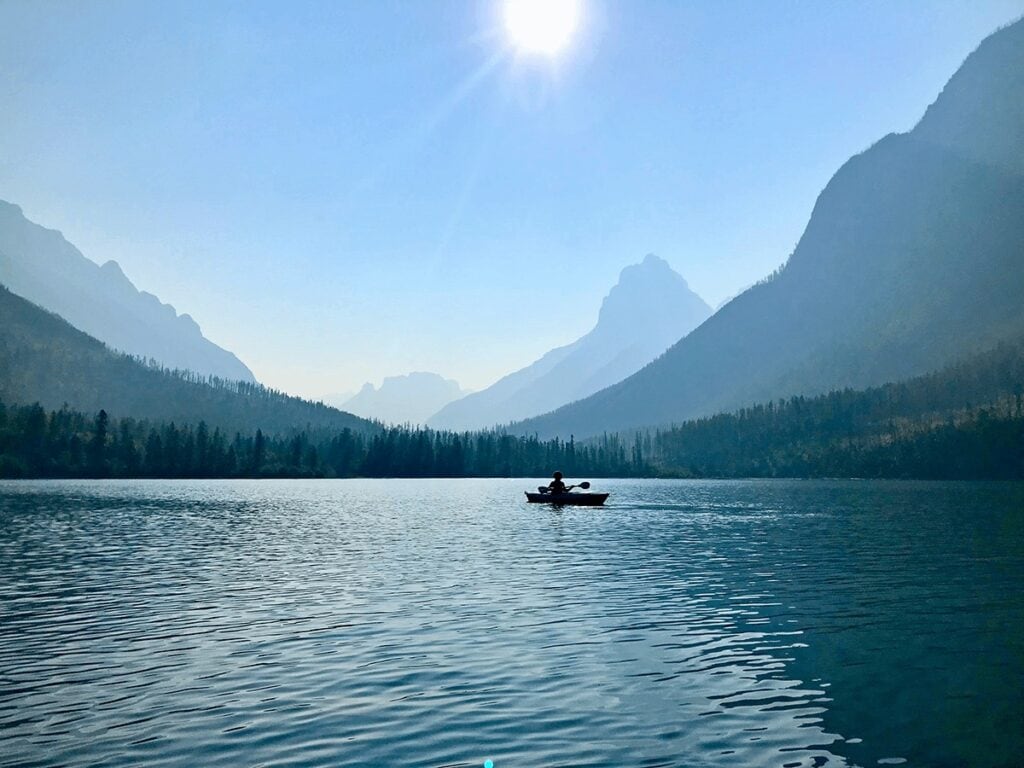
Ultimately, the best kayak for camping is the one you already own. If you plan on renting or investing in a kayak for camping, here are a few things to consider in advance.
- Storage will be crucial to your comfort. You’ll need to store almost everything in dry bags , but having a watertight compartment is a nice feature as well. You can use it to protect valuables like your phone and camera. It’s also a relief to get to camp and have at least some things that are dry. Touring kayaks are typically equipped with these watertight compartments.
- Comfort is a necessity with long days on the water. My primary kayak, similar to this Perception Joyride 10 Kayak , has a supportive seat and foot braces . It also has thigh pads that help with stability. These are all features that will help you paddle for miles with a full kayak. If your seat doesn’t offer enough support, you can install a separate kayak seat to ensure a comfortable trip.
- Comfort isn’t limited to your kayak, however. If your paddle doesn’t have any cushioning, your hands will likely hurt after a day on the water. Adding paddle grips can make a surprising difference in how long you can paddle in a day.

For backpacking enthusiasts, packing for a kayak camping trip will feel familiar. You’ll be bringing most of the same gear, switching out your backpack for a kayak. Since you won’t have to carry all of your gear, you’ll have a little more room for a luxury item or two. Here are some must-bring items:
Kayak Camping Accessories
- Dry bags – Aside from a few accessible items like water and snacks , everything should be packed in dry bags. Even if you’re certain you won’t flip, anything stored on the kayak or in the hull will likely get wet. Dry bags will keep essentials dry and organized. I use several smaller Sea to Summit dry sacks to make packing easier.
- Personal flotation device – Wearing a PFD, or lifejacket, is not only a good safety protocol, but state laws typically require that you have one on board.
- Rope – Bring along a rope to tie up your kayak in case you will leave it close to shore. Paracord is compact and works great.
- Kayak repair kit – A repair kit won’t take up much room and can be a lifesaver if something goes wrong
- Towel – You’ll be living on the water for a few days, so a towel is key. PackTowl’s UltraLite Towels are easy to bring on backcountry trips and work well for how compact they are.
- Binoculars – bring along a pair of binoculars to spot wildlife right from your kayak!
Kayak Camping Gear
- Tent or hammock – Kayak camping offers more flexibility than backpacking, but you’ll still want to use a lightweight backpacking tent or hammock to conserve space and weight. If you’re kayaking in warm climates, you may be fine sleeping under the stars or just bringing the fast-pitch option if your tent has that.
- Sleeping bag – Car camping sleeping bags can be bulky and heavy, so bring along your favorite backpacking sleeping bag .
- Sleeping pad and pillow – A pillow is one of those luxury items I have to bring. Inflatable pillows always have me reaching for some clothes to use instead, so I’m a fan of Therm-a-Rest’s Compressible Pillow when there is room to pack it.
- Headlamp – You’ll need to take extra precaution if you head out on a nighttime paddle, but you’ll also need lighting for around camp. The BioLite headlamp is our favorite because it’s a rechargable, energy efficient LED headlamp that lasts a long time on a charge, especially if you use it on low.
- Small daypack – One of my favorite things about kayak camping is the ability to explore new areas onshore as well. If you think you may want to explore on land, bring along a small daypack for supplies.
Kayak Camping Clothes
- Swimwear – If you’re anything like me, you’ll have a hard time staying out of the water. Investigate the water temperature before your trip if you’d like to swim and then pack accordingly.
- Water shoes or sandals – I can’t say I do any fishing, but I love Columbia’s fishing shoes for all watersports. The PFG Tamiami Shoes have enough grip to traverse wet rocks and are comfortable for camp or heading into town.
- SPF shirt – Most kayaking spots involve a lot of open exposure, so you should plan on getting a lot of sun. Outdoor Research’s Echo line is my favorite to keep cool and protect my skin from harmful sun rays.
- Hat, sunglasses, or both – I go for the combo since the sun reflecting off of the water can be killer. The Wallaroo Sedona hat is a favorite ( Use the code BEARFOOT20 for 20% off ).
- Puffy : kayaking can get chilly, so having a synthetic down jacket packed away is essential so you can stay warm.
Essential Clothing for Paddling
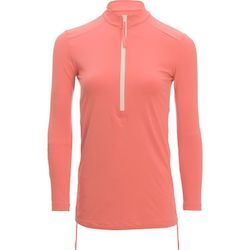
Carve Designs Cruz Rashguard
I prefer wearing a rashguard over sunscreen these days. I own the Cruz in 2 colors and it’s a staple for any water activity because it dries quickly but also keeps you cool, plus the cut is flattering.
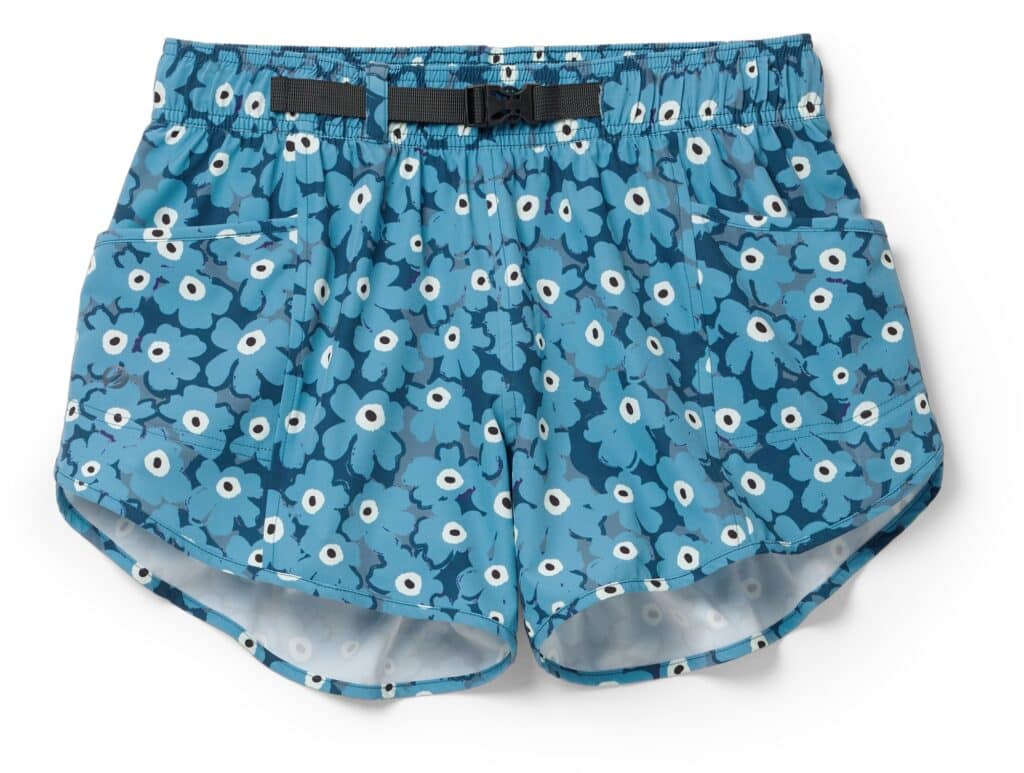
Nani Swimwear Hybrid Explorer Shorts
These shorts are super comfortable, dry really quickly, and come in a bunch of colors and prints. I wear them on all water adventures!

Teva Universal Trail Sandals
Sandals that stay on your feet and can get wet are essential. I like these because they have good grip and can be worn hiking as well, plus they can easily be strapped to your boat when not in use.

Outdoor Research Sunbriolet Hat
You’ll want a wide-brim hat that can get wet and has a chin strap so it stays on in the wind. This Outdoor Research hat is quick-drying, will float if it falls in the water, and comes in a variety of colors.
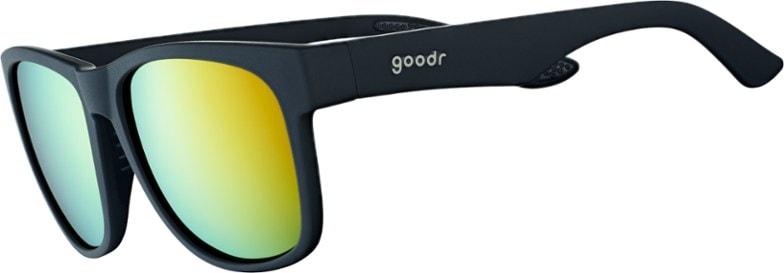
Goodr Polarized Sunglasses
Polarized glasses are best for the reflection of the water. I like to wear budget-friendly sunglasses paddling and I always wear a retainer so I don’t lose them in the water.
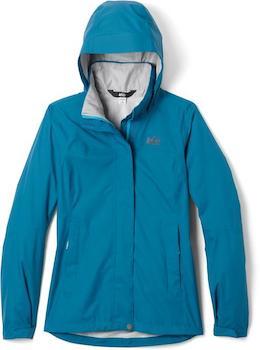

REI Co-op Rainier Rain Jacket
If it’s chilly or windy it can be helpful to have a lightweight rain jacket or windbreaker out on the water with you. I usually pack a jacket like this just in case!
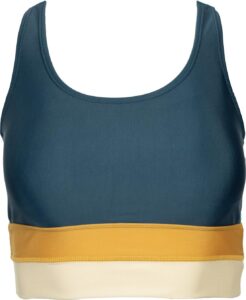
Supportive Swimsuit or Sports Bra
You’ll want a comfortable swimsuit that you can be active in. I like to avoid swimsuits that pull on my neck (like halters) and have been loving Nani Swimwear lately.
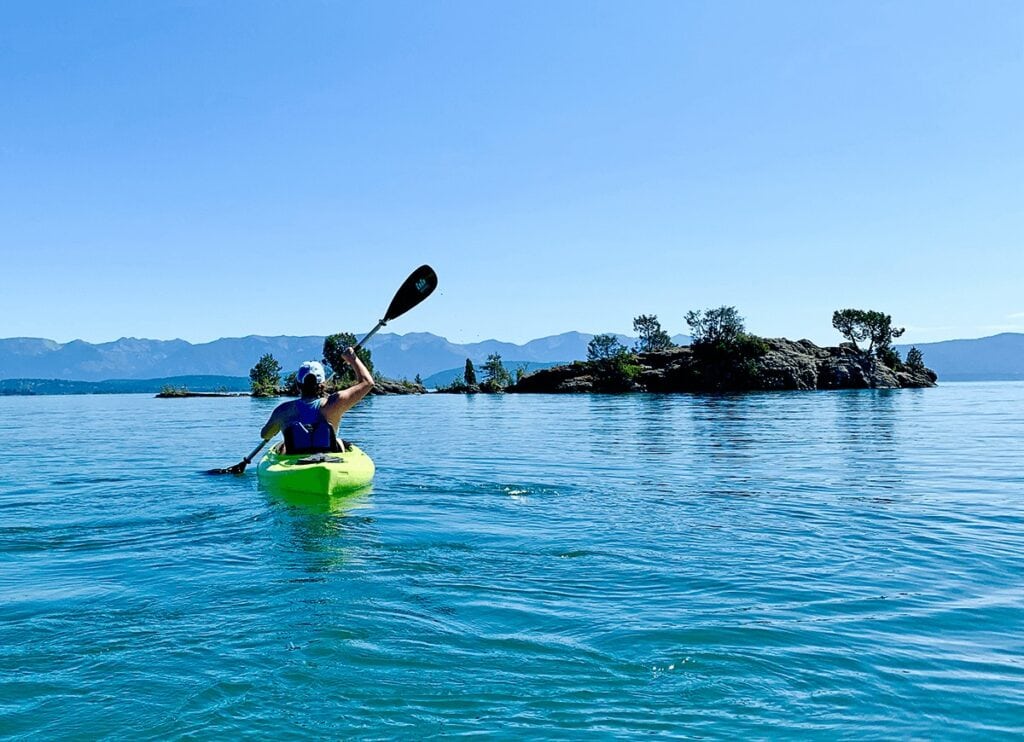
Kayak Camping Kitchen Essentials
- Stove and fuel – You can get away with bringing pre-packaged foods, but the best kayak camping food for me needs to be hot. Camp coffee in the morning is a must as well. I rarely go camping without my Jetboil Flash stove .
- Mug or bowl and utensils – I usually keep it simple with a single mug and spork . If I can’t eat it with those, I don’t need it.
- Food storage – Even if you are not in bear country, you should bring along a separate canister or bag for food with rope. A dry bag is easiest as it’ll offer more storage flexibility in the kayak compared to a canister.
- Food – This is where a lot of people will opt for a luxury item or two. I stick to dehydrated foods , but like to bring along a fancy beverage. I wouldn’t carry the weight of an extra drink on the backpacking trail but will indulge when the kayak is doing all of the work.
- Water bottle – Keep your water bottle handy as it’s easy to get dehydrated when paddling in an exposed area. A Hydroflask is nice as it keeps water cold throughout the trip and is less of a hassle than a bladder.
- Water filtration – I’ve struggled with pump or squeeze filters in the past, so I solely rely on a Platypus GravityWorks filter now.
- Garbage bag – Make sure to clean up after yourself and follow Leave No Trace principles .
Kayak Camping Toiletries & Safety Gear
- Maps – Navigating a lake or river can be a little more difficult than a marked trail. Snag a local map and compass, and download the information on your phone before your trip to keep track of your location.
- Bug spray – Campsites near the water are notorious hotspots for bugs, so bring along some insect repellent to keep the bugs at bay.
- Hygiene kit – Bring along everything that you’ll need for a few days including a toothbrush, toothpaste, sunscreen, SFP lip balm , toilet paper , hand sanitizer , and a poop kit . If the place you are visiting requires you to pack out all of your waste, be sure to bring a few wag bags and dispose of them at the end of your trip.
- First aid kit – Ensure your kit also includes a knife or other multitool along with some matches.
- Bear spray – This is a must if you are heading into bear country
- Emergency communication device – I always carry a Garmin on all outdoor adventures so I can easily call for help in case of emergency. Since many areas of the backcountry don’t have cell service, don’t rely on your phone in case things go sideways.
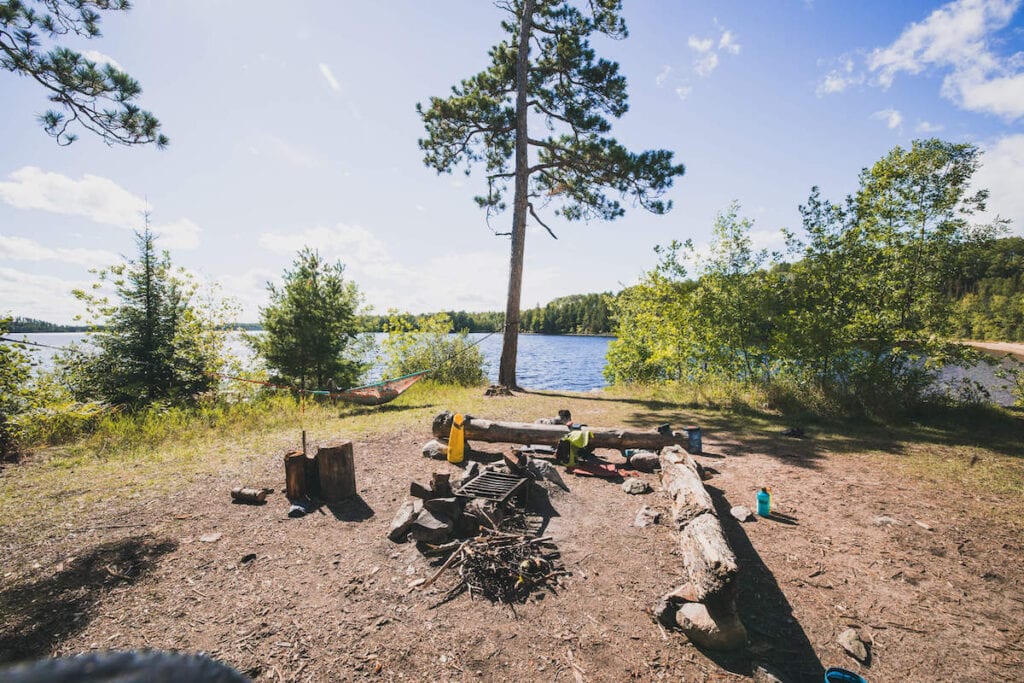
Packing a kayak for camping is a unique form of art. On a typical backpacking trip, you can pack your bag at home so it’s ready to go when you hit the trail. You won’t have that option when it comes to packing your kayak, so you may want to practice at home before your first trip.
Once you’ve gathered all of your gear and are ready to pack, you’ll need to keep three things in mind. You’ll need to pack strategically to ensure everything stays dry, the kayak is balanced, and certain items are easily accessible. Here are a few tips for loading your kayak for camping:
Use Dry Bags
Almost everything you are bringing should be kept in dry bags . It’s easier to get everything to fit in the kayak if you use smaller or medium size bags (like 35-65 L).
If you’re able to color-code them in some way, it will also help you locate items easier. I’ve learned from experience that it is nearly impossible to find anything when all of your dry bags are the same color. Alternatively, see-through dry bags allow you to see all your gear without having to open up every bag.
Know How to Distribute the Weight
To get the right weight distribution, keep the heaviest items like food, water, and fuel closest to your center of gravity . Ideally, your kayak will have space directly behind the seat for some of these items. You can also keep a small bag at the bottom of the boat between your legs if it won’t interfere with paddling.
Then store lighter items, like your sleeping bag and clothes, on either end with mid-weight items somewhere in between. While aiming to balance the kayak from front to back, you should also try to balance the weight from side to side as well. The heaviest items should go in the center.
Keep Your Essentials Accessible
Anything that you won’t need to access through the trip should be stored in a sealed compartment or strapped down in some way. While you of course don’t want to flip, everything should be secured in case it happens.
A waterproof fanny pack is a great way to keep your gear (like phone, sunscreen, compact camera, etc…) easily accessible while still being able to keep everything waterproof and secure. You may also want to keep another layer of clothes handy as well.
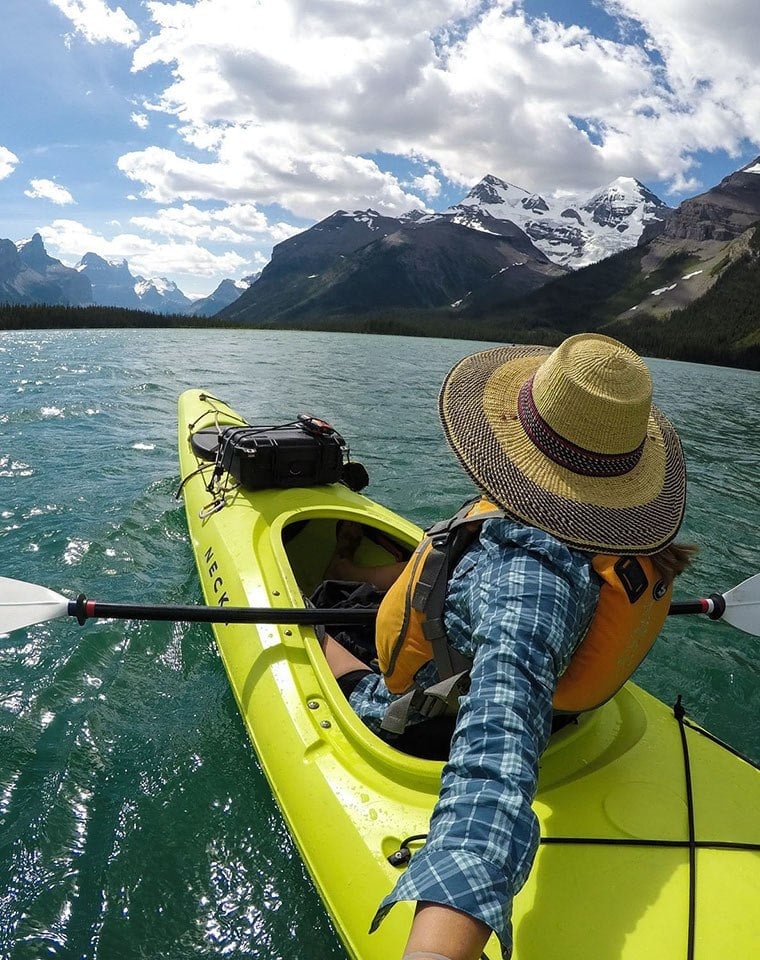
Kayak camping can feel a little intimidating at first, but it is easier than it seems. You’ll love the serenity it provides without feeling like you’re carrying the weight of the world on your back. With the right preparation, you’ll be enjoying the healing power of water in no time.
Do you have any kayak camping trips planned or any questions about this? Let us know in the comments below!

Jessica is a former local government nerd who fell in love with the outdoors when living in Montana at a young age. After years of working a government job in the midwest and only adventuring on the side, it was time for a change. They put their law-writing pen down to write about the outdoors and wellness instead and it has helped ensure many adventures to come.
Leave a Reply Cancel reply
Your email address will not be published. Required fields are marked *
Save my name, email, and website in this browser for the next time I comment.

October 15, 2023
Looking to plan your first kayak camping trip, but don’t know where to start? No worries, I’ve got you covered! Here, we’ll cover what to pack for overnight kayak camping, how to pack a kayak, the best kayak camping gear, planning an overnight kayak trip, and so much more!

How to Kayak Camp: A Beginner Guide’s Guide to Overnight Kayaking
From how to plan a route to what to pack for kayak camping, here is a beginner’s guide to how to kayak camp!
why me? Hi there! I’m Maddy. You might notice this article is written in first person– that’s because a person is writing it! I’ve got six years’ experience overnight sea kayak camping and kayak guiding, and I’m here to help you get on the water comfortable and safely. This summer, I’ll be in my seventh year as a sea kayaking guide and outdoor professional. Have a great trip!
Note: this post contains affiliate links! That means if you click a product link and were to buy something, I make a small kickback at no additional cost to you.

1) Pack for the weather
This might seem obvious, but one of the best things you can do to have a successful kayak camping trip is packing for the weather. This includes considering the water temperature instead of only the air temp. Here’s a quick guide for what to pack for kayak camping:
Best clothes to pack for kayak camping:
- Wool or synthetic baselayers for camp: the Capilene line from Patagonia is a really great place to start for baselayers if you don’t like wool.
- Wool baselayers for paddling: I’ve used Smartwool baselayers for years now and found they hold up really well to heavy abuse. I also really love the Kokatat Woolcore line, designed to be worn underneath drysuits. I would stick to Smartwool if you’re looking for cross discipline baselayers (skiing ect) and Koktatat if your looking for a fit for paddling specifically.
- Camp pants: For warmer trips, a quick drying pair of shorts. I use the Patagonia Outdoor Everyday Shorts because they’re high-waisted and long enough to prevent chaffing when walking with wet shorts. For pants, I wear the Kuhl Freeflex Rollups . I was gifted these last winter and used them all summer sea kayak guiding. They’re really flattering, dry quickly, and don’t show dirt (depending on the color, I have gold).

- Fleece mid-layers : you can find decent fleece midlayers at any thrift store near you. You can almost always find a thin Eddie Bauer brand fleece; this makes an excellent cheap midlayer.
read about the best ways to find used outdoor gear here!
- a warm puffy jacket : I have this one and love it
- Raincoat and Pants : This one from Helly Hansen is affordable and great for torrential downpours, and I’ve had this pair of rain pants for 7 years, no complaints.
- A wetsuit or drysuit ; if the water temperature plus the air temperature is less than 120 degrees, you’re at a hypothermia risk and should consider wearing immersion gear. For wetsuits, a farmer John or Jane style is pretty typical. Personally, I prefer a two-piece long sleeve wetsuit , which I find to be a lot warmer and more comfortable
- A small drybag with emergency dry clothes

Best Camping Gear to Pack for Kayak Camping:
- A warm synthetic sleeping bag. Synthetic sleeping bags dry more quickly than down bags, which can be completely ruined by water. Check out the Sea to Summit Traverse Bag (unisex) for a warm and versatile synthetic bag that packs down small enough to easily pack. Alternately, I just switched to the Nemo Disco down sleeping bag. Bringing a down bag is always a risk (I store mine in this compression sack/ dry bag 20 L ) as a wet down bag can ruin a trip. That being said, spending more nights out guiding than in my home, the extra comfort of a warm down bag was life changing. I let my sister (an occasional car camper) borrow this bag when she visited Washington and paired with the right sleeping pad she reported back the best sleep she’d ever had outside.
- A sleeping bag liner basically works as a sheet for your sleeping bag, and can provide a lot of extra comfort and warmth. I’ve had my Reactor Extreme for six years now and it makes a huge difference for camp comfort.
- A sleeping pad . There are a lot of excellent sleeping pads on the market, but for kayak camping you want one that packs down small, and ideally inflates. I like to look for pads with a 4 R-value, or rated for three season use like this one . You do not want a folding sleeping pad for kayak camping. This will take up too much space.
- A tent or hammock camping set up ! For helping choosing what tent is best for you, read this article . For sea kayaking, keep in mind that many of the available campsites are on sand or hard rock, and a freestanding tent often makes the most sense.
- A camp stove , cook kit , and meal plan . Most guided tours will take care of this part for you!
- A Water Dromedary : are you island kayak camping? Keep in mind that water might not be readily available.

Kayaking Gear to Pack for Kayak Camping:
This will depend on your trip, and for guided trips your outfitter will likely provide all the required equipment. At minimum, the average kayak camping trip you should have a kayak, a buddy, a PDF or life jacket to be worn at all times on the water, local weather reports, a first aid kit , spare paddle and paddle , bilge pump , THREE ways to signal for help not including a cell phone, and a throw line or tow rope.
Have more questions about what to pack for your kayaking trip? Check out this detailed guide to how to pack a kayak!
2) dress for immersion when kayak camping.
One important thing to remember when getting ready to kayak camping is to dress for the water temperature, not the air temperature. This includes wearing a wetsuit or drysuit when necessary!
This also includes wearing your PFD on the water at all times . It is almost impossible to put on your life jacket after you have already capsized , and in many kayaking and canoeing deaths the victim is found in the water without their lifejacket on.

Most kayaking deaths are drowning by way of hypothermia, as in after multiple failed attempts to reenter a kayak, the victim looses motor function and eventually becomes unconscious and drowns. You may have only minutes after a capsize to successfully reenter your boat before hypothermia makes it impossible to move your body well enough. For this reason, it is very important to dress for the water temperature (buying you time), wear your PFD, and practice assisted and unassisted rescues.
I use an Astral Bluejacket PFD which is low profile with plenty of pocket storage. For a more entry level alternative, the NRS Ninja is a great choice. Astral also makes the Greenjacket PFD , which is a rescue PFD good for whitewater or more extreme kayaking. If you’re reading a beginner kayaker, this PFD is probably overkill for you, but it’s always good to check out all your options.
Keep in mind: If you find yourself floating in the water next to your boat DO NOT let go of your boat and attempt to swim to shore! The coast guard finds your boat first, you second.

Looking for a beautiful kayaking destination? Check out the best things to do in the San Juan Islands !
3) bring smaller gear to fit more easily in hatches.
Wondering how to pack a kayak for camping? Packing for overnight kayaking can be difficult, but packing smaller units can make that easier. Instead of bringing three large drybags, pack six smaller ones. Keep in mind that weight doesn’t really matter, but size sure does.
One thing that I’ve found makes packing a lot easier is Sea to Summit’s compression Evac Drybags . I use an 8 L and a 20L, and put my clothes in the 8L and sleeping bag in the 20L. These drybags syntch down very small and do a deceptively excellent job waterproofing.
Kayak Camping Pro tip: pack some Ikea bags to help you carry gear from your landing point to camp!
Do i need to distribute weight evenly for kayak camping.
In general, most kayaks have so much buoyancy that it does not matter how you pack them weight-wise, especially if you’re using a tandem sea kayak (if you’re reading this blog I recommend using a tandem sea kayak and a guide probably!!)
If you are kayak camping out of a small, sporty kayak in high wind and waves, you’ll want to pack your kayak a certain way to optimize your paddling experience. Generally, the person who is paddling a boat like this is probably not seeking out packing advice on the internet.
Again very generally, you want weight evenly distributed throughout your boat. If you will be paddling downwind, you might want to pack your stern more heavily to prevent the bow diving into the waves.

These photos are from Desolation Sound, British Columbia. Learn all about kayaking Desolation Sound here !
4) pick the right kayaking route for your skill level.
A big part of a successful sea kayaking trip is choosing the right route for your skill level. Open coastal routes (think: any area where the coast you’ll be paddling is exposed to more than a few miles of open water! This can include large lakes as well as the ocean) pose more of a hazard than protected lakes, and while inlets and channels on the ocean may be protected from open swell, they may see large tidal currents due to the narrow passageways between islands.
Long lakes flanked by mountains (or inlets flanked by mountains) will likely experience katabatic winds as the air above the water warms and rises causing cooler air from higher elevations to gust down; katabatic winds can gust in excess of 50 mph and pose a major hazard to kayakers of any skill level.

When choosing your route, research local hazards including weather patters, tidal currents, access to fresh water, possible bailout points, and other factors. A great place to test out your first kayak camping experience is a local lake or calm river with access to municipal or state or national forest campgrounds. Look for a place with cell service for easy bailout (but don’t necessarily rely on cell service, because cell phones tend to work poorly from the bottom of a lake).
Best beginner kayak camping destinations:
Note that this list is Midwest centered, because I am based in the Midwest!
- the Manistee River in Northern Michigan has several national forest campgrounds along the river making for a pleasant beginner friendly kayak or canoe overnight trip.
- North Cascades National Park on Ross Lake: a good rule of thumb is anywhere good for flatwater canoeing with no portages is good for beginner kayak camping! Watch for katabatic winds on mountain lakes like Ross.
- Several lakes in the Superior National Forest outside of the Boundary Waters in Northern Minnesota have beautiful, free first-come, first-serve island campsites that make for a great place to test skills
- The Sylvania Wilderness is another excellent beginner kayak or canoe camping destination.
- For detailed route plans and many more beginner kayaking and canoeing routes in the Midwest, download the Midwest Adventure eBook bundle .
All of these routes are suitable for most kayaks and most do not necessarily require a sea kayak, or a long kayak with sealed bulkheads, or pockets of air, at either end usually using a spray skirt. All coastal trips including open lakes such as Lake Superior, Lake Michigan, Lake Huron, Lake Ontario, and Lake Erie are considered coastal kayaking trips, and I would recommend tackling any trip with more than two miles of open water in any direction as if it were a coastal trip, especially as a beginner.

5) Find a guided kayak camping tour for bigger trips
Looking to tackle a coastal kayak camping trip, but don’t have the experience to do it alone? When in doubt about local weather patterns, trip planning, or your own paddling experience, it’s best to book a guided tour! Here are a few destinations and outfitters I reccomend:
- Lost Creek Adventures in the Apostle Islands National Lakeshore: beautiful cliffs and sea caves, sandy beach campsites in. the outer islands. The Apostle Islands in Wisconsin are considered a premier sea kayaking destination. Lake Superior can be extremely rough and changeable in the islands; even for experienced paddlers a local guide is worth hiring.
- Keweenaw Adventure Company in Isle Royale National Park: Looking for a true wilderness sea kayaking adventure? Head to the remote Isle Royale National Park to kayak rugged sea cliffs and fall asleep under the Northern Lights. To date, my trip to isle Royale is the most remote-feeling place I’ve ever paddled.

- Powell River Sea Kayak in Desolation Sound, BC: Sea kayak the warm and calmer waters of Desolation Sound, British Columbia to paddle the ocean next to mountains. For a truly epic trip, head up Toba or Bute Inlets to paddle incredible fjords with humpback whales (if you’re lucky, it’s not a zoo!) and underneath countless glacial fed waterfalls. Toba Inlet and the omfray Channel are the prettiest places I’ve ever paddled.
- Outdoor Odysseys in the San Juan Islands: For one of the best places in the world to sea kayak with orca whales, head to the San Juan Islands of Washington! I spent the summer sea kayak guiding here and can personally attest to the incredible campsites, intertidal life, sea cliffs, and endless beautiful sunny days (except that one trip where it poured the whole time). The most incredible thing about the San Juans, of course, is the marine life. Expect to paddle with harbor seals, sea stars at low tide, otters and harbor porpoises. Roughly every third trip I spotted orcas; it’s definitely not a guarantee, but comparing the summer I spent guiding exclusively in the San Juans to my 70-day British Columbia sea kayaking expedition, I saw whales roughly four times as often.

- Spirit of the West Adventure in the Johnstone Strait and Broughton Archipelago of British Columbia, another excellent place for whale watching and mountain views, particularly good for humpback whale sightings.
- Maine Kayak in coastal Maine; offers both coastal kayaking and Inn to Inn kayaking.
- Explore Kenai Fjords National Park from a lodge in Alaska with Alaska Wildland Adventures .
- Sea Kayak Baja Mexico for blue water, unique adventure, and gray whale habitat.
- Sea Kayak the rugged and beautiful Scottish Coast with Kayak Summer Isles
- Most of these locations are Northern! You can book guided sea kayaking overnight trips all over the world. Consider also looking in the Everglades , Virgin Islands , Patagonia , New Zealand , Lofoten , Greenland , and more!
looking to hit the road this summer? Check out this detailed guide to planning your solo road trip!

6) Layer smart for kayaking
One of the most important things for comfortable sea kayaking is to layer smart! You can check out my fall kayaking layering tips for colder paddling, but in general you want…
- Wool or synthetic baselayers in cooler weather. If you’re wearing a wetsuit or a drysuit, wear some wool underneath! I’ve had great luck with Smartwool as a paddling layer.
- In the summer paddling can be hot! However I still recommend wearing long pants to protect your legs rather than shorts. They might get wet, but it’s worth it to protect your legs from the boat itself. (check out this article on the best women’s outdoor pants that aren’t leggings )
- No matter the weather, wear long sleeved shirts for sun protection! Weather you opt for a thin wool baselayer or sunshirt , you’ll want as much of your body protected from the sun as possible.

7) Expect everything to get wet
While a lot of kayaking involves doing your best to waterproof your gear, sometimes that just isn’t possible! You’ll roll a drybag in a hurry on the same day your hatch leaks, or it will be raining heavily while you unpack boats. To mitigate the wet, I bring clothes that will stay warm when wet like wool and water proof things individually as well within drybags.
For this reason, you absolutely want a synthetic sleeping bag rather than a down bag. A synthetic sleeping bag will dry more quickly than a down bag, and you can put wet clothes at the bottom while you sleep and they’ll be dry by the time you wake up. I’ve used a Nemo Tempo bag for years of sea kayak camping. Sea to Summit also makes excellent synthetic sleeping bags designed specifically for watersports.

8) Cook like a kayak camping backcountry chef
Learning how to cook in the backcountry is an absolute game changer, and you don’t need to rely on dehydrated meals on shorter kayaking trips. Kayak camping meals are some of the best meals you can have!
In some kayaks like double kayaks you can even fit a multi-burner camp stove , making kayak camping closer to car camping than backpacking. For longer trips with many people, I recommend the MSR whisperlite . For shorter trips with less people, you can often get by with a Jetboil along with a super simple trail stove (less than $30!!) that can support a backpacking pan.
Pack in spinach, arugula, and other veggies in a ziplock bag lined in paper towel, fresh up to three days if stored out of the sun. While most berries don’t fare well in the backcountry, contrary to popular belief cooked meats, most cheeses, fruits, and veggies can last a 3-5 day camping trip with no problem. Eggs last a surprisingly long time in the backcountry, especially if it is at all chilly outside! I’ve even brought out Turkey bacon, eggs, and avocado toast fixings and had it for breakfast on day three!

9) Bring some luxury items
The best thing about kayak camping is that you have extra space! Pack in a collapsible camp chair , extra dry layers, bagels and cream cheese, or your camera! When I worked for Outdoor Odysseys , we would even bring Dutch Ovens out on some trips!
Personally, my favorite luxury kayak camping item is a folding sleeping pad in addition to my inflatable sleeping pad to sit on while I cook or to lay on on windbound days. Total comfort game changer.
10) Leave towels at home
Despite kayaking being a water-based adventure, you’ll want to leave your thick and heavy towels at home. While weight doesn’t so much matter when you’re on a kayak trip, space does. Opt for a small camp towel when necessary instead of a full towel.

Read about the best things to do in the Pictured Rocks National Lakeshore!
11) Brush up on local kayak camping Leave No Trace
You’ve probably heard of Leave No Trace, but did you know local guidance on Leave No Trace varies from place to place? For example, in alpine and desert environments, you are expected to pack out your own waste. When freshwater paddling, all dishwashing, wastewater disposal, and more must be done at least 200 yards from the water source.
Throughout places like coastal British Columbia, keep in mind that many areas are cultural sites with archeological and cultural significance to local First Nations groups. You can learn more about relevant LNT concerns in the area you plan on visiting by researching the area, reading guidebooks and visiting official websites as well as considering local Indigenous land rights and ownership.
Research on Leave No Trace should go beyond blog posts! Most blog posts are written by influencers, SEO experts, or career travel writers, not local area experts. This includes this blog! While I do also work as a paddling guide, I would never claim to be an expert.
12) Plan emergency exit routes: the most important part of kayak camping
One of the most important parts of an overnight kayaking trip is making sure you have emergency exit plans in place! If someone breaks an arm, how will you get them out of the wilderness (check out a Garmin InReach ). If you need to bail out of your trip early, where will that be possible?
Talk to your family and friends to make sure they know where you are, and always carry some extra cash in case of emergency.
Good news! On a guided trips, your guide will take care of emergency planning for you.

13) Double check your safety gear!
Before you launch, take the time to double check your safety gear, especially if you consider yourself an experienced kayaker. Kayakers who consider themselves to be experienced are often at increased risk for paddling accident. I can’t tell you how many times I personally have decided to leave a piece of safety gear at home when going out with my guide friends because “someone else will grab there’s”.
This is a really great way to get hurt, and I’m trying to get a lot better at it.
According to Sea Kayaker’s Deep Trouble Volume Two, the two most likely groups to get into serious trouble on the water are beginners, and experienced ‘experts’. Beginners are likely to overestimate their experience and underestimate the risks, while experienced experts are more likely to choose riskier activities and perhaps omit key safety gear due to their experience.
14) Practice your skills and rescues before overnight kayak camping
Never paddle in conditions you haven’t practiced rescues in!
What is a kayak rescue? A kayak rescue refers to getting yourself or others back into a capsized kayak so that they can continue kayaking. A self rescue refers to rescuing yourself back into a kayak; An assisted rescue is rescuing a friend.
On most lakes in rivers and nearshore paddling, a rescue can simply be swimming your boat to shore, so long as the water is warm enough. In coastal kayaking, or paddling farther off shore than you can comfortably swim, a deep water rescue will be necessary. Read more about rescues here.
If you don’t have kayak rescue experience before your overnight kayaking trip and don’t know where to start, worry not! On a guided tour, all of your guides will be well versed in a variety of kayak rescue techniques. To learn rescues yourself, look for a local paddling club, many of which have both pool trainings and calm lake trainings.

15) Find a paddling buddy!
One of the best things you can do to paddle safe on when kayak camping is paddle with a buddy, especially for your first few trips! Solo paddling comes with increased risks. Ideally, a good group sizes is 3-4 paddlers.
Check your local Facebook groups or consider calling a sea kayak outfitter and asking if they have any trips that would be a good fit for solo paddlers!
Love learning about kayak camping for beginners? Read more about kayaking here:
- Read about sea kayaking Desolation Sound
- Visit the most beautiful kayaking destination in the world the Apostle Islands National Lakeshore (I guided here for three years!
- Learn about what to wear kayaking in the winter !
- For regular kayaking and outdoors essays, advice, and stories from the trail written by your favorite kayak guide (me!!) delivered right to your inbox, join the Hello Stranger newsletter community !
Share Kayak Camping Tips for Beginners :

The Ultimate Kayak Camping Gear List
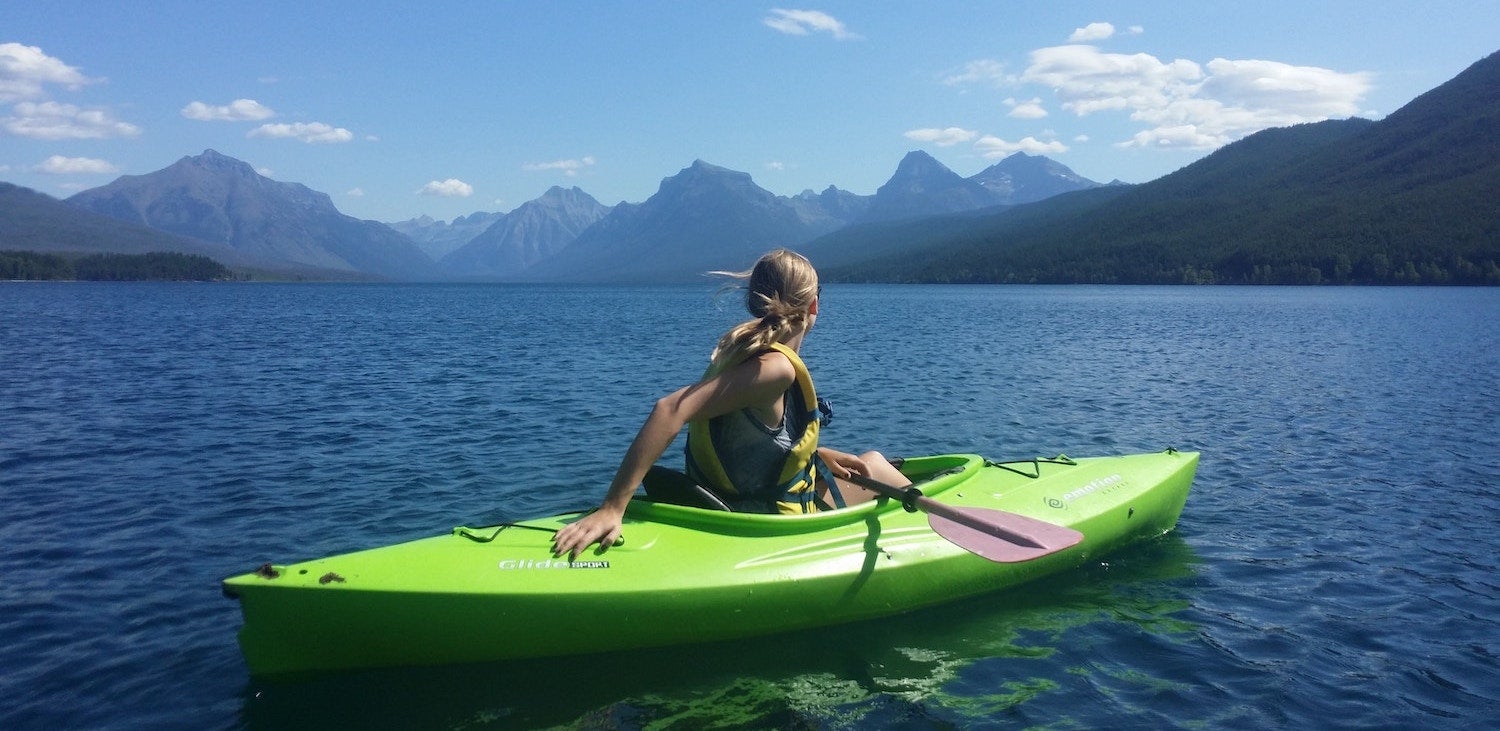
Rivers and lakes are features that we often seek out when camping. It is nice to have a place to cool off and spend the day. But what about using the water as your trail? Enter: kayak camping.
Kayak camping is similar to backpacking. You are camping and exploring long distance. The difference is, you don’t have to physically carry all of your weight on your back. Instead, you pack your kayak full of camping gear, and paddle away. You get the opportunity to enjoy the ebb and flow of the water, and explore places that might not be as easily accessible via a land route.
The Gear You Need for Your Next Kayak Camping Trip
There are still risks to using a waterway as your trail, but as long as you have the right gear, you can lower your risk, and increase your fun out on the water. With the help of my fellow Dyrt-bags, here’s a gear list to ensure that you have a great time on your kayak camping adventure.
For the Water
The kayak ($1,099).

You can’t kayak camp without a kayak. Though, full disclosure, and probably not much of a surprise, boats are not cheap. Kayaks built for touring or camping are no different. However, they are well-worth the investment if you plan to camp with your kayak often. Wilderness Systems’ Tsunami 125 is a kayak built for touring (long distance travel). This watercraft has two relatively large storage compartments, as well as bungies located on the top of the hull so you can tie extra cargo down. Whether you’re planning to embark on the open ocean, local stream, mountain lakes, or winding rivers, this kayak can handle it. If you’re just getting into kayak camping, and you aren’t ready to invest in your own kayak yet, try renting one from your local gear store first.
Prepare for your next adventure by downloading maps. The Dyrt PRO lets you download maps and campgrounds without cell service. “My alternative to using pro would be to drive back out to cell service”.
Kayak Paddle ($30)

No one wants to be up a creek, river, or lake without a paddle. This is why it’s important to purchase a floating paddle for your kayak camping trip. The SeaSense X-1 kayak paddle is buoyant and affordable. You won’t find a better paddle for this price. Regardless of how long your trip will be, don’t forget to pack a spare paddle ($36) as well, in the event you lose your primary one. We’re pretty sure that getting stuck in the middle of a lake isn’t on your camping itinerary.You can easily store a spare paddle by bunging it on the kayak’s deck.
Deck Compass ($55)
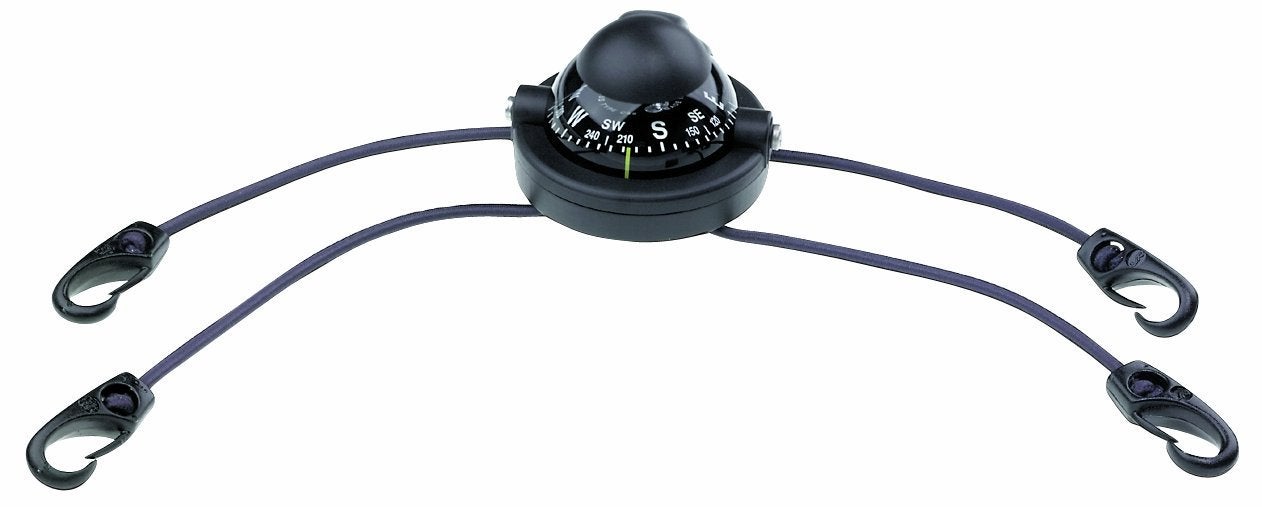
Whether you’re backpacking on dry land or kayak camping on waterways, you need to have a keen sense of direction, and a compass is often the key to that. Brunton’s kayak deck compass is waterproof and comes with straps so you can mount it on to your kayak deck. This is great to use on a foggy lake, a dim waterway, or if you’re ocean kayaking.
Dry Pack ($135)
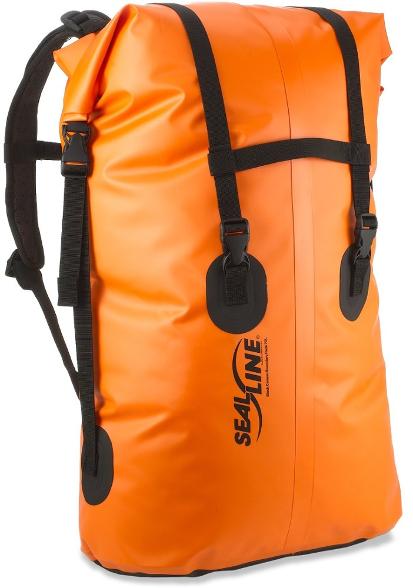
Dry clothing is a must on any camping trip. First, there’s the safety aspect — you need to be dry to stay warm. Second, wet clothing sticks to your skin like salt-soaked seaweed. It’s itchy, weighty, and most of all uncomfortable. A dry bag is an absolute must for kayak camping, and the SeaLine Black Canyon Boundary does not disappoint. Made with thermoplastic urethane encased nylon, this bag is perfect for long-distance paddling and camping. The straps also make it easy to transport when you’re on land.
Bilge Pump ($27)

In harrowing tales of boats taking on too much water, (and yes, we’re still sad about Rose and Jack in Titanic …) water in the hull is generally a bad thing. A swamped kayak can be uncomfortable, scary, and lead to a dangerous situation out on the water. Avoid that while kayak camping and get yourself a bilge pump. In kayaks and canoes, it can be quite common to get some water in the hull, given that the act of paddling can cause water to splash into the boat. This is why a bilge pump can be handy. Sea to Summit’s Solution Bilge Pump can extract almost half a liter from your kayak with its double action pump.
Kayak Repair Kit ($12)
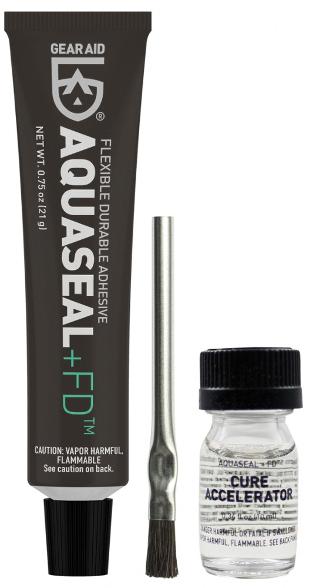
A bilge pump can help you bail out water, but it can’t repair a crack or hole from an unforeseen river rock. Good repair kits can help you get out of some rocky (pun intended) situations and get home safely. You can build your own repair kit using replacement rudder parts, bungie cords, static cord, bailing wire, a multi-use tool, sealant, and duct tape. Most of these kit items can be found easily at a local gear shop. As for a sealant, we recommend Gear Aid Aquaseal to keep repairs airtight.
For the Campsite
Waterproof headlamp $50.
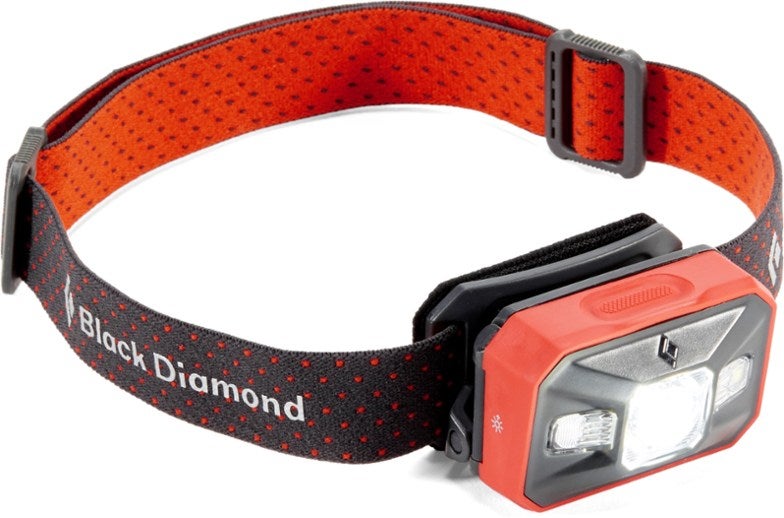
Most of the time, you kayak while the sun is out to play and head on land to set up your campsite before night rolls in. But just because the sun sets, doesn’t mean the fun have to stop. Black Diamond’s Storm Headlamp provides a bright beam to navigate the shoreline and the campsite. This headlamp is also waterproof, which is perfect for time spent paddling in the kayak.
Water Resistant Down Sleeping Bag ($299)
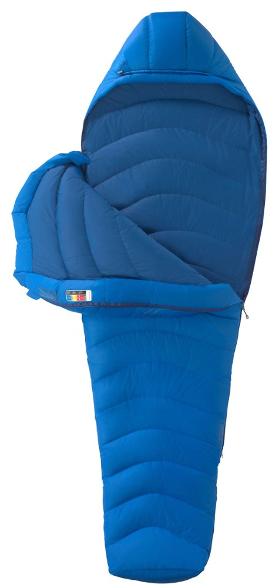
Wet sleeping bags are worse than wet blankets, that’s why the Marmot Helium Down Sleeping Bag is ideal for packing down in the kayak, and sleeping in at the campsite. The outer nylon has a water resistant finish, and the goose down has a Down Defender treatment so its more likely to resist water in wet conditions (like a boat). Plus, it maintains its warmth while still being lightweight. You’ll want to take this sleeping bag camping even if you’re not kayaking.
Lightweight Sleeping Pad ($130)

This sleeping pad is desirable for two reasons. First, it’s lightweight while still being comfortable. Second, it can be used as a lake floaty — we’re only half kidding. In all seriousness though, the Nemo Astro Lite Sleeping Pad comes with a built-in pillow, allowing you to pack one less thing. This sleeping pad also comes with a micro-adjust valve, which can help you reach your optimal inflation. With this pad, you’ll be dry, warm, comfortable all night long.
Multi-purpose Tent ($150)

A good tent can serve you anywhere–especially when you’re kayak camping. The Kelty Salida Tent is perfect for both the backcountry and for kayaking. It is easily packable, and so light you might forget about it altogether. This tent is ideal, whether you choose to kayak, backpack, or lay back and kick it at a campground.
Outdoor Water Filter ($40)
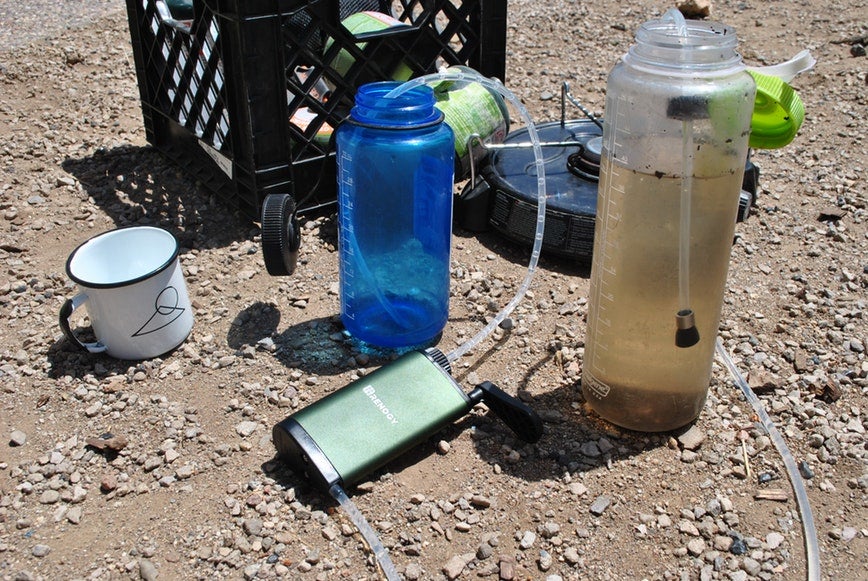
Photo courtesy of Dyrt Ranger Leah W.
When you’re on a kayak camping, you are surrounded by water. But it’s not a wise idea to drink straight from the source. This micro-water filter is packable, simple, and essential for any backpacking or kayak camping trip. Given some space restrictions in a kayak, it’s not always feasible to bring enough water for the trip. Renogy’s water filter ensures that you will be able to hydrate safely, so you won’t have to worry about giardia or cryptosporidium. This filter is designed for heavy use, so you can count on it lasting for plenty of kayaking, or backpacking trips, in the future.
Camping Stove ($115)
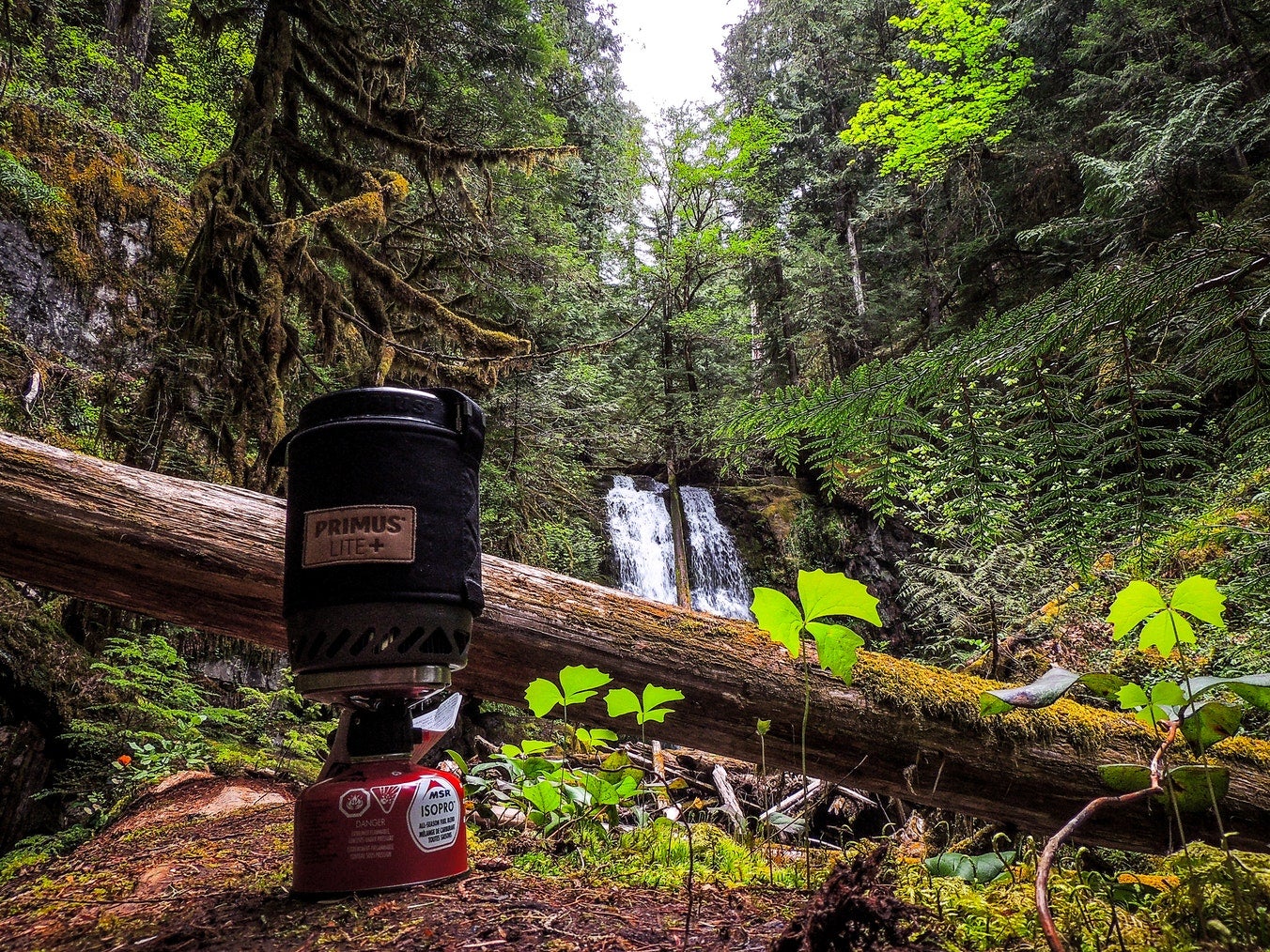
Photo courtesy of Dyrt Ranger Tj B.
A full two-burner camping stove can be a little much to bring for a kayak camping trip. The Primus Lite+ is a sturdy and compact, all-in-one camping stove that is easy to pack, and can whip up really quick dishes. This stove is built more for the solo backpacker or kayak camper, so if you want to share a stove, check out the Lite XL camping cookstove .
Food Utensils ($3)

Photo courtesy of Dyrt Ranger Chanel C.
Unless you plan to get your hands real dirty, you probably want to pack some utensils. That way, you can enjoy your camp cooking without the mess. GoBites can go from your home, into the backcountry, or to your kayak. They are versatile, BPA-free, and have a lifetime warranty. That means you can twirl endless amounts of spaghetti, right?
Soft-Sided Dry Bag Backpack Cooler ($100)
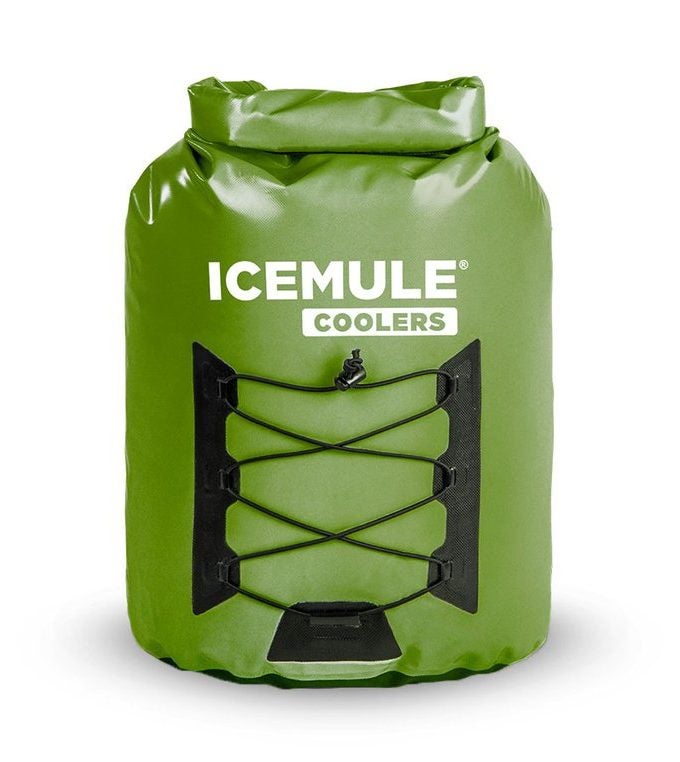
Coolers aren’t always the most mobile cargo, but it’s vital that you keep your perishables cold if you’re not opting for freeze-dried meals throughout your camping trip. The ICEMULE Pro backpack cooler is a handy backpack cooler that keeps your delicious food fresh, and you can just toss it on your back when you portage or hike to your campground. So, if you can manage the weight, don’t forget to pack the beers.
Water Resistant Duffel ($120)
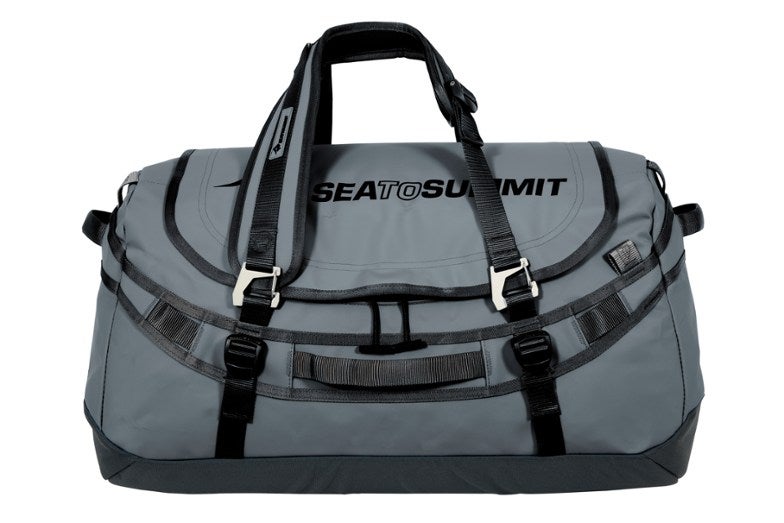
Whether backpacking or kayak camping, no one wants to get their clothes wet–though in kayaking, it’s a real cause for concern. This Sea to Summit duffel is perfect for kayak camping thanks to the waterproof material (though the zipper is not, so hopefully you and your cargo won’t be taking a swim). You can convert it into a backpack, too, which will make it easier to portage with your kayak and cargo. If you’re really getting after it on a river trip, and are concerned with water seepage, check out YETI’s Panga 75L Submersible Duffel , which is completely waterproof.
For Your Safety
Paddle-friendly pfd ($55).
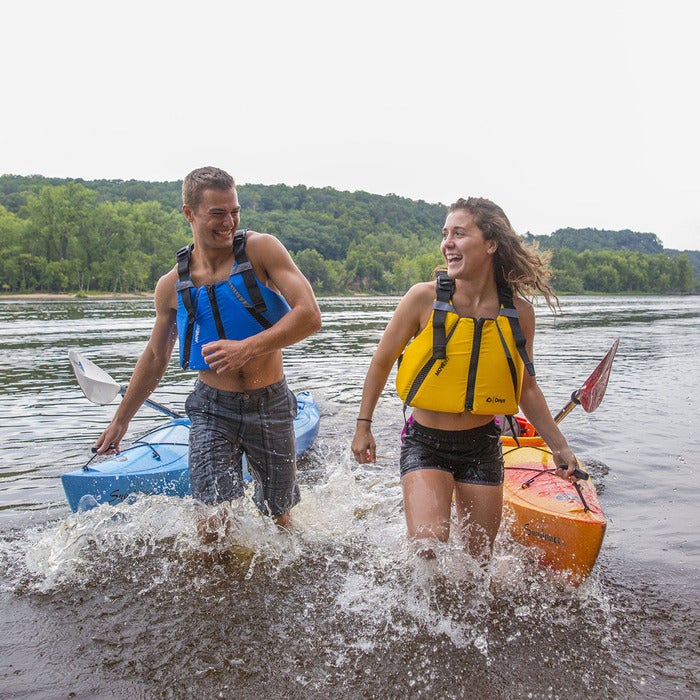
If you’re kayaking or canoeing on any type of water-way, you need a personal flotation device to ensure your safety. The Onyx MoveVent Curve Vest is made with the kayaker in mind, as it provides breathable mesh in the back so you don’t get too hot against the seat. It’s soft, lightweight, and flexible, which ensures that you’re comfortable, while staying safe– which is what really matters.
Waterproof First Aid Kit ($50)
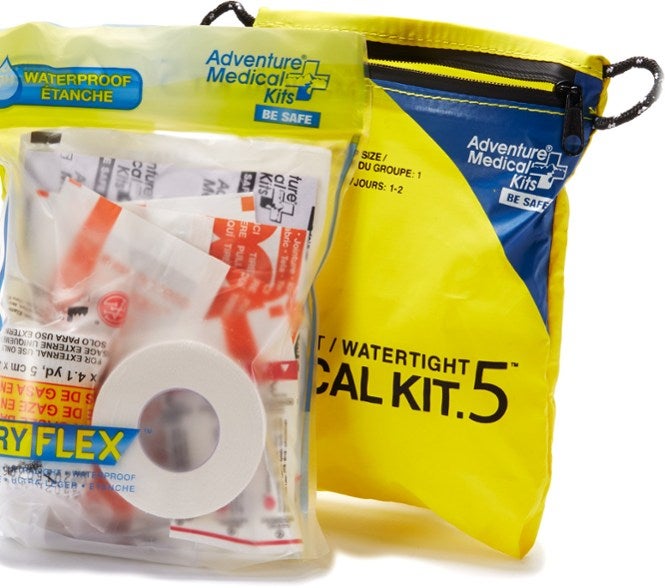
No matter what kind of hiking, camping, or backpacking you do, you should always carry a first aid kit. After all, you never know when something unexpected will happen. Most first aid kits should cover the basics: bandages, gauze, topical cream, and various medication. We recommend Adventure Medical Kits UltraLight / Watertight .5 First-Aid Kit . It comes with a waterproof case, which is perfect for days spent on the water.
Rescue Signal ($261)
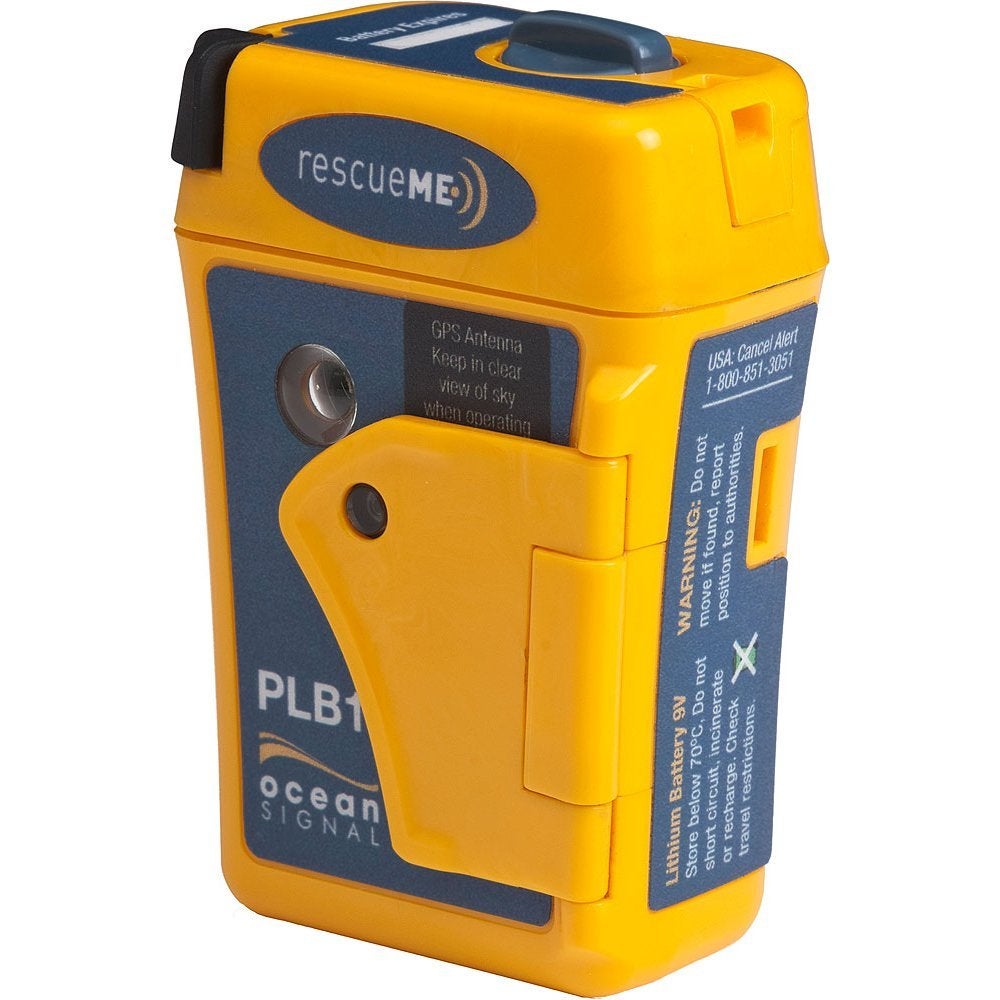
Situations sometimes come up when you need outside help, and you need it fast. A personal locator beacon can help you or a friend contact help even if cell service is not available. The Ocean Signal rescueME PLB1 has an emergency button that you can press if a situation is dire, and a signal will be sent via satellite to a rescue crew with your location. This PLB also floats–making it ideal for marine environments. The rescueME PLB1 is purely for SOS signals and does not enable two-way messaging. If you want the ability to message others, consider the Garmin Inreach Explorer+ at a much heftier price.
Knife ($45)
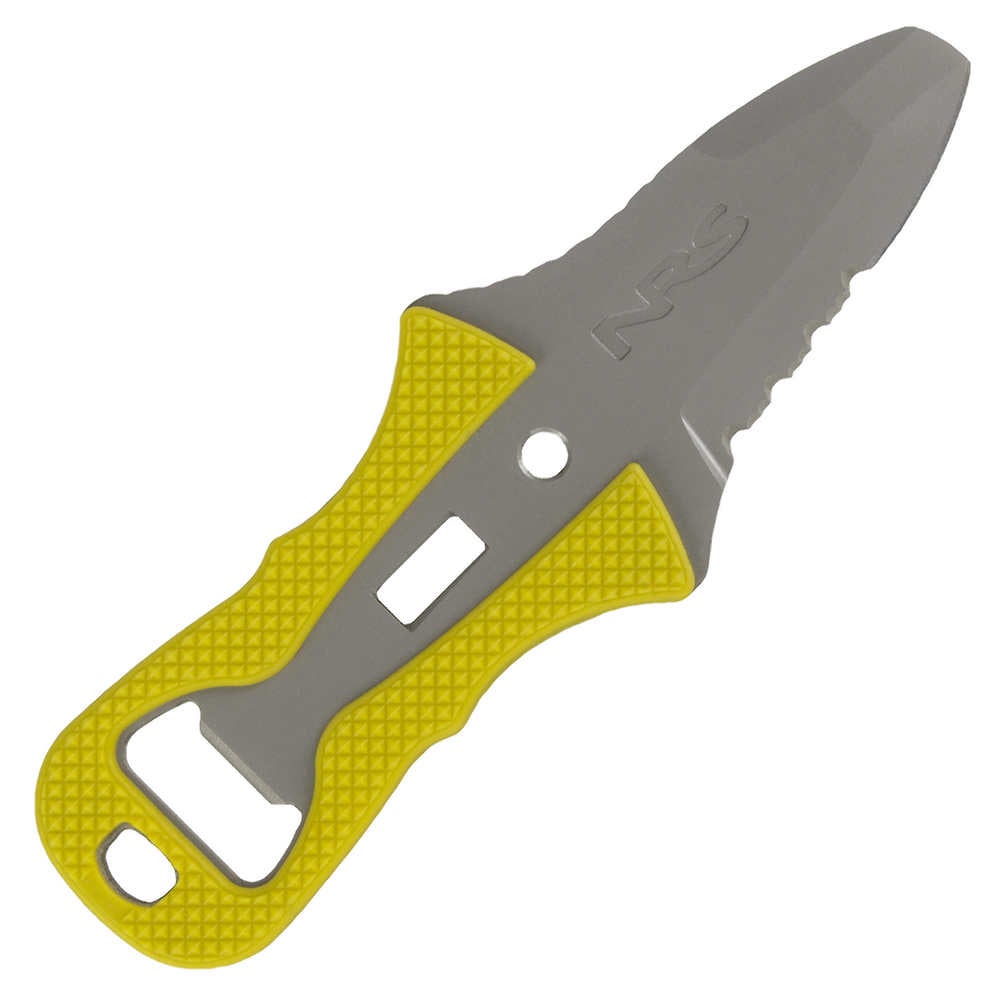
While a personal flotation device is a likely choice for safety, a paddling knife can easily go overlooked if you’re not a seasoned kayaker. Especially if you are participating in a river trip, a paddling knife is crucial. You never know if a situation might come up where you have to cut yourself away from your kayak. The NRS Co-Pilot Knife can clip onto your PFD with ease, and has two blunt sides, ensuring that you don’t get injured if you’re in a bind. The sharp side is serrated, so that you can cut through anything. If you plan to ocean kayak, be sure to get the titanium version so rust won’t be a problem.
Walkie Talkies ($70)
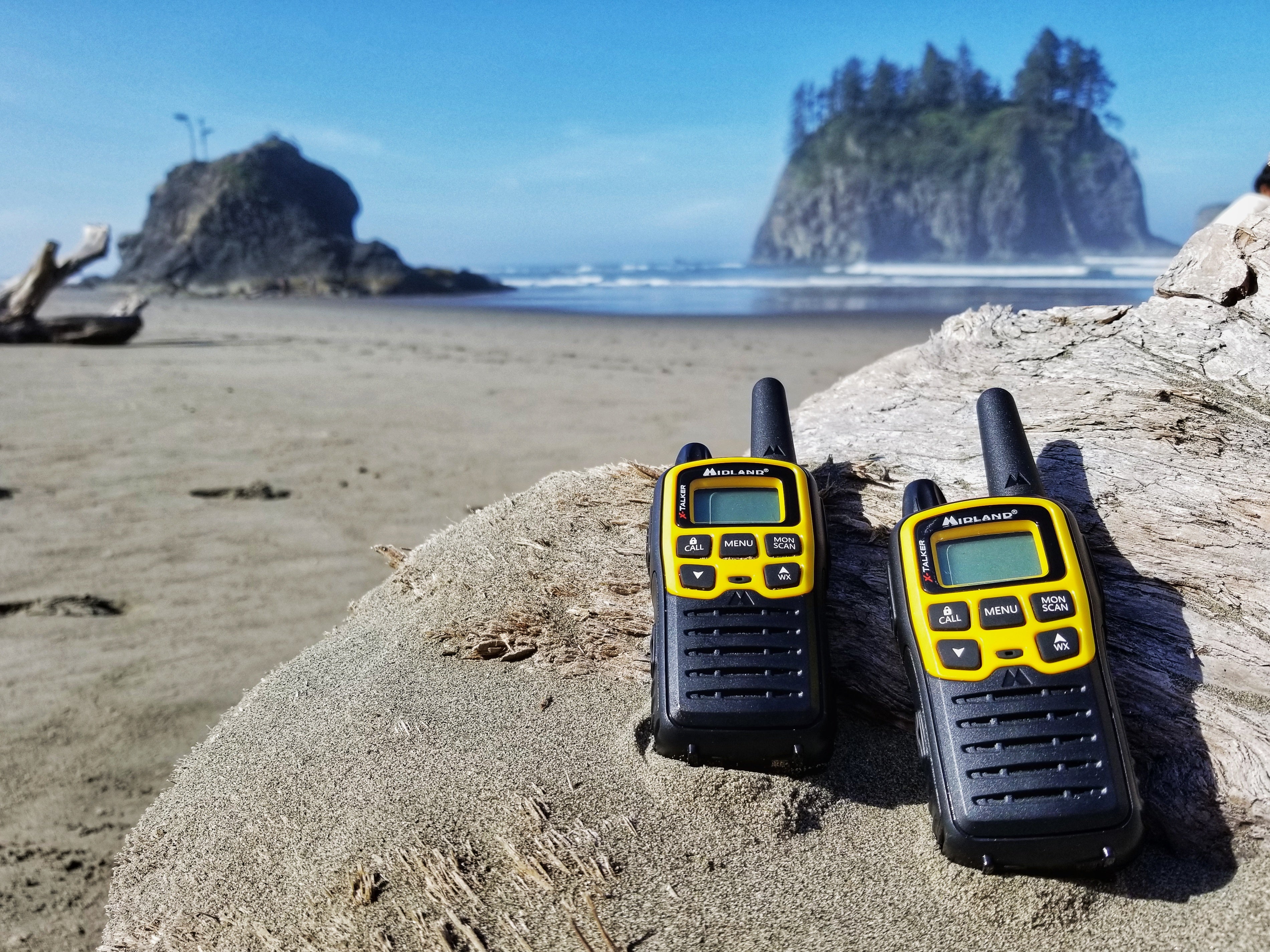
Photo courtesy of Kayla Haas .
If you’re kayak camping with friends in a remote area, there is a chance that you might get separated on or off the water. Midland’s X-TALKER T61VP3 walkie talkie can help you stay connected with your fellow kayak campers. These walkie talkies can also alert you and your party to what kind of weather might be rolling in.
Sunscreen ($36)
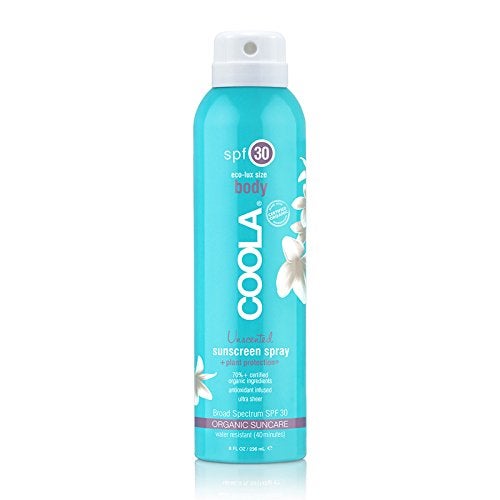
Plain and simple: UV rays are dangerous and being sunburned can ruin a camping trip. Lather up! COOLA Sport Continuous Spray keeps the grease off your hands, has a high SPF, and works while you sweat.
For Your Body
Rash guard ($78).
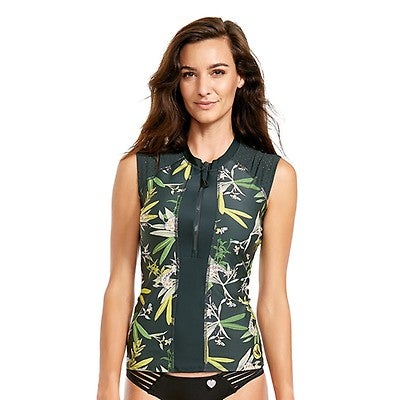
Though it might be the first thing that comes to mind, your bathing suit isn’t always the most practical item for a kayak camping trip. We definitely understand that you want to wear something that can easily get wet and dry off quickly. Body Glove’s Guava Exhale Rashguard is a great compromise–you can get wet, stay stylish, and be protected from the sun while you’re paddling. They offer a men’s version , too.
Rain Jacket ($189)
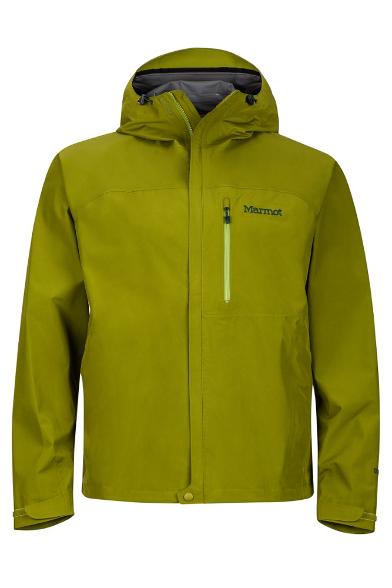
You should always prepare for a chance of rain in the forecast. Some places this might be less likely, like Death Valley , but you know what we mean. Being on or by the water means you can easily run into a rain storm that was not expected. The Marmot Minimalist Rain Jacket is great for staying active in the rain thanks to the waterproof, breathable shell. This rain shell is also perfect for backpacking given that it’s lightweight and tailored for movement. Don’t forget the Marmot Minimalist Pants for a full set.
Water Shoes ($80)

Hiking might be on your itinerary when you get to your campsite, but a lot of your time will be spent in your kayak or around the water. It’s important to have a comfortable, waterproof shoe that can transitions from land to sea. Vivobarefoot’s Ultra 3 Bloom is flexible and has great traction when they are wet or dry. These amphibious shoes are made using an algae, which also contributes to their sustainability, so you can feel good while wearing them.
Adventure Hat ($39)
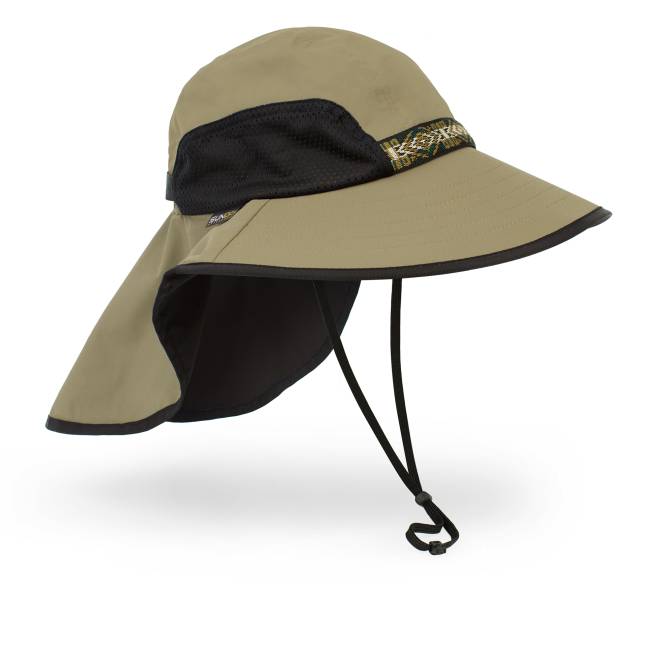
We’ve covered that sun protection is super important. A hat can also help protect you from strong UV rays. The Sunday Afternoons Adventure Hat has a four inch brim, and a flap back to keep you protected. It is also made out of lightweight material, so it is comfortable to wear. The best part of this hat for kayak camping? It floats. So if a gust of wind catches it, you won’t be in need of a replacement.
You can win free gear from Brunton and 19 other outdoor brands by reviewing campgrounds on The Dyrt. Share past camping experiences, photos, and videos to earn points towards monthly prizes in The 2018 Great Camping Giveaway !
Popular Articles:
- Get the Latest 2023 Camping Travel Trends
- How To Find Free Camping in National Forests
- The Checklist Every First Time RVer Needs
- Find Free Camping With The Dyrt Map Layers
- The Ulimate Boondocking Guide To Free Camping
- Everything You Need To Know About Wifi For Your RV
- 7 of The Best Overland Routes in North America
- 14 Wilderness Survival Tools You Should Have in The Backcountry
- Here's What To Add To Your Primitive Camping Checklist
Kristen Byrne
Kristen is a journalist turned digital account manager at The Dyrt. She has worked for various TV stations and newspapers, and now focuses on content creation for tech-loving outdoor enthusiasts. Chances are good she's outside, hiking, climbing, skiing, or exploring. Just know that you can count on her to bring canned wine to the campfire.
More Articles
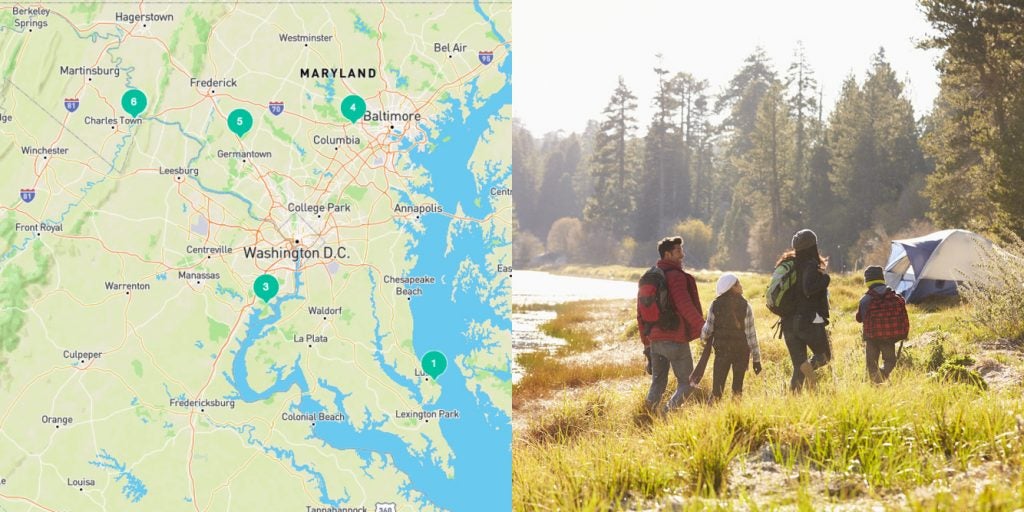
Choose Camping Near DC the Whole Family Will Enjoy
With each passing year, Washington DC continues to attract a record number of tourists, drawing 20.8 million visitors from within the United States alone in…

Ranger Camping Recipe: Quick and Easy Pad Thai (in a Dutch Oven!)
Oil leaking in your camp bin? Full ketchup bottle won’t fit in the cooler? Humangear has a solution: the GoToob+. Their new and improved silicone…
- svg]:stroke-primary"> 735K
- svg]:stroke-primary"> 133K
- svg]:stroke-primary"> 54.1K
The Best Kayaks for Camping of 2023
By Ben Duchesney
Updated on Apr 19, 2023 11:42 AM EDT
14 minute read
Best Overall
Old town next, best for river camping, jackson coosa, best for fishing and camping, old town sportsman pdl 120.
We may earn revenue from the products available on this page and participate in affiliate programs. Learn More ›
There’s no better way to spend time outside with your friends and family, or even by yourself, than taking out a kayak for a camping trip to your favorite river or lake. Camping by kayak is an efficient way to pack everything you need for multiple days on the water and for nights spent on land. No matter the season, kayak camping allows you to pack more gear, be more comfortable both on and off the water, and spend your days paddling or fishing without worrying about heading home at the end of the day. Check out my picks for the best kayaks for camping that fit your needs, your camping style, your skill level, and of course, your budget.
- Best Overall: Old Town NEXT
Kayaks Best for River Camping: Jackson Kayak Coosa HD
- Kayaks Best for Fishing and Camping: Old Town Sportsman PDL 120
Kayaks Best for Multi-Day Trips: Wilderness Systems Tsunami 125
- Best Tandem Kayak for Camping: Native Watercraft Ultimate FX 15 Tandem
- Best Inflatable Kayak for Camping: Advanced Elements AdvancedFrame Expedition Elite
- Best Budget Kayaks for Camping: Pelican Kayaks Catch Classic 120
Things to Consider Before Buying a Kayak for Camping
Choosing the best kayak for camping is like choosing a best friend for a camping trip. How well do you know the person you’re about to spend time with out in the woods? Maybe you want to dedicate yourself to learn how to catch big fish from a kayak by spending more serious time outside. If you’re choosing an untested, brand-new kayak that you haven’t spent time with before, camping with it may require an adjustment period.
Luckily, your camping kayak can’t argue with you. No matter what kayak you choose to take camping, whether you’re solo, going with a group of friends, or bringing the entire family along, there are certain questions to consider before setting out. When deciding on the best kayak for camping, consider the following points:
Canoes vs. Kayaks for Camping
Diehard canoeists will say that a kayak is not the right tool for a camping trip. They’re wrong. While canoes have a long history of carrying paddlers and gear across vast wilderness around the world, the kayak is also a tool designed for carrying people and gear. Which is better for camping a canoe or kayak? It depends on the body of water and your camping location or route. For example, if you have multiple portages across miles of tricky terrain, a canoe is the better choice, as it’s easier to balance across one person’s shoulders. If you have a solid kayak cart, however, a portage with a camping kayak—or even a canoe—becomes a piece of cake. If you’re going solo, a kayak is likely a better choice, as it gives you more control than a canoe while paddling solo. Learn how to motorize your fishing kayak and then canoes will start looking less interesting, especially if you’re solo.
Storage Capacity
The most obvious question when deciding on a camping kayak is whether or not it can fit all of your gear. While some larger kayaks, especially fishing kayaks, are known to have a large enough capacity to fit all of your gear, think about what you really need to bring on your camping trip. Overpacking often leads to sore backs and frustration. It’s better to match the right level of gear to the camping kayak that can fit all of the necessary items—without going overboard. Par down your list of equipment to the essentials, and then find the camping kayak that can comfortably fit it all. Also, remember that you still need to be able to paddle your kayak across the water after it’s been fully loaded with all of your supplies. Many of the best fishing kayaks feature a lot of storage capacity, which is why a number of them appear on this list.
Your Camping Location or Route
When you’re planning your overnight stay in the woods with your kayak, consider the location. Are you planning to paddle to your first campsite or do you need to walk all of your gear to a put-in that’s away from your parking spot? That means you need a kayak, and gear, that you can carry easily.
If you’re planning a kayak camping trip with multiple stops along a paddling route, for example, make sure to take the portage routes into consideration. It may be easy to paddle all of your gear across a body of water, but if you need to portage your gear between lakes, each piece of gear becomes a liability.
Best Overall Kayak for Camping: Old Town NEXT
Key features .
- Length: 13 feet
- Width: 29 inches
- Weight: 59 pounds
Why It Made The Cut
The debate between canoes vs. kayaks is a tough one, especially when it comes to bringing one on a camping trip. Luckily, with the Old Town NEXT, you don’t have to choose between one of the other. This boat is designed as a sort of hybrid between a canoe and a good kayak for camping, making it the perfect craft for bringing along all of your gear on a camping trip. The lightweight hull design also lends itself to being a joy to paddle at the same time, meaning you’ll love this boat both on and off the water.
- Light and balanced
- Easy to carry
- Comfortable seats
- Not stand-up-fishing friendly
- No sealed hatches
Product Description
Why choose between a canoe or a kayak when you can have the best of both worlds. With the Old Town NEXT , you not only get the gear storage capabilities and comfort of a canoe, but you also get the stability and paddling position of a kayak. The Element seating system is more comfortable than any wicker canoe seat around, and the boat is designed for both double blade and single blade paddlers alike. Your gear will be a little more exposed to the elements since there are no sealed hatches, like on other camping kayaks, but you also won’t have to worry about fitting your tent poles through the narrow hatch opening either. Whether you’re going camping for a brief overnight or a multi-day trip, solo, with friends, or with family, the Old Town NEXT is the perfect craft. It blends all of the best features of modern camping kayaks with the storied tradition of a canoe, all in a comfortable package that you can afford.
- Length: 12 feet 6 inches
- Width: 34 inches
- Weight: 83 pounds
The kayak company that got its start building whitewater kayaks for fast-moving rivers has the perfect solution for river camping as well. The Jackson Kayak Coosa HD is a solid platform for camping by your favorite river, as it offers plenty of storage space, paired with a nimble, stable hull.
- Comfortable seat
- Easy to paddle in moving water
- The shape of the rear hatch sometimes makes it difficult to fit some of your gear inside.
How do you pack a kayak for a river trip? Especially if there is the potential for whitewater rapids along your trip, you pack a kayak for a river trip with the expectation of flipping it over. Anything that needs to stay 100 percent dry should be packed away deep inside the sealed hatches at the bow or stern. Anything that can get wet can be stored in the rear tankwell but should be latched to the kayak in case you do flip. The chance of flipping in the Jackson Kayak Coosa HD is slim, however, as this kayak is nimble enough to navigate swift water that might lie between your camping spots. The stable hull was actually designed as a fishing kayak, but the features lend themselves to kayak camping perfectly. The comfortable seat means your back will thank you after a long day of paddling, and you’ll still have the energy to set up camp. The rod holders and other rigging also allow you to fish while you’re paddling, which is recommended on a river camping trip, as rivers always have the best fishing.
Kayaks Best for Fishing and Camping: Old Town Sportsman PDL 120
- Length: 12 feet
- Width: 36 inches
- Weight: 116 pounds
Fishing kayaks are a great choice for camping kayaks for their storage capacity, but also for their versatility and stability. They’re also great to fish from, and what better activity is there to waste away a day at camp than tossing out a line and catching a few fish. The Old Town Sportsman PDL 120 is the best sit-on-top kayak choice designed for both fishing and camping. It was designed as a fishing kayak first, but there is plenty of storage in the bow hatch and rear tankwell to fit all of your camping gear.
- Durable pedal drive
- A lot of storage space, including dry storage.
The introduction of pedal kayaks to the paddling world caused quite a stir. One of the first and often-used disses from paddlers to pedal kayaks was the ability to move backward without having to take out and reverse the pedal drive system or pulling a cord to enter into reverse. The Old Town Sportsman PDL 120 doesn’t have that problem. Its pedal drive system can move forwards and backward seamlessly and feels similar to riding a bicycle. This makes hands-free navigation––and in this case, hands-free fishing––a simple and enjoyable feat. The stern tankwell on this fishing kayak is giant, meaning you can store all of the gear that doesn’t need to stay completely dry within easy reach. The bow hatch can store anything else that may need to stay completely dry, such as your sleeping bag or tent. The padded cockpit makes standing up to fish nice and comfortable. When you’re sitting down, the seat design is ergonomic and supportive, which means you’ll still be comfortable at the end of a long day of paddling and fishing.
- Length: 12 feet 9 inches
- Width: 26 inches
- Weight: 51 pounds
The success of a multi-day camping trip is usually decided by the quality of the gear that you bring along, as well as the company you chose. We can’t help you bring along better company, but the Wilderness Systems Tsunami 125 is one of the kayaks best for long trips and can be trusted to hold up throughout your expedition. There is plenty of storage, and the roomy cockpit is designed for larger paddlers, so you won’t ever feel cramped, even though this is a sit-inside kayak.
- Light
- Plenty of storage
- Paddles fast and easy
- Not as stable as a sit-on-top kayak
While many paddlers would likely choose a sit-on-top for their camping trip, especially if they’re used to fishing from their kayak, a sit-inside kayak like the Wilderness Systems Tsunami 125 is perfect for multi-day trips because of the storage capacity within the hull. The roomy cockpit of this camping kayak is also designed to accommodate larger paddlers, so nobody should feel cramped or claustrophobic, even after a full day on the water.
The quick-access mesh deck gear pockets allow you to stash essential gear that you may need throughout the day within easy reach. The two hatches, on the other hand, are better suited for storing the camping gear that you’ll only need once you make it to camp. Those hatches also offer better protection against getting wet, although the type of hatch cover can sometimes be hard to take on and off. The lightweight design of this kayak makes it easy to carry around camp or to and from your car, so you’ll never hesitate to take it out for a paddle, which may end up giving you more days on the water.
Best Tandem Kayaks for Camping: Native Watercraft Ultimate FX 15 Tandem
- Length: 15 feet 3 inches
- Width: 31 inches
- Weight: 80 pounds
Another craft to fit into the canoe and kayak hybrid category, the Native Watercraft Ultimate FX 15 Tandem is even more unique because it’s a tandem designed for two people. How much storage is in a double kayak? You’d think that a tandem kayak would fit twice as much camping gear as a single-person kayak, but remember that two people take up a lot of space. The Ultimate FX 15 Tandem uses that space carefully, coming together in a package that’s purpose-built for paddling with stability and comfort.
- Comfortable
- No sealed hatch
Native Watercraft was one of the first companies to introduce a comfortable seat on their kayak, and the Ultimate FX 15 Tandem features that same First Class seating setup, but with more adjustability than ever. Both paddlers will be comfortable all day long in this tandem kayak and have plenty of storage space around them to keep essentials close. There are no sealed hatches on this boat, however, so any gear you do bring along should be kept in dry bags or underneath a tarp covering. This tandem kayak is designed to carry two people and all their gear comfortably, but it can still be carried by only one person with ease. The low weight feels even lighter since the open deck design can be well balanced on your shoulders, much like a canoe would be carried. The adjustable foot pedals allow you to tailor the seating position to your liking, and there is a small cup holder for each seat to let the libations flow during your long, hot days on the water.
Best Inflatable Kayak for Camping: Advanced Elements AdvancedFrame Expedition Elite
- Weight: 45 pounds
Inflatable camping kayaks can be useful tools, especially for those paddlers that live in smaller apartments without the space to store full-size, rigid kayaks. The Advanced Elements AdvancedFrame Expedition Elite is a versatile inflatable kayak with just enough storage to make a camping trip worthwhile. The fishing-focused hull means you can spend quality time on the water in between camping spots and successfully land your target fish.
- Deck covers at the bow and stern allow you to store gear without it getting wet.
- No sealable hatches
- You’ll want to bring along a pump just in case the boat deflates overnight or during the course of your trip.
- High seating position means your center of gravity is higher and less stable.
Inflatable camping kayaks offer those without the storage options for a full-sized, rigid kayak the ability to paddle, camp, and fish to their heart’s content in just a few short minutes. The Advanced Elements AdvancedFrame Expedition Elite takes only seven minutes to fully pump up, and once it’s inflated, it provides a stable, comfortable craft for all of your camping and paddling needs.
The boat is designed with four chambers, meaning you’re less likely to lose air during the course of the trip. Even if there is a puncture, the other chambers could stay inflated longer while you get yourself back to camp to fix the leak. Those chambers also contribute to the stability of the camping kayak, which is comfortable for one person but can support up to three people at once. The hull is also rated for whitewater, up to Class II, in case your camping route takes you through some swifter rivers.
Best Budget: Pelican Kayaks Catch Classic 120
- Length: 11 feet 8 inches
- Weight: 68 pounds
As stated above, some of the best fishing kayaks under $1,000 would double as a budget kayaks for camping due to the excess of storage options on fishing kayaks. Take, for example, the Pelican Kayaks Catch Classic 120. This boat is less than $700 and features both plenty of storage, and a few fishing features that will make those long days on the water a blast.
- Good storage
- The lightweight and low deck height mean this kayak can get blown around by the wind
Budget camping kayaks shouldn’t be cheap or low quality. The Pelican Kayaks Catch Classic 120 is a serious kayak for the price, with enough features to make the serious kayak angler happy, and plenty of storage for an overnight camping trip with friends or family. It’s easy to stand up in this super stable boat, although the non-padded deck may tire out your feet after a few hours.
The lightweight makes it super easy to transport this fishing kayak from your car or truck, not to mention any possible portages along your camping route. The sealable hatch in the bow lets you store your camping gear away from the water, and a large stern tankwell is big enough to store anything else that you may want to access throughout the trip. The expansive flat deck is open enough that you can fish and paddle all day comfortably, without feeling shut in like you would with a sit-inside kayak.
What you need for a kayak camping trip depends on many factors, including where you’re going, the type of water you’ll be paddling on, how many days you’ll be on the trip, and the number of people in your camping party. At the very least, you’ll need something to sleep in, either a full tent, a simple lean-to set up, or just a simple sleeping bag. You’ll also need cooking supplies and food. It’s also a smart idea to carry a first aid kit and other emergency supplies in case you get into trouble out in the woods. Other kayak-specific items like an extra paddle and an extra PFD can also be trip-saving, or life-saving, additions to your equipment list.
How much stuff you can fit in a kayak depends largely on the type of kayak you have, the type of camping gear you’re packing, and of course, your skills at the game Tetris. There have been some paddlers that can pack a month’s worth of supplies and gear into a camping kayak. Others can barely fit everything they need for a single overnight stay. At the very least, you should be able to fit a tent, a simple cooking setup, your food, simple fishing gear, and a few extras into the hull and hatches of a camping kayak with ease.
Packing a kayak for camping means organizing your gear by need. Emergency items should also be easy to grab quickly without opening anything, in the cockpit, on a lanyard, or on your PFD, for example. You should have the items you’ll need on the water at the top of your hatches within reach. Further down in the larger hatches should be the items that you won’t need unless you’re at camp. Finally, the items that you want to keep as dry as possible should be stored deep within your kayak’s hull, as far away from the water as possible.
Final Thoughts
The best kayak for camping will allow you, your friends, and your family, to spend time outside as close to nature as possible. With the right kayak, you’ll be able to pack and carry all of the gear you need, enjoy your time on the water, and camp as luxuriously as you like without concern. The Old Town NEXT is a prime example of a camping kayak that checks all of the boxes. It carries all of your gear but remains agile enough to paddle and carry without breaking a sweat. Try this camping kayak on your next trip to be the envy of all your paddling buddies.

Packing a Kayak for camping
How to pack your sea kayak for an overnight or multi-day camping trip.
“There is no unhappiness like the misery of sighting land and work again after a cheerful, careless voyage.” Mark Twain
At some point early in our paddling lives, perhaps when we find ourselves approaching the end of a long paddling day but still a few miles from the takeout, we get to wondering.
“What if,” we surmise, thoughtfully stroking our stubbled chins, “I didn’t have to go home? What if I had, right here inside my boat, all the stuff I needed to eat and sleep and be comfortable for a night? Maybe two …?”
And so the ancient art of paddle-camping is rediscovered. But be careful; it was exactly this sort of fanciful reasoning that caused many a voyageur and mountain man to head for the woods, never to be seen again.
Following are some tips and pointers to help make your own overnight kayak-camping adventures a bit more enjoyable.
If you’ve recently made the transition from car camping, you may wonder where in your kayak to stow the cast-iron Dutch oven, chaise lounge, and beer cooler. Kayak camping is not as restrictive as backpacking, but almost. Even much of your favorite gear that is easily swallowed by a canoe will have to be left behind when kayak camping, so some strict discipline is in order.
Size Matters
You’ll probably find it easier to use lots of smaller drybags instead of a few larger bags, to better adapt to the oddly-shaped interior of most kayaks. Your bags should be color coded for organization, and perhaps even labeled with identifying tags. Heavy vinyl bags are alright for food, as they are more resistant to puncture and probably allow less bear-attracting odor to waft through the woods, but they stubbornly stick to one another when packing into the boat. Most of my favorite bags are instead made of lightweight nylon or polyester fabric with an internal rubberized waterproof coating. Though perhaps requiring a bit more care to prevent punctures, these bags easily slide past one another when jammed into a cargo compartment, making packing more efficient. As you close each drybag, be sure to squeeze out as much air as possible before rolling down the neck seal, to conserve precious space inside your compartments.
Keep Your Balance
Heavier items like food and water should be packed near the middle of your kayak, preferably just behind the rear bulkhead, while lighter, bulky items like sleeping bags and clothing get packed toward the ends. Everything should be packed low and centered from side-to-side, to keep your boat stable and balanced. The only exception to these general rules is if you need to re-trim a boat for better handling. When one of my paddling partner’s skeg cable broke halfway through a trip, he wisely loaded his boat a little stern-heavy the following days, to alleviate weathercocking.
A few days before your first overnighter, try test-packing your kayak to see if all your intended gear will indeed fit. It probably won’t. As you choose items that won’t make the trip, just remind yourself that the whole purpose of kayak camping is to get away from it all.

Sign up for “ Fetch,” the newsletter of Superior Paddling! Be the first to know about new or featured how-to articles, product reviews, and destination trip reports, plus other sea-kayak events, news, and more.
A Packing List
I offer below my current personal packing list, suitable for multi-day, self-supported sea-kayak trips on the Great Lakes or inland waterways. I am constantly tinkering with this list, as evidenced by the revision number above, and will post new ones here as they evolve.
You will undoubtedly wonder about certain items on my list (“A candle lantern? No GPS? What are you, Amish?”). So by all means, feel free to add and delete gear to make it your own personal packing list.
Believe it or not, all this stuff fits through the hatches of 14- to 18-foot sea kayaks, though sometimes I wonder how. If you’re paddling with others, there is no need to duplicate some of the equipment such as tents and cookware, but it’s often wise to have a spare stove or water filter, so use your best judgment, and hit the water!
- Kayak with all hatch covers, etc.
- Deck Compass
- Paddle w/ Leash
- Spare Paddle
- PFD: VHF Marine Radio, Emergency Strobe, Laser Flare, Whistle, Knife, Compact Compass & Thermometer, Waterproof Camera, Micro First-Aid Kit
- Spray Skirt
- Paddle Float
- Sponge & Bailer
- Mapcase: Maps, Charts, Guidebook Excerpts
- Hydration Pack (with optional Bailout Kit)
- Waterproof Binoculars
- Spare Camera Batteries & Memory Cards
- Sunscreen, UV Lip Balm, Pain Reliever
- VHF Marine Radio Protocol Cheat Sheet
- Waterproof Notepad & Pen
Dayhatch or other accessible location:
- Water Bottles
- Coffee Thermos
- First-Aid Kit
- Signal Flares, Air Horn & Spare Air Can
- Waterproof Headlamp
- Compact Photo Tripod
- Small Towel
- Latrine Kit: Trowel, Toilet Paper, Hand Sanitizer
BAILOUT BAG / DITCH KIT / SURVIVAL Containing emergency survival gear
KAYAK REPAIR KIT Containing emergency repair supplies and tools
PADDLING CLOTHING
- Synthetic Undershorts or Swim Trunks
- Synthetic Long-sleeve Top
- Synthetic T-Shirt
- 0.5mm Neoprene Long- or Shortsleeve Wetsuit Shirt
- Farmer John Neoprene Wetsuit
- Water Shoes
- Synthetic Socks, 2 Pairs
- Gloves: Short Bicycling or Neoprene Wetsuit w/ Synthetic Liners
- Hat: Baseball or Wide-brim
- Eyeglass Tether
PADDLING CLOTHING, Optional, in mesh bag inside cockpit
- Drysuit or Drytop
- Neoprene Wetsuit Booties
- Synthetic Balaclava or Watch Cap
- Tent w/ Ground Cloth, Extra Stakes
- Rain Tarp, 10×10′, w/ Stakes
- Sleeping Bag
- Sleeping Pad
- Bear Bag Kit: 1/4″ Synthetic Line, 30′, w/ Carabiners
- Clothesline, 20′
SHELTER, Optional:
- Sleeping Bag Liner
- Complete Sleeping Hammock Rig
- Bear Repellent Spray
GENERAL CLOTHING
- Synthetic Undershorts, 3 Pair
- Synthetic Fleece Long Underwear PJs: Top & Bottom, Sleeping Socks
- Camp Shirts, 2
- Socks: Long and Short; 2 Pair each
- Short Hiking Shoes
- Convertible Pants
- Synthetic Fleece Jacket
- Waterproof-Breathable Rain Jacket
- Synthetic Gloves
- Trash Bag for soiled clothes
- Insect Repellent
- Insect Headnet
- Waterproof Headlamp, Spare Batteries
- Compact Handheld Flashlight, Spare Batteries
- Candle Lantern
- Orienteering Compass
- Book, Journal, Pen
- Misc. Drybags, Duffels, Mesh Ditty Bags, Ziplocks, Tough Trash Bags w/ Rubber Bands
- Food; (packed in durable vinyl drybags)
- White-Gas Stove w/ Fuel, Priming Alchohol, Lighters; (approximately one ounce of fuel needed per meal)
- Cookware w/ Handle
- Eatware: Bowl, Mug, Dining Utensils
- Foil Lunch Pouch for Cold Foods
- Coffee Filter
- Salt & Pepper
- Water: Filter, Bottles, Jugs (personal & community), Extra Caps
- Dish Soap w/ Scrubby, Pot Scraper
- Hand Sanitizer
- Kitchen Knife
- Small Dish Towel
- Firestarting Sticks, Matches, Lighter
- Ziplock Heavy-duty Freezer Bags for Trash, 1-gal
IN CAR FOR DRIVE HOME
- Large Trash Bags for wet stuff
- Street clothes
- Cell Phone Charger
What do you think? Leave a question or comment below, and use the social links to share with friends!
Similar Posts
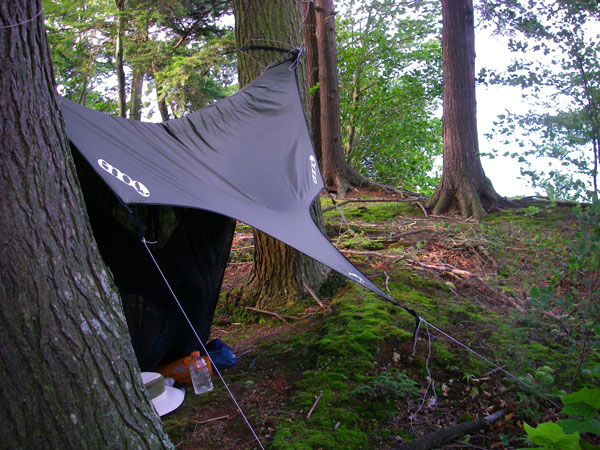
Using a Hammock for Kayak-Camping
Does a hammock offer a superior alternative to a lightweight, single tent for kayak-camping? “An optimist is a…

Product Review: Big Agnes sleeping pad
Is the Big Agnes “Insulated Air Core” sleeping pad the near-perfect compromise between weight, size, and comfort? SPECIFICATIONS…
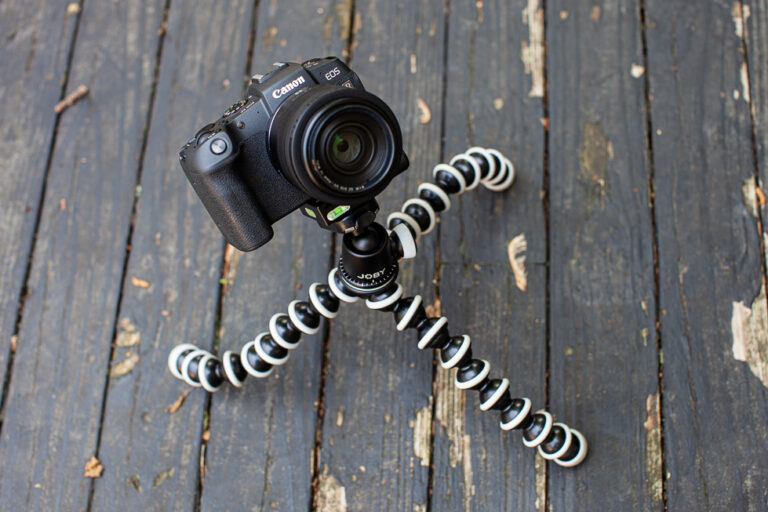
Product Review: JOBY GorillaPod HYBRID
The GorillaPod HYBRID photo tripod offers compact size, light weight, and a quick-release head SPECIFICATIONS Product Dimensions: 2.2…
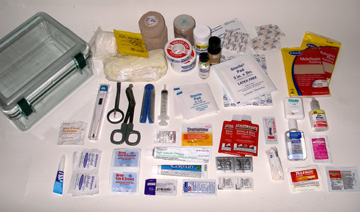
A Paddling First-Aid Kit
Make your own kayaking first-aid kit, and learn how to use it “Always carry a flask of whiskey…
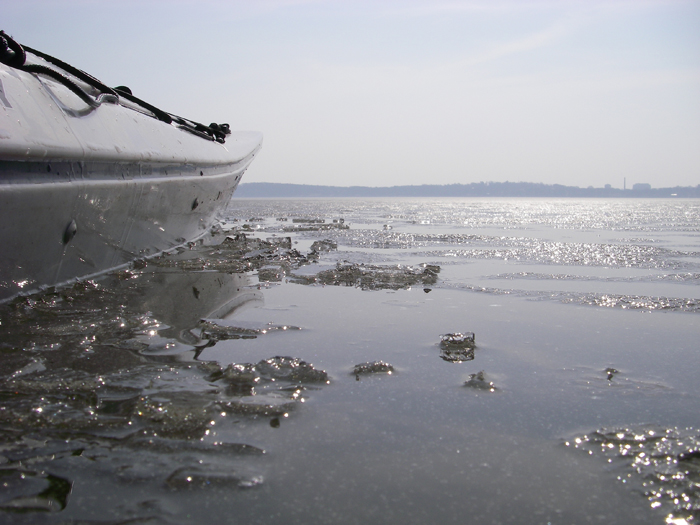
Safe Cold-Water Kayaking
Paddling a semi-frozen lake or river can be an exhilarating way to experience your local waters in a…
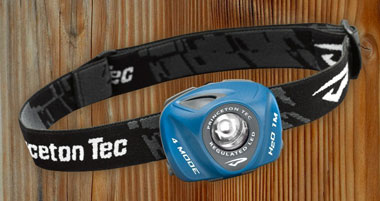
Product Review: Princeton Tec EOS LED headlamp
EOS lightweight, compact LED headlamp for camping, hiking, and paddling SPECIFICATIONS Power: 80 LumensLamp: Maxbright LEDBurn time: 121…
80 Comments
Thanks, I will gather what I think I might need and do a test to see how much I can do without. I appreciate your notes. lois
I have Kakak camped on lake islands and the Arkansas River system for the last several years. Looking over this list I see it is fairly close to what has evolved into my camp set up. I would add, underwater sealing epoxy, a roll of duct tape, a roll of light gauge wire cable and a few light shackles. I have a 17 foot sea kayak with a rudder. The Cable and shackles are for repair of rudder cables. The epoxy and duct tape is in case of a breach in the hull. This has never happened as of yet. Still when several miles from land, you kayak is your life raft. Vigilance and preparation is absoluey needful. I have had two aquaintaces who died at sea in central California. One certaninly by shark attack and the other was lost with only his EPIRB and PFD found miles out. I am happiest when on large waters.
Good advice, Greg.
In fact, I recently posted an article on making an emergency boat-repair kit, which would certainly include the items you mention. Of course, everyone’s kayak or canoe is different, so any such repair kit should be customized to your own needs, but it never hurts to have additional supplies to help fix someone else’s boat!
You may also appreciate my article on “A Paddler’s Bailout Bag”, for ideas on how to fix YOURSELF in case of an accident.
So sorry to hear about the loss of your friends. For many of us, the inherent danger is part of the allure of the wild open waters, but such stories also remind us to be careful out there …
Thanks for writing!
I agree with your add-ons Greg.
Hi Greg, I will be going to Lake Ouachita soon to do some island hopping and camping for about a week. I’m guessing you may have been there before. Can you recommend a good put in point? I’m a little worried about leaving the truck for 4-7 days in an isolated spot. I was considering Crystal Springs…any advice is appreciated. *Jason**
Awesome list! Though I don’t have a ‘sea’ kayak, and stay pretty local because of my job (blah), I’m so excited at the idea of camping out of my kayak!! I’m thinking about hitting the Kinzua Reservior this summer! YAY! Stop on by Kayak Lovers Anonymous on facebook and check out our kayak lovers!! Will be sharing your page as well. Hope you don’t mind!! Safe paddling!
Sharon, yes many of the items listed here will work just as well for other camping too, on inland lakes, rivers, etc.. Of course, you’ll want to tailor it to your own style of camping, but it should be a good place to start.
Looks like lots of good paddling to be had on the Kinzua Reservoir!
Will definitely check out your Kayak Lovers Anonymous Facebook page.
Hi Sharon …. I’m new to kayaking and i do venture out where is that river that you speak of? Dee
At the end of September I’ll wet my boat in Macon Ga and paddle down to Darien Ga. This will be my first long paddle. I am so excited to do this. September can’t get here fast enought. Your packing list is most helpful, thank you!!
Ron, that’s quite a paddle!
The Ocmulgee & Altamaha(?) are some real twisty rivers; looks like 300+ miles to the Atlantic Ocean. How long do you figure it’ll take you?
Hey Jeff. It took 15 days for this paddle. I’ve done four more. 143 miles on the Satilla, 152 on the Oconee to the Altamaha, 93 on the Altamaha And I’m planning my next trip September 23 back to the Oconee. Also adding to your list. A usb battery charger at least 50000mah will give you at least three maybe for full phone charges.
Ron, sounds like you’ve been racking up the miles!
And thanks for the suggestion of a USB charger; as more of us take digital devices on our trips, USB and solar chargers become valuable tools on our trips.
Keep paddling!
Jeffrey Lee
Thanks for the comprehensive list! We are planning a 3 day paddle on the Ozark Scenic Riverway in MO, and this has been very helpful just trying to get my thoughts organized. Normally we are car camping people, but this trip will be more of an adventure!
Glad you found the list helpful!
I’ve only driven over the Ozark River, but it looks like some great paddling! Obviously, you’ll want to adapt my list to suit your own needs/preferance, but it should be a good place to start.
Not sure where you’re coming from, but another good daytrip in that region is the Cache River State Natural Area in Vienna, IL: http://superiorpaddling.com/Dev2017/lower-cache-river-canoe-trail/
Hope you have a great trip!
One thing you didn’t put in the list that may be very helpful for survival campers is a small fishing kit. Rod, reel, hooks, jig heads and some lures or soft plastics to be loaded on to catch your own meals. One of my favorite part of camping is trying to live off the land/water while I’m out. But great list otherwise.
Tommy, good suggestion! I suppose I neglected to mention some simple fishing gear because I don’t fish myself, but certainly many paddlers do, and would be able to catch a meal in a pinch.
While i do agree with a small fishing setup, it should not be your only source of food for if you cant catch fish you will need some other form of sustenance.
I think you are a bit mistaken on the need for smaller bags. The reason for small bags is they will fit through the hatches, not because they are more efficient. If you have a kayak without bulkheads or have decent sized hatches, it is better (IMHO) to use fewer large bags. One large well fitting bag wastes less space than several smaller bags with all the gaps around them. But the big win comes with loading and unloading the boat. Remember tide (and current changes) wait for no person. And sometimes the camp site is a bit of a distance from the kayak haul-up (thinking of Pirates Cove in the Gulf Islands, BC) I’d rather bring two or three large bags (large doesn’t need to mean heavy) up than go back and forth for several trips to get small bags.
Now I have one bag for clothes/electronics, one bag for shelter, one bag for food and one for odds and ends.
Sure, you can carry a duffle bag to haul all the little bags to camp in one carry. And you can then use that duffle bag to hang your food bags. Note, though you can suspend your food directly from the dry bag it’s in, those dry bag seams were not designed to hold that kind of weight in the air (don’t ask me how I learned that). But over all, my load/unload times have gotten steadily faster as the number of bags (not necessarily the amount of “stuff”) has gotten smaller.
My Kayak is like a station wagon compared to todays boats. I measured the inside hull diameter and bought duffle and top open dry bags that just fit. Much easier to load, easier to find stuff (color coding bags only works so far), less chance of leaving things behind (few pieces).
Think of it like this – the next two times you go to the store, on one trip, use the fewest bags possible; load them up. Now note how long it takes you to load them in the car and take them into the house. On the second trip, give each item category it’s own bag, wine, milk, veggies, boxed items, cans – all in separate bags. Then see how long it takes to load them in the car and take them into the house. I rest my case 🙂
Taken by itself, a larger single bag is indeed more space-efficient than two smaller bags. But we’re not just packing bags here, but also a kayak.
If one loads a kayak with the largest bags able to fit through the hatches, there will inevitably be large spaces between and around them——wasted space, unless one is able to pack smaller gear bags into that space. Especially in the oddly-shaped interior of a kayak, a better use of space can be had by using numerous medium and small bags vs. a few large bags.
Mathematicians studying geometry refer to this as “volumetric packing efficiency.” Say you’re planning a party and you want to chill 5 cases of beer. You might easily be able to shove 2-3 large intact cases of beer into the fridge, but unable to fit the others in. But if you remove all the cans/bottles from their large bulky cases and instead pack them all in there individually, you’ll fit a lot more beer in the fridge.
Using more, smaller bags also makes it easier to organize and retrieve individual bits of your camping gear, rather than trying to extricate a pocketknife or a pair of socks from the depths of a large duffel.
Though I always enjoy a bit of beachside scientific debate (especially one involving beer), I’ll gladly grant that if your system works better for you, by all means enjoy it!
Jeff, as I was thinking of your system again, and thinking about your beer analogy, and the weight of cans and bottles, I have to tip my hat to one advantage of SBL (small bag loading). When it comes to trimming the boat, with smaller bags, you do have more flexibility in adjusting the weight balance; especially on longer trips. I find in those situation that the original heavy components – water and food – get diminished and what was lighter items – clothes and shelter – become the heaviest. So what starts out in the stern may return in the bow and vice versa.
Too bad we can’t attach pictures. I’d post my “Kayak loading, the early years.” photo. I recall coming in from a multi-day trip with a pile of gear – a bit of which was lashed to the top deck. One spectator came up to me and said, “You must be a pro to pack all that stuff.” I told her that if I were a pro, all that stuff would be in the boat, not “on” it.
Paul, yes trimming is very important. I generally pack heavy items like food, water (and beer!) as close to the cockpit as possible—usually just behind the rear bulkhead—so that as their weights are reduced thru the trip, they have little effect on the trim and balance. I agree that all gear should be IN the boat, not ON it, and that’s usually my limiting factor: if it doesn’t fit, it stays home! Happy paddling!
I have modified my yak to allow one boundary pack to slide behind my seat. I removed the stock seat and use a stadium seat. I also use it in the campsite. My yak is not like most yaks as it is a 1995 Wilderness Systems Chesapeake fiberglass and weighs 36 pounds. I built a yoke to clamp on the coaming. All my portages are done in one trip!
Sounds like a slick setup! The few times we’ve done portages with our kayaks were considerably more hassle than portaging a canoe, but your system sounds like it makes short work of it!
Thanks Jeff. It took a long time to figure things out. Last winter I put my yak in the basement to plan the set-up. I packed and repacked numerous times to make things work. I actually got my pack down to 25 pounds! I eliminated my gas fired stove and replaced it with a wood burning Solo Stove. This eliminated the need to carry the canisters of fuel. It consumes a lot of time trying to decide what you really and truly need to take. I try to resist any temptation of bringing comfort items such as a saw or cooler. I actually dehydrate my own food! All this talk is not helping my CABIN FEVER!
Yes, I am forever tinkering with my own ‘kit’ of gear, and trying to shave down the bulk; I’m envious of your 25 lb. weight! The days are already growing longer, so paddling can’t be far away …!
I once had a kayak that had the front and rear hatches and had to pack the small bags. To make the portages I had to unload everything and pack it into an army duffle bag. Taking multiple trips is a drag and time consuming. I had to lighten the load as I am going on 66 years of age! I found a helpful web site called http://www.maddythegoose.com . Check it out!
I see a lot of good ideas on here, I am a real believer in the smaller dry bags idea although I do use about 3 larger 20 litre bags for various items that can be packed together, small bags certainly fit into tight spaces easier, I have a skeg boat & there is some wasted space in the stern compared to a ruddered boat but I manage to fit my tent poles, pegs and bag alongside the skeg fitting. My 10 litre water bag is in front of my foot pegs and can’t move around.Everything else fits in various positions, I have 3 good hatches and a day hatch ( P&H Cetus) so it takes a good heap of gear.. Thank you for this site, I’m in Western Australia…
Neville, you raise a good point regarding adapting one’s gear/kit to the boat. Paul above describes his kayak as a bit more voluminous, so his larger bags work well for him. My boat is narrower and probably faster, but I sacrifice a good bit of space for that speed, which compels me to pack gear in tighter.
I suppose it’s possible that the time I gain while on the water is lost in more careful packing 🙂
Glad to have you join us from the Land Down Under!
Thanks everyone for an interesting discussion site. I’m always amused by the references or dry suits and bear bags, as I live on the East Coast of Australia, where we probably look similar from a distance to our mates from the northern climes, but we do it to keep the sun off, not the need to keep warm.
Planning a 10 day trip down the Myall River and Myall Lakes in a few weeks. Getting cooler, but still good for swimming, and we can swim all year round in Northern NSW.
Good information, I never seem to tire of reading others helpful advice.
Keep smiling everybody, Peter
Thanks for dropping us a line from ‘down under,’ Peter!
Yours is an example of how every paddler needs to adapt his technique and kit to suit his environment. Though we northern paddlers certainly need sun protection too (I burnt my nose a bit this past weekend, while kayaking among lingering ice floes), our real danger here is cold water.
Sorry to hear your summer is ending just as ours is beginning; enjoy the rest of the season!
This is a great list. While I like the idea of larger bags, the small ones work much better, just because of hatch size.
One thing I’m a little surprised to see is that you are packing your wine in glass bottles. Most rivers I know of here in Arkansas don’t allow glass. The danger to the environment being the key focus here. If I’m taking wine, we always decant it into a Nalgene (shatterproof and multi-use). Beer can’t be decanted, but the choices for good canned beer are much better than they used to be. To be clear: I’m not partying on the river, just unwinding after a long paddle, so the quantity is not an issue, just the glass. My $0.02 anyway….
Thanks for writing, Tim! Apart from the somewhat tongue-in-cheek photo, we seldom carry wine on such kayak-touring trips, if only due to the weight. Re-usable plastic containers are better than those of the past, and carbonated beverages in aluminum cans are far more convenient, as they offer smaller serving sizes and can be compacted when emptied, with little remaining weight or bulk. And, as you say, the selection of quality beers now available in cans is quite good (thankfully)!
Unlike on most riverways, Great Lakes paddlers are often PROHIBITED from camping within 300 feet of the high water mark and other bodies of water, so are usually set up well away from the water. Most Great Lakes campsites do allow glass containers, though according to National Lakeshore regulations: “All glass containers and products are prohibited on any land or water area regularly used for swimming, sunbathing, or wading.”
As in Arkansas and presumably many other rivers nationwide where campers are compelled to camp near the water, our Lower Wisconsin State Riverway wisely prohibits the use of any glassware.
So, paddlers & campers should always follow local regulations, and generally use caution when using any kind of glassware. Those of us who love the water usually lounge around camp in sandals or even barefoot, and no one wants to step on someone else’s broken bottle shard …
And it should go without saying that we should all follow “The “Leave No Trace” Seven Principles for Paddlers”.
I will be leaving in a week on a kayaking/backpacking trip out in the fjords of Norway. I’ve done an extensive amount of backpacking but this will be my first out-of-kayak trip so I have a question about drybag packing. For such a list, how many drybags do you require? You suggested many small bags as opposed to a few larger which makes sense not only in order to optimize the weight distribution in your kayak but just spatial constraints in general. What size small bags do you use? Are we talking 10-20L range?
Thanks! Kyle
Kyle, sounds like a fantastic trip! A few friends have enjoyed their own visits to Norway …
I’m currently using only about six 5-10-liter drybags for the packing list outlined here. But I typically only use drybags for those items which *require* complete dryness: clothing, food, electronics, first-aid kit,, etc.. I don’t bother packing less crucial gear in drybags: kitchenware, campstove, sandals, rain jacket, etc.. A two-person backpacking tent, even if completely soaked, can quickly be drip-dried and erected, and will soon dry out enough to inhabit.
A sleeping bag, of course, is no place to risk wetness, esp. if goose down. I swear by this clever compression dry-sack.
Have a great trip!
Myself and a group of friends will be taking an overnight camping trip with a short paddle in knubble bay Maine this coming weekend and we appreciate this primer in packing a kayak. Thanks for the great tips!
Lauren, Looks like a beautiful place to kayak! An overnighter is a great way to break into kayak-camping and to work out your routine and gear list. And going with friends means you’ll probably have a backup in case someone forgets something.
Glad the article helped. Have a great trip!
I noticed you said the Great Lakes, I am from the Detroit area and was looking to plan a kayak camping trip with some friends, do you recommend an area? We were looking to go three days, two nights. Sort of like a kayak, make camp, wake up pack up and kayak more type of thing. Somewhere where we can put-in and take-out in different locations but all vehicles would be safe parked from start to end. Any recommendations? Anything is appreciated, it’s our first time planning this.
Thank you, Chelsea
Chelsea, congratulations on getting into kayak-camping! Living in Detroit, you’re quite close to TWO Great Lakes.
Planning such a trip really depends on how far you want to drive, how far you want to paddle each day, and whether there are public lands available for camping along the way. Lake Michigan tends to offer fewer such places than Lake Superior, since so much of the shoreline is privately owned, but you can find them.
What you’re talking about is called a ‘shuttle’ trip, where you drop off a car at the destination, then drive back with all boats and gear to the put-in, then paddle a few days to the first car. Then, of course, you need to drive back to pick up the second car on the way back!
Here are a few ideas:
Sleeping Bear Dunes Nat’l Park Mainland backcountry camping is available at the White Pine campground near the Platte River campground, or at the Valley View campground north of Glen Arbor.
Between Cheboygan and Bay City From maps, it looks like there may be enough public land access in this part of the shoreline to piece together a 3-day trip.
Wilderness State Park By launching on the South side of the peninsula and paddling out and around the point, and back to the North shore, you could possibly do a 2-3-day trip and land quite close to your car, for a shorter shuttle. Check with the park for available campsites near the water.
The Lake Michigan shore west of St. Ignace is in the Sault Ste. Marie Forest Area, which may allow backcountry/shore camping. St. Ignace to Epoufette Bay, for example, is a distance of about 27 miles, or 3 ten-mile days of paddling.
Hope this helps, and have fun!
We do a fair amount of Kayak Camping throughout the Adirondacks in upstate NY. Here are my thoughts: – it seems like that’s a lot of stuff…but you really can’t get much lighter…so consider “backpack” style stuff like your tent, flashlight(s), an MSR Universal stove, water filter, ultralight cook kit, etc ,,,my kayak weighs 60# empty, I add about 50-55# of gear. – Portages with heavy ‘yaks are not fun, so for the extra 3 pounds, bring wheels & tie down straps – Making a base camp and then doing day trips allows you to empty the kayaks and explore, as well as making any portages much easier. – ALWAYS have a first aid / survival kit in your kayak… – NEVER leave food in your kayak…little critters will gnaw the crap out of it, and bears, well,,, – make sure your whistle works when wet or with water in it. (some actually work underwater) – remember firestarters, like fatwwod pieces. most wilderness camp areas get picked of descent wood, so you’ll need a good fire starting system to light the wood you scrounge – The more the merrier…and the lighter each kayak since everything get’s distributed – box wine (yea) take just the bladder and seal in a ziplock just in case. molds perfectly to fit – ultra lightweight chair, like the REI one…no sitting on stumps or wet ground – bring an extra days worth of food,,,just in case or if you decide to extend your trip
I’m sure you know that wheels don’t always work in the ADK’s. Get a lighter yak and devise ways to load it and carry it. I have a 36 # yak. Removed the factory seat. I slide my waterproof Boundary Pack under the rear deck and use a stadium seat. I can use the seat in camp also. I also built a yoke to carry it over the portages with my pack on! One trip portages are quicker than multiple trips! If you can’t use this idea, you can pack your gear in smaller bags and bring a military duffle bag to pack these smaller bags in. Install your yoke, shoulder your duffle bag and lift your yak! The duffle bag folds until you need it.
Thank you for the great insight. My wife and I are planning a kayaking trip for 2 nights in the Everglades. The water there is not able to be filtered. Any thoughts on water storage? We have canoed the park and had no problem carrying a 5 gallon container. Would be a different story in a kayak. Any help would be appreciated.
Expandable water-storage bags like these from Platypus are a great way to carry water in a kayak (watch for an upcoming Superior Paddling product review).
Lightweight, flexible, and available in a variety of sizes, these bags allow you to carry water for the changing needs of a trip, without the rigid bulk of typical camping water jugs.
Have a great Everglades trip!
We just finished a circumnavigation of Isle Royale and the outer loop of the Apostle Islands (170 miles) and I definitely feel multiple smaller bags is best. Trying to find just the right thing at the right time is easier if you don’t have to unpack and repack a bigger drybag. After a long paddle it isn’t easy to remember which bag has what in it. Also for lunch breaks having cooking gear organized with food prepackaged saves time and effort. I use a Jetboil and dehydrated meals but for others being able to “cook” requires an alcohol stove. Boiling water in less than a minute is great for those of us that just want something quick and filling or that rejuvenating cup of tea.
Yes Scott, the organizational advantage of many smaller bags is definitely another plus when on a trip.
We also try to make a point to prepare our lunches while cooking breakfast, so we don’t have to break out the cooking gear again for a lunch break. Sandwiches, wraps, and other unheated foods work well for this. Sometimes we skip a proper lunch entirely and instead simply snack perpetually between breakfast and dinner, as a way of distributing our caloric input over the course of a long paddling day.
Going all the way round Isle Royale is definitely on my list! How long did it take you?
Stumbled across this excellent site and discussion whilst browsing (again) for new tips and tricks while waiting for summer to come here in NZ. We can kayak year round but always get in a longer trip over the summer holidays, and I am getting impatient….. One tip to add to the list, we tend to use smaller dry bags but stash a large mesh type bag behind my seat, when we are unpacking at the end of a day, and setting up a camp we fill it with the smaller bags, thread a paddle or pole through the handles and shoulder it to the campsite. It’s also useful for hanging in a tree with damp stuff. We don’t have to worry about bears but we do put all our food back into the hatches overnight to avoid rats, mice and opossums who will make holes in food bags and tents but luckily, leave the kayaks alone. Roll on summer!!!
Yes, a way to carry all those smaller bags is certainly helpful, and I like your idea of a large mesh bag, which compresses to nearly nothing when unused. Others like duffels or handled shopping bags from IKEA.
Thanks for the additional tips from the southern hemisphere, Lesley!
Glad to find your site. I kayak and have done several overnight trips. I am going on a 4 day 3 night trip down the Suwanne River in Florida and am finding this a challenge to pack for. Each camping trip has led me to purchase smaller, lightweight camping equipment, but food is being the challenge for me. There are no restaurants along my route!!. I have not really tried dehydration yet. If you have any tips on that – please pass them on. I have enjoyed reading the comments about small bags/large bags and have picked up some great tips. Thanks for the ideas – will have another go at packing boat again tonight to keep from carrying anything on top.
I’ve hesitated to write much regarding food because individual tastes of people are so varied. It seems that touring paddlers run the gamut from the Boundary Waters style of old-time ‘traditional’ Dutch Ovens and fresh-baked sourdough biscuits & gravy, to those who eat whatever the astronauts eat on the International Space Station.
My personal approach to food is much like my approach to nearly everything else for kayak-touring: Simple. And cheap.
I typically take a dozen packets of instant oatmeal, a dozen bagels, and a small jar of peanut butter for breakfasts. While the water is boiling, I prepare something for lunch …
Another bagel, this time with a couple slices of summer sausage and super-hard cheddar cheese tucked inside.
For dinner, my trip partners and I take turns cooking each evening, and I usually make a large packet of quick-cook flavored rice or pasta, with a can of pre-cooked chicken or tuna chunks stirred in. These provide the necessary carbohydrates for energy, and protein for muscle maintenance.
Add a couple dozen granola or other snack bars for all-day munching, some powdered energy-drink mix, and the necessary water for drinking/cooking, and you have enough for a week of touring.
All my food for a one-week trip fits into a 10-liter drybag, and I often come home with some unused ‘leftover’ packages. All these items are readily available at your local grocery store for little money, and require little more than a backpacking stove and cookset.
Canned food is admittedly heavy, and the cans require rinsing and packing out, but they’re still far lighter than any cast-iron frying pan. And the grocery-store packets of dehydrated rice/pasta are far cheaper than the similar stuff at the backpacking shop.
Hope this helps!
Thanks for the tips. With our trip being over, I learned alot. I did end up taking too much food but I didn’t go hungry. I did end up throwing extras away each day, simply because after 2 days, I knew what I was using and liked. Threw away or gave away what I knew I would not use. Also found that summer sausage and hard cheese were great. Tortillas and pita bread packed flat and were easy to store. Tuna in a pouch worked great. Also found the 90 second microwave rice pouches worked great with chicken (in foil pouch) were good, not too heavy and didn’t take up too much room. \ Next trip, I know I can leave alot of extras homes. I did snack frequently, nuts, trail mix and granola bars. Hate to say, but I did save room for small boxed wine!
Good to hear you had a great trip! And learned something about your own camping-dining preferences.
Better to have too much food than too little, and one never knows when one will be delayed/stranded somewhere for an extra day or two, so a ‘reserve’ is smart. Still, I often assess the remaining food I bring back from a trip to see if I can do without it next time.
I keep meaning to try the pita bread, and my backpacking brother taught me a good use for tortillas: slather them with peanut butter and/or honey and roll ’em up tight like cigars, then carry them in zipper-lock baggies for snacking and lunches. He often brings a dozen such pre-made rolls for a week of paddling.
And always—ALWAYS—leave some room for your favorite adult beverage …
Good article, thanks.
Re: Ditch kit
My kit is stored inside a wide mouth stainless steel bottle that is not insulated and has no plastic parts…and is waterproof. I do waterproof the items inside just in case. I take a short piece of bailing wire to loop around the top so that I can boil water in it over a fire. I pack a couple tea bags also, as a warm drink can be huge out there!
PC….paddling cold Canadian waters!
We are taking our first kayak trip in March. We are paddling across the state of Florida. From Stuart to Cape Coral. Your article and many of the comments I have read have been very helpful. As this is our first long trip it will, I’m sure be a learning experience for us. The trip is around 160 miles. We are planning 6 days to make the trip. With good luck and gentle tides we are looking forward to a rewarding experience.
That sounds like quite a trip, in a beautiful area.
Glad you found some good packing tips here, and hope you have a great trip!
I am new to kayak-camping and i am looking forward to nice trips with friends and family. Thank you from Canada.
Christian, welcome to the great sport of kayak-camping!
Some of my earliest and best canoe-camping experiences were on family trips in Canada, and we still find some of the best paddling there. I’m sure you and your family will have a lot of fun.
Have some great trips!
I am so pleased to have found this informative–and well written!–site. Thanks for all the advice.
I’ve really fallen head-over-heels for kayaking. I recently bought my own kayak, which means that those multi-day trips I dreamed about during the 5 years of rentals have finally come within reach. My kayak is a Wilderness Tarpon 12-foot sit-on-top (which works fine for most of my excursions, as I live in Florida), so I’m not packing it exactly as one would a sea kayak… but I find that your suggestions are certainly adaptable to a sit-on-top. (Yes, I would like a sea kayak, too. But that is an investment for another year.)
Since I usually go out on my own rather than with a group, I am particularly focused on preparedness and safety. I appreciate the detailed advice/specs, which help to make this new adventure of kayak-camping a less intimidating prospect.
Thanks again for creating (and maintaining) such a helpful website.
JoLee, thanks for your kind words!
Glad to hear you’ve found a kayak that works for your environment and for your style of paddling and camping; whatever gets you on the water! I had a chance a few years ago to enjoy a day-paddle through some Key Largo mangrove swamps in SOTs, and they are well suited to that type of paddling.
And congratulations on adapting the packing info to your boat and type of camping.
Happy paddling!
Thanks for the equipment list, I am a hiking addict, but have a heal spur at present so am going to do a 5 – 6 day trip down the Murray River (Australia), next week. This section will take me through a new National Park, with giant Red Gums and loads of water birds, should be good. Just decided to go yesterday, so all the help in quickly getting it together helps! I’m a but worried about all the water I will need to carry, and the weather (it’s winter here now), but she’ll be right!
Sounds like a great trip in a beautiful place!
Paddling is a great way to explore the backcountry even if one has some kind of physical ailment or a disability because it is such a low-impact activity. Because the boat is carrying all the weight of you and your gear, the trip can be easier on one’s joints, etc..
Glad the packing list was helpful; have a wonderful trip!
We just came back from spending 3 months kayaking the Alaska Inside Passage using our 22′ ocean tandem. We had almost all of the author’s list. We didn’t have a horn though contemplated one. We did use the DeLorme InReach Explorer which includes GPS, emergency locator, social network (if you want to keep in touch) and messaging. We also had a marine radio.
We prefer the large vinyl dry bags and honesty in all our years of ocean haven’t had a problem with sticking together. On this summer’s trip we tried some of the lighter weight bags….weren’t impressed.
Being prepared for anything is always very important….even if nothing happens.
I have fully read this page. It is full of great advice. My husband and I are getting ready to do our first overnight trip on lake havasu as. Hopefully I will be able to convince him to do more. Thank you for all the helpful advice so every thing goes smoothly.
Glad you have found the article helpful, Beth! I hope it inspires your paddling partner with the confidence he needs to ‘go outside and play’.
Have a good trip on Lake Havasu!
ok. so what happened to packing light. i mean thats a lot of stuff to fit in a kayak.
Define “a lot”. I’ve paddled with campers who bring most of this stuff PLUS a 200-square-foot rain fly, hatchets and saws, 3-gallon stew kettles and two-burner stove, AND the kitchen sink (folding, of course)! So I suppose it’s all relative …
I’m currently paddling an Impex Force Cat 4, which is a pretty fast but quite low-volume slim boat, and to be sure, it can be a task to fit all this gear into that kayak. My buddy’s Valley Aquanaut, on the other hand, is a bit wider and slower but is a real gear hound, and I often marvel at the extra luxuries he’s able to bring along.
Hauling less gear around will certainly make your boat lighter, faster, and easier to pack, but at the cost of camping comfort. So each paddler must decide for him- or herself what stays and what goes. When I fly to a paddling destination and my gear volume is limited by airline restrictions, I have to trim my kit considerably. Feasible, but I do miss some of the usual creature comforts.
If you feel that you can get by with less gear, I think that you should. Just don’t try to mooch my beer … 🙂
My brother pack light and celebrate with bloody Mary’s! Beer is too heavy to carry on 1.5 mile portages over rugged terrain in the Adirondacks. We won’t mooch your beer because we’ll be drinking after our camp is set up and waiting for you to arrive!
Really helpful article. I have bought a new boat and looking for the first trip. Really excited. Thanks for sharing great tips.
I found this article very helpful as I start the research on one of my Bucket List items, round trip solo kayaking of the St Johns River in FL. 620 miles total. I will be starting in Jacksonville and going up river. I have RV camped for many years and have minor canoe experience, but none in a kayak. As I start to get older (I’m 78), it’s time to start on my list. I have the advantage being near civilization most of the trip, not like Alaska or the boonies of Lake Superior as many of the trips commented on were. My target date is mid-March. I don’t have much equipment yet, not even the kayak. I expect to look at several on Craigs List next week and then start practicing and seeing how much equipment it will hold. I have no deadline for this trip. If it take 2-3 months that’s OK. I would like to report on the trip periodically and would appreciate any thoughts on the best ways, blog, Facebook, website, etc. That sort of thing. Any conversation at all on my trip would be appreciated.
Sounds like a fantastic trip, Jim!
I’ve paddled a canoe for a bit of the St. Johns River, near Blue Spring State Park, where one could carefully paddle among the wintering manatees. Paddling the entire river, especially upstream, would be a truly epic journey!
I would urge you to get your kayak and begin practicing as soon as possible, as your planned launch date is soon approaching. Pack your boat as you would for your trip and start paddling more and more miles to build your stamina and to estimate how far you are able to paddle in a typical day.
As for keeping in touch while on your trip, I think Facebook is perhaps the easiest and most effective, since it would require no special domain name or webhosting, let alone the work to setup a dedicated website/blog. Facebook also offers mobile apps to allow easy posting even from a muddy riverbank while camping, as long as you have a phone or data connection. It’s also an easy way to build a following/audience.
When you get a page setup, feel free to post it here for others to follow your trip, and of course post a link on the Superior Paddling Facebook page: https://www.facebook.com/pages/Superior-Paddling/432617926804767
Thank you all for the input to this string. I am not a kayaker but am planning a pigramage that will take me miles up lake. I have about 8 months to pull together gear, get in shape and figure out how much nourishment I need to complete the trip. I will be making reference to these writings and taking ideas. Thanks. I have a long preparation but feel its more manageable now.
Good luck on your trip!
As I suggested to Jim above, start practicing as soon as possible and add more miles to build your fitness level. The first trip can be the most challenging, but also the most exciting!
That’s a hilarious list. I don’t carry 1/3 that crap, lol, and I stay for 1-2 days, usually.
This is what I brought on my last trip:
EDC Small Bic Lines Yak Paddle Aux Paddle Life Jacket Bad Boy (my Kershaw Outcast) .22 Mag + 1 box Tent (in dry bag) 6X8 Blue tarp (perfect footprint for my tent) Folding Grill Grill Extra Bics Pic Repellent Spray repellent Pocket tackle box Bait (worms) Small Rod & Reel Needle Nose Pliers 2 Flashlights Colorful bank marker…bottle tied to a tree (I put in and take out in weird, unmarked places with no visible roads) Folding chair (Trek Ultra-check them out)
Dry Bags: Soap Toothbrush/Toothpaste Trunks Sleeveless shirt Tennis Shoes Flip Flops Jeans Xtra Shorts Short Sleeve Shirt Long Socks Cell Phone Xtra Cell Battery Money Clip
Rations: Ate big breakfast 16 oz Stainless cup Spoon Instant Coffee Lunch: wrapped sandwiches + Chips More Chips Honey Buns 8 8 oz small Dr. Pepper (taste better hot than most soft drinks) Dinner: Sausage/Cheese/Chips/side (beans/tortellini) Breakfast: Honey Bun/Sausage/Chips MRE Snacks (2) Mustard Packs Water: 3@32+ 3@12 Keep bottles 2 Kitchen bags 1 Paper Towels
Oops I forgot: I took a hammock on my last trip, not a tent (which I regretted) so I need to add sleeping bag and air mattress to this list: I like hammocks but as I usually camp on sand bars I wound up with chiggers traipsing around in the woods rigging that CRAPPY hammock. Still, I am very drawn to hammocks (don’t like air mattresses) and I think I am going to purchase a Warbonnet this season.
If one is paddling and camping in southern inland waters, you can probably forego much of the safety gear required in the open-water marine environments of the ocean or Great Lakes: cold-water immersion clothing, signal flares, tow belt, VHF marine radio, bear bags, etc.. The US Coast Guard patrols the waters we paddle precisely because they are so potentially dangerous and remote, so it would be foolhardy to kayak in such places without such crucial safety gear.
But even in milder inland waters, I don’t see on your list any of the usual outdoor essentials like maps, compass, small first-aid kit, even sunglasses or a rain jacket?
If we were going out for only “1-2 days”, we might get away with packing a couple of big lunches and some snacks, and sleeping in the same underwear we wore while paddling. But the 1-2-weeklong backcountry trips for which this list is used will usually benefit from a few hot meals, requiring more food and some minimalist cooking equipment.
And as we can expect to encounter sweltering 90-degree days and 40-degree rainy nights, and we are often several hours or even days from ‘civilization’ and safety, self-sufficiency is crucial.
As always, this list must be adapted to each paddler’s unique environment and situation.
I love kayaking, and I agree that when you go out camping with one packing light is key. If you are going to be using the same campground next to your car, then you can pack your dutch oven chairs and any other niceties. However, if you are going to go on a prolonged trip you should probably pack just as carefully as you would for a backpacking trip. I think your list is a really good guide for this.
Color coded bags, excellent idea.
A good addition to the personals list is a small waterproof container to hold any medications ,and if you didn’t mention toilet paper or a means of getting rid of your… Deposits is a shovel or trowel
Great article! May we post a link to this on our club website. I think there are a lot of members that would find this useful.
Chris, sorry for the late reply but I was out paddling last week, in Michigan’s Pictured Rocks Nat’l Lakeshore.
Yes, by all means feel free to link to my article! I hope your members find it helpful in planning their own canoeing and kayaking adventures.
And I’m happy to include a link here to your club site: bluffcitycanoeclub.org
Last March (2016), I spent 3 days & 2 nights in the Okefenokee National Wildlife Refuge, (~700 square miles of wilderness with ~15,000 alligators and 120 miles of paddling trails). My solo trip was only 20 miles long that took me through each type of habitat within the refuge.
Small dry bags did worked well inside the boat for packing, but I took to much gear on the deck in 2 deck bags, a soft sided kayak cooler and a large dry bag. Your advice to pre-pack your boat before the trip, I knew, but failed to carry it out before hand which resulted in the overloaded deck. I’m planning a return trip for this coming March with more care to reducing the volume by replacing some items and leaving others in the vehicle or home.
The Refuge requires leave-no-trace to the point that you must pack everything out (even human waste unless the human waste is deposited in composting toilets at the campsites). This is a wildlife refuge where plants & critters are more important than the visiting people. Because of this need to limit human impact on the wildlife is so great planning your meals is very important to the point that portion size and number of meals you bring into the refuge is a major consideration in trip planning. Any food not eaten must be carried out and not left in the composting toilets, or anywhere within the refuge.
Anyone who is in need of a paddling destination during the months that ice is covering your favorite northern waters should look south where there are very good open waters to explore and the boat will only look out of place on your vehicle as long as there is snow on the sides of the roads.
Leave a Reply Cancel reply
Your email address will not be published. Required fields are marked *
Save my name, email, and website in this browser for the next time I comment.

Detailed trip guides for some of the finest Great Lakes kayaking destinations. Trip outlines with maps, photos, route details, planning resources, and more!
Destination GoGuides
- Search Please fill out this field.
- Manage Your Subscription
- Give a Gift Subscription
- Sweepstakes
- Destinations
The 7 Best Kayaking Trips in the U.S. for Adventure Seekers
Some of the most beautiful places in the U.S. are best seen from the water.
Evie Carrick is a writer and editor who’s lived in five countries and visited well over 50. She now splits her time between Colorado and Paris, ensuring she doesn't have to live without skiing or L'As du Fallafel.
:max_bytes(150000):strip_icc():format(webp)/evie-carrick-df91be43396540c492c4141c56a71a9e.jpg)
There's something extra special about spending a day out on the water , letting it pull you where it wants. And it doesn't matter whether you're paddling around a calm coastal bay in Alaska or flying down a Class III rapid in Georgia — with the cool water below you, warm sun all around you, and an ever-changing landscape that might include red-rock canyon walls, lush overhangs, or even a pod of passing orca whales, the experience is bound to be wonderful.
There are hundreds of amazing kayaking trips across the U.S., but to help you narrow it down, we curated a list that offers a little something for everyone, from newbies looking for perfectly flat waters to advanced kayakers interested in careening down a Class IV rapid. Just make sure to secure the proper permit and practice good stewardship on whatever trip you choose. And don't forget the proper apparel .
Glacier Bay National Park, Alaska
Taylor McIntyre/Travel + Leisure
When it comes to pure, natural beauty, Alaska is hard to top. And that beauty is only enhanced from the water. While you won't find any rapids or whitewater off the shores of Glacier Bay National Park, you will spot glaciers, puffins, sea lions, and even orca or humpback whales.
If you're interested in booking an overnight trip during the summer (a must), make sure to register for a free permit .
Colorado River, Arizona
The great Colorado River traverses several states — Colorado, Utah, Arizona, and California — and while you could technically float the entire way, you'd need some serious paddling skills and a surefire plan to do so. To get a taste of the Colorado , head to Arizona and run the relatively mild 15-mile section of the river from Glen Canyon to Lees Ferry. And don't forget to look up, so you get the full effect of the red-rock canyon walls and near-constant bluebird skies.
You don't need a permit to float to Lees Ferry, but if you want to continue on, you'll need to secure one.
Klamath River, California
For a beginner-friendly river trip, check out Klamath River . The water may flow out of Oregon with gusto (Class IV water), but it mellows out in California. For a great family experience, put in at Happy Camp and enjoy the views on the 20-mile journey to Dillon Creek. Along the way, you'll come across natural swimming holes, cliff-jumping spots, waterfalls, and some Class II and III rapids. Enjoy great waterfront camping and keep an eye on the skies above — bald eagles roam these parts.
A whitewater rafting permit is not required, but a fire permit is necessary.
Allagash Wilderness Waterway, Maine
If you have your heart set on an East Coast expedition, head to northern Maine. The Allagash Wilderness Waterway flows through an expansive, underdeveloped part of the state and boasts moose, bears, and blueberries along the way. For a full, multiday trip, put in at Churchill Dam and float till you reach Allagash Village, a section that has Class II rapids, lakes, and a short but mandatory portage around the Allagash Falls (well worth the effort).
You'll need to register before you put in and be prepared to pay camping fees.
San Juan Islands, Washington
If sea life is what you seek, head to the San Juan Islands in Washington. Located near the U.S.-Canada border, this string of islands is home to orca whale pods all year round. Plus, it's known for regular sightings of sea lions, seals, dolphins, and otters.
You can book anything from a half-day to multiday kayaking trip around the islands, but we suggest giving yourself plenty of time to explore the smaller islands off Lopez Island, paddle through the protected waters around Orcas Island, and try your luck at spotting a resident orca pod off San Juan Island.
Chattooga River, Georgia
Georgia's Chattooga River has some Class V rapids, but most people plan out a more family-friendly trip that traverses Section 2 and 3 of the river. During Section 2 , you'll float over and around Class I and II rapids, as well as enjoy calmer sections of the deep, crystal-clear water. After seven miles on Section 2, you can take out or continue on to the more difficult (and more remote) Section 3 — home to rapids that reach up to Class IV.
You can self-register for a permit to run the Chattooga River when you put in.
Middle Fork of the Salmon, Idaho
If you're up for more of a challenge, plan a kayaking trip down the Middle Fork of the Salmon — a journey found on almost every river lover's bucket list . The river has some serious Class III and IV rapids, but it's also known for its superior fly fishing, so make sure to cast a line when the water calms.
A permit is required to float the Middle Fork of the Salmon and a lottery takes place during the busy summer months.

Car hire at Moscow Vnukovo Airport
Search hundreds of travel sites at once for car hire deals at moscow vnukovo airport (vko).
Save up to 46% Compare multiple travel sites with one search
Free to use There are no hidden charges or fees.
Filter your deals Filter by car type, brand and more. Instantly customise your results.
Book with flexibility Use our "free cancellation" filter for maximum flexibility at no extra cost.
Cheap car hire at Moscow Vnukovo airport
Top tips for hiring a car at moscow vnukovo airport.
- Whether you’re visiting Moscow for a week or a month, getting a car rental at Moscow Vnukovo Airport (VKO) is the best way to explore the Russian capital. You’ll traverse various parts of the city that aren’t fully accessible by public transport. Self-driving lets you choose the shortest route to your destination and avoid traffic. Renting a car will save you money compared to using a taxi when you look at the overall costs to multiple destinations.
- Collecting your rental car at Moscow Vnukovo Airport isn’t that complicated. You’ll find several local and international car rental suppliers at the airport with an on-site counter. Car rental desks at VKO are on the ground level in the Arrivals section, Terminal A. Once you get to the airport, head straight to your preferred company’s rental desk. You can also visit the rental desks after booking online. Make sure you carry all the requested documents. After processing, a staff member from the rental company will guide you to the pick-up point outside the terminal. Take your time to inspect the car for any dents or damages. Check the fuel level and make sure your maps are working and in your preferred language since most road signs in Moscow are in Russian.
- The other benefit of getting a car rental at Moscow Vnukovo Airport is that you’ll have a smooth return process. Most rental companies will ask you to return the rental car to the exact location you collected it, or the drop-off point stated in your rental contract. What you should pay attention to is the return period. Make sure you return the car on time to avoid the late return penalty fee. You can inform the company early if you’re facing challenges and can’t return the rental car on time. After dropping off the vehicle, conduct a final inspection to check for damages before heading to your rental counter for clearance.
- Moscow Vnukovo Airport usually gets busy between March to July when most tourists visit for the summer holidays. During this period, car rental bookings are generally high. You can experience long waits at the car rental counter. The airport also gets busy during weekends, special events, holidays, and major conferences in Moscow. We advise you to book in advance for availability and to save money since rates are comparatively pricey during the peak travel season.
- Book your car hire at Moscow Vnukovo airport at least 4 weeks before your trip in order to get a below-average price
FAQs about hiring a car at Moscow Vnukovo airport
What documents do i need to rent a car at moscow vnukovo airport.
To rent a car at Moscow Vnukovo Airport, you will need a valid driver’s license from your home country that has been valid for at least one year. You should provide an International Driving Permit for translation purposes. Most companies will also require your passport for additional proof of identity. A valid credit card with enough cash for deposit and payment must also be presented. Some companies will ask you to bring a printout of the booking confirmation voucher sent to your mail.
What amenities are available at Moscow Vnukovo Airport?
You’ll have access to several amenities when you opt for a car rental at Moscow Vnukovo Airport, including showers in various lounges, ATMs, luggage carts, and free Wi-Fi. If you’re traveling with children, you can take advantage of the children’s playroom in Terminal A. There is a parenting room equipped with changing tables, baby cribs, and play areas for parents traveling with newborns. VKO is perfectly equipped for passengers with reduced mobility.
How can I pay for my Moscow Vnukovo Airport car rental?
The best way to pay for your Moscow Vnukovo Airport car rental is using a major credit card. It is a secure option for renters and the best security for rental companies during your rental period. Few car rental suppliers may let you pay using a debit card but with several limitations and requirements. They will restrict you to certain types of rental cars, and you may be asked to produce additional proof of identity or your return travel details.
Which car hire companies will pick you up at Moscow Vnukovo airport?
Car hire companies that offer shuttle or pick-up services from Moscow Vnukovo airport to off-airport locations include Avis, Rentmotors, Sixt, and TIS Car.
Moscow Vnukovo Airport car rental reviews and directory
No reviews available
Cleanliness
Pick-up/Drop-off
Value for money
One location in Moscow Vnukovo Airport
Locations in Moscow Vnukovo Airport
Vnukovo Int Apt
Vnukovo Air Term A Meet N Greet
+7 495 640 82 82
Opening times not available
keddy by Europcar
3 locations in Moscow Vnukovo Airport
Poselok Vnukovo 2 Reysovaya Street
Vnukovo Airport Intl Arrival Zone- 2, 2Nd Reisovaya Str.
No score available yet
2 locations in Moscow Vnukovo Airport
Mosco - Vnukovo Airport
+7 916 724 04 55
Terminal A, Counter 34
+7 962 967 8633
IDrive Rent-A-Car
+7 499 685 4725
Vnukovo airport
+7 495 921 3838
12, 1-Ya Reysovaya Ulitsa
Terminal. A,2 Ul.2-ja
+7 495 260 10 38
+7 495 788 6888
ul. 2-ja Rejssowaja, 2
+7 495 589 11 11
2 2nd Reisovaya str.
+7 926 279 2989
Car rental locations at Moscow Vnukovo Airport
Airports serving moscow.
- Car hire Moscow Domodedovo Airport, Vnukovo
- Car hire Moscow Sheremetyevo Airport, Vnukovo
Hotels near airports in Moscow
- Hotels near Moscow Zhukovsky airport
- Hotels near Moscow Vnukovo airport
- Hotels near Moscow Domodedovo Airport
- Hotels near Moscow Sheremetyevo Airport
Statue of Lenin

Most Recent: Reviews ordered by most recent publish date in descending order.
Detailed Reviews: Reviews ordered by recency and descriptiveness of user-identified themes such as wait time, length of visit, general tips, and location information.
Statue of Lenin - All You Need to Know BEFORE You Go (2024)
- (0.57 mi) Elektrostal Hotel
- (1.00 mi) Yakor Hotel
- (1.31 mi) Hotel Djaz
- (1.41 mi) Mini Hotel Banifatsiy
- (1.45 mi) MTM Hostel Elektrostal
- (0.07 mi) Teremok
- (0.21 mi) Coffee Shop Usy Teodora Glagoleva
- (0.25 mi) Mazhor
- (0.30 mi) Tashir Pizza
- (0.31 mi) Ermitazh

IMAGES
VIDEO
COMMENTS
If you're into kayaking and orcas, this is the kayak camping trip for you. Sea kayaking in the ocean and camping on small islands with otters, seals and bald eagles. Boundary Waters Canoe Area Wilderness, Minnesota. More than 2,400 kilometres of kayak routes, with more than 2,000 camping spots.
Best Kayak Camping Trips & Places To Go. 1. San Juan Islands, Washington. Photo by Toan Chu. Dreamy loops of islands, snow-capped mountains, rocky coastline, sweeping ocean views, spreading greenery, and an abundance of marine wildlife are just some of the reasons why the San Juan Islands are considered a bucket list kayaking destination.
The Grand Canyon: Definitely not a place for your first trip, but one to put on your list. You'll need to get a non-commercial river permit (done through a lottery) and a backcountry camping permit. You could also book a guided tour. Channel Islands: Another amazing sea kayaking destination.
Overnight/weekend kayak camping can be as involved and complex as we dare or as casual and simple as we choose. ... That's one of the keys for a rewarding overnight/weekend kayak trip. We can target our gear to the level of experience we want to enjoy. On an extended trip, food volume and quality are issues, fresh water is a constant issue ...
Check out this video and my article on How to Pack Kayaks for some more detailed tips for prepping your kayak for your camping trip. A couple of things to remember: Keep things like bottled water, snacks, first aid kits, and navigation equipment in an easily accessible place that you can reach while paddling.
Here are some additional tips to help ensure a successful and enjoyable kayak camping trip: Keep safety in mind at all times. Wear your lifejacket, stay hydrated, stay close to shore, and avoid paddling in risky conditions. Check the weight capacity of your kayak before packing. Overloading your kayak can make it unstable and difficult to paddle.
Here then is an overview check list of options to consider bringing on your own kayak camping trip: KAYAK. Seems obvious, but the type of boat you have (recreational kayak or touring, for example) means you have to anticipate challenges along your route. Will you face long stretches of open water in adverse conditions?
Follow these kayak camping trip planning steps and tips to set yourself up for the best first-time experience. Choosing A Beginner-Friendly Location. The choice of location can practically make or break the entire trip. When selecting a spot for your first kayak camping trip, keep things simple and familiar.
Believe it or not, most of my kayak camping trips involve fresh meats and vegetables for the entire trip. It is hard to get extended time off of work, so many of our trips are overnight trips. Frozen meats will take a day or two to defrost, providing an easy way to keep fresh for short trips, or the start of long trips. ...
What kind of clothing is most suitable for a kayak camping trip?" "We recommend clothing that offers weather adaptability for kayak camping. Layering techniques are key; start with swimwear, then add a SPF shirt, and a puffy jacket for cooler weather. Don't forget water shoes, sandals for wading, and a hat and sunglasses for sun protection.
CHOOSING A KAYAKING CAMPING TRIP. There are many things to consider when preparing to go kayak camping. One is your skill level. You're going to be spending a lot of time on the water, so you need to know what that water looks like, compared to what you'll enjoy. For many people, a day of shooting down the rapids is great, but three days ...
Essential Kayak Camping Gear. For backpacking enthusiasts, packing for a kayak camping trip will feel familiar. You'll be bringing most of the same gear, switching out your backpack for a kayak. Since you won't have to carry all of your gear, you'll have a little more room for a luxury item or two. Here are some must-bring items:
15) Find a paddling buddy! One of the best things you can do to paddle safe on when kayak camping is paddle with a buddy, especially for your first few trips! Solo paddling comes with increased risks. Ideally, a good group sizes is 3-4 paddlers.
The Gear You Need for Your Next Kayak Camping Trip. There are still risks to using a waterway as your trail, but as long as you have the right gear, you can lower your risk, and increase your fun out on the water. With the help of my fellow Dyrt-bags, here's a gear list to ensure that you have a great time on your kayak camping adventure. ...
Best Overall: Old Town NEXT. Kayaks Best for River Camping: Jackson Kayak Coosa HD. Kayaks Best for Fishing and Camping: Old Town Sportsman PDL 120. Kayaks Best for Multi-Day Trips: Wilderness Systems Tsunami 125. Best Tandem Kayak for Camping: Native Watercraft Ultimate FX 15 Tandem. Best Inflatable Kayak for Camping: Advanced Elements ...
Keep Your Balance. Heavier items like food and water should be packed near the middle of your kayak, preferably just behind the rear bulkhead, while lighter, bulky items like sleeping bags and clothing get packed toward the ends. Everything should be packed low and centered from side-to-side, to keep your boat stable and balanced.
Distributing / centering weight front to back and side to side. Photo by Luke Rovner (Kayak Hipster) Just like when packing a car for a trip, you want to try to distribute the weight of your packed items in your kayak for the best possible handling. Try to keep heavy items as close to the bulkheads/middle as possible, as well as the centerline ...
Klamath River, California. For a beginner-friendly river trip, check out Klamath River. The water may flow out of Oregon with gusto (Class IV water), but it mellows out in California. For a great ...
View All Trip Ideas The Best Road Trips in America. Log in with user name: Remember Me
Looking for a car hire at Moscow Vnukovo airport? Search and find Moscow Vnukovo airport rental car deals on KAYAK now.
In 1938, it was granted town status. [citation needed]Administrative and municipal status. Within the framework of administrative divisions, it is incorporated as Elektrostal City Under Oblast Jurisdiction—an administrative unit with the status equal to that of the districts. As a municipal division, Elektrostal City Under Oblast Jurisdiction is incorporated as Elektrostal Urban Okrug.
Trips Alerts Sign in. Cart. Elektrostal. Elektrostal Tourism Elektrostal Hotels Elektrostal Bed and Breakfast Elektrostal Vacation Rentals Flights to Elektrostal Elektrostal Restaurants Things to Do in Elektrostal Elektrostal Photos Elektrostal Map Elektrostal Travel Guide.